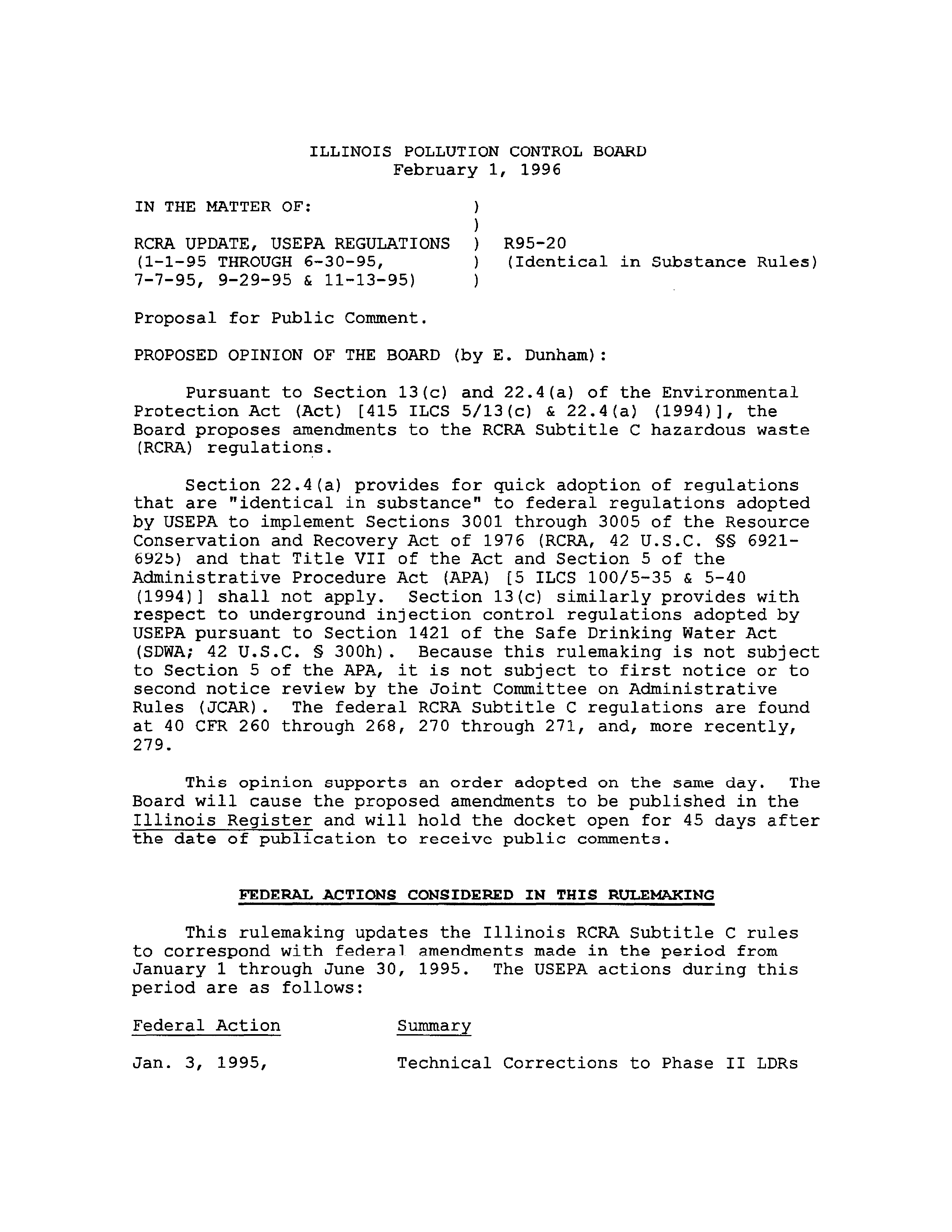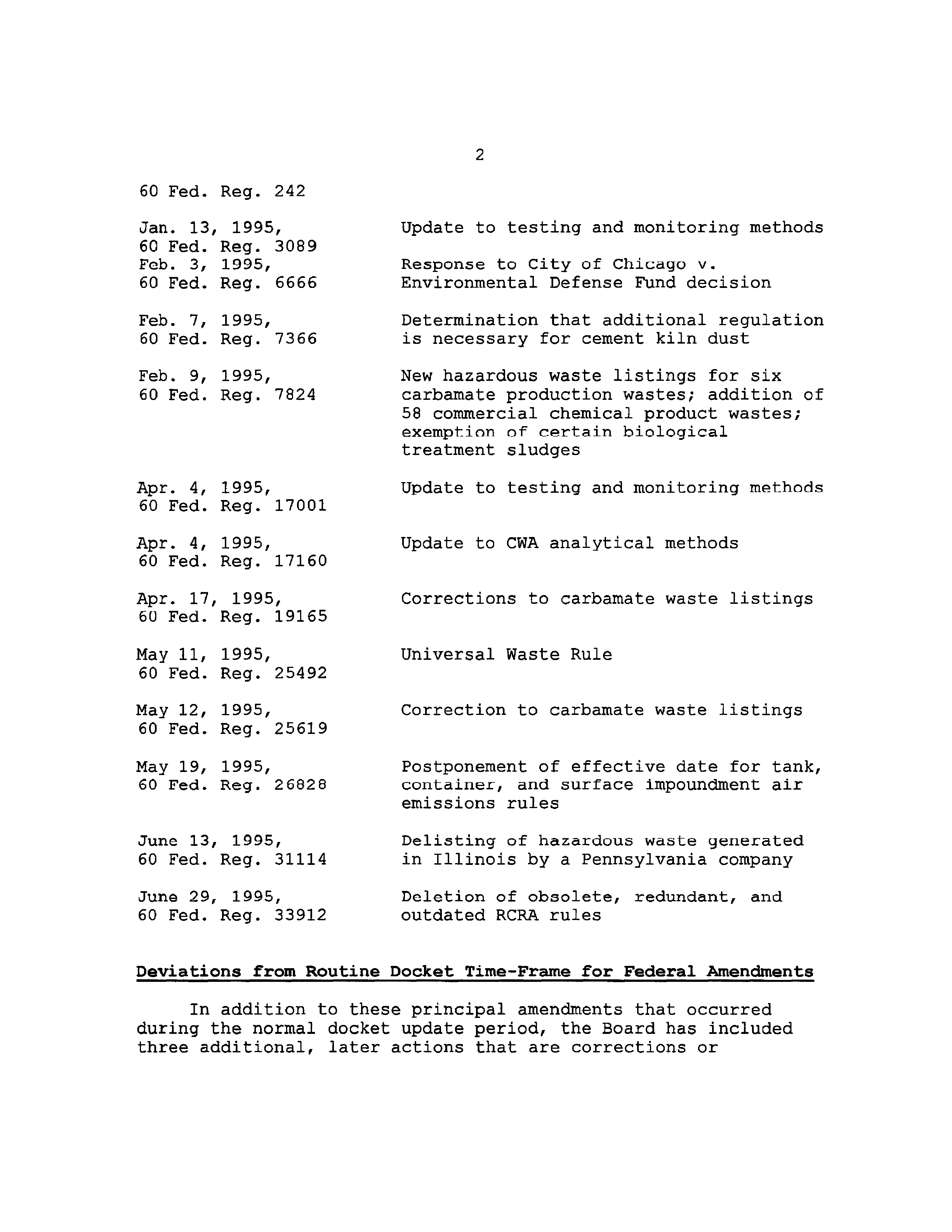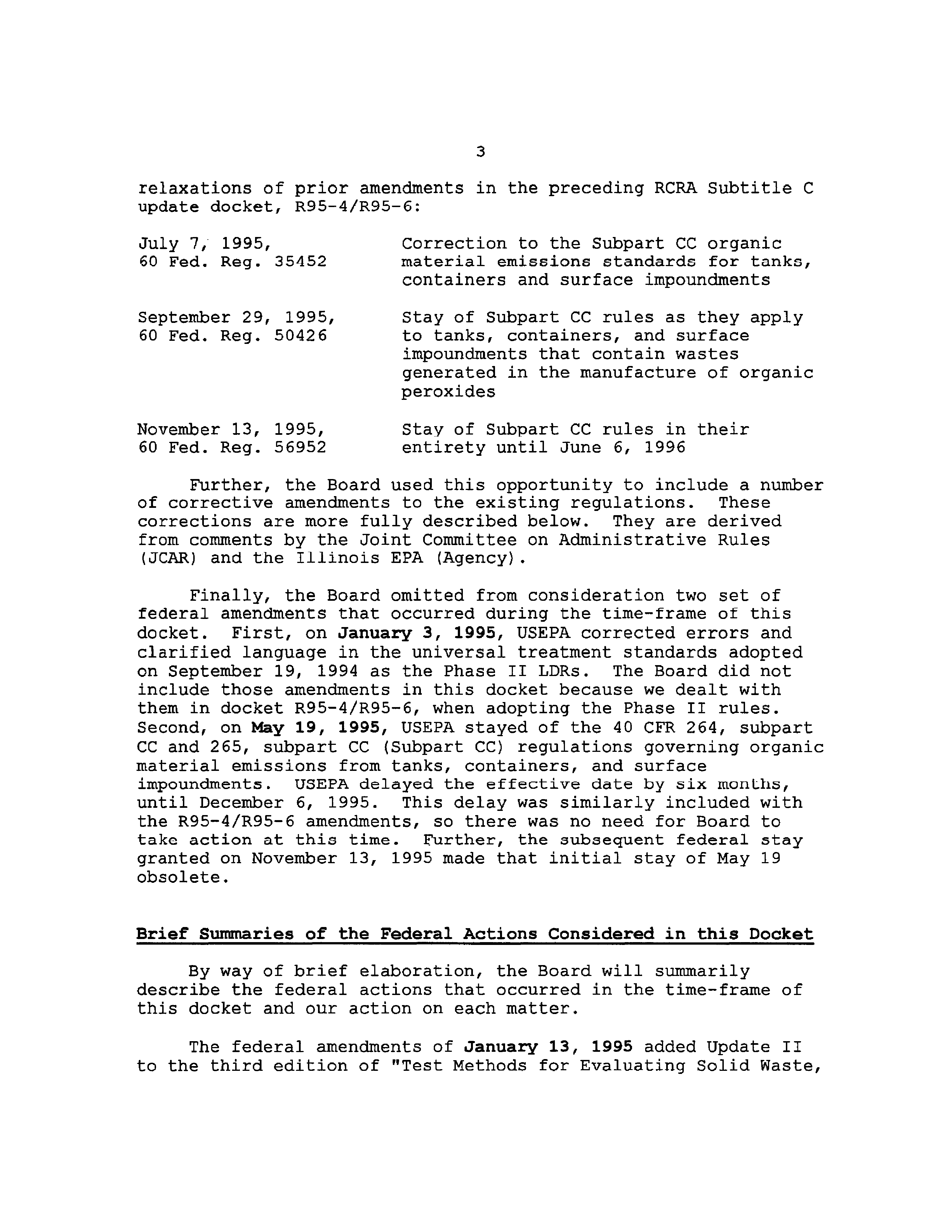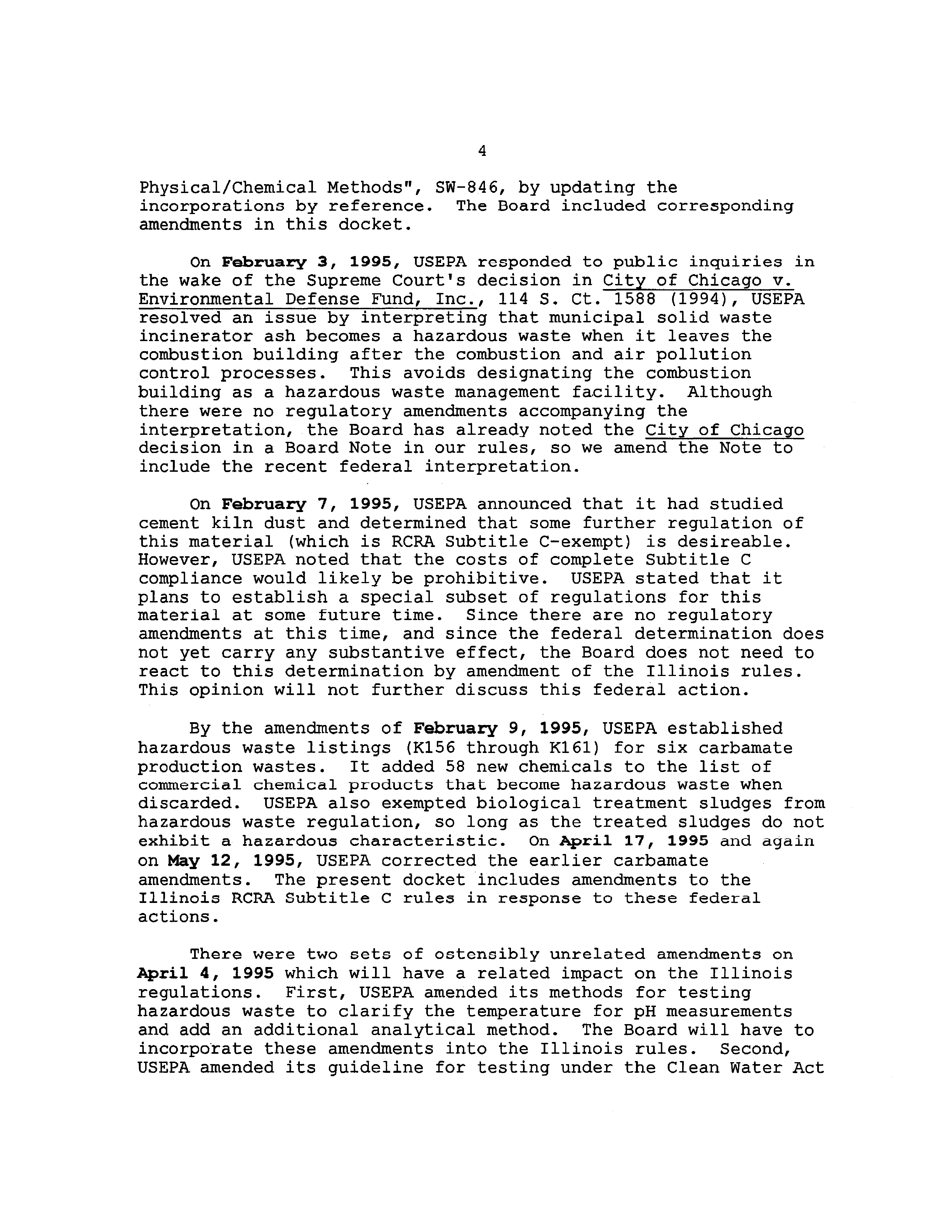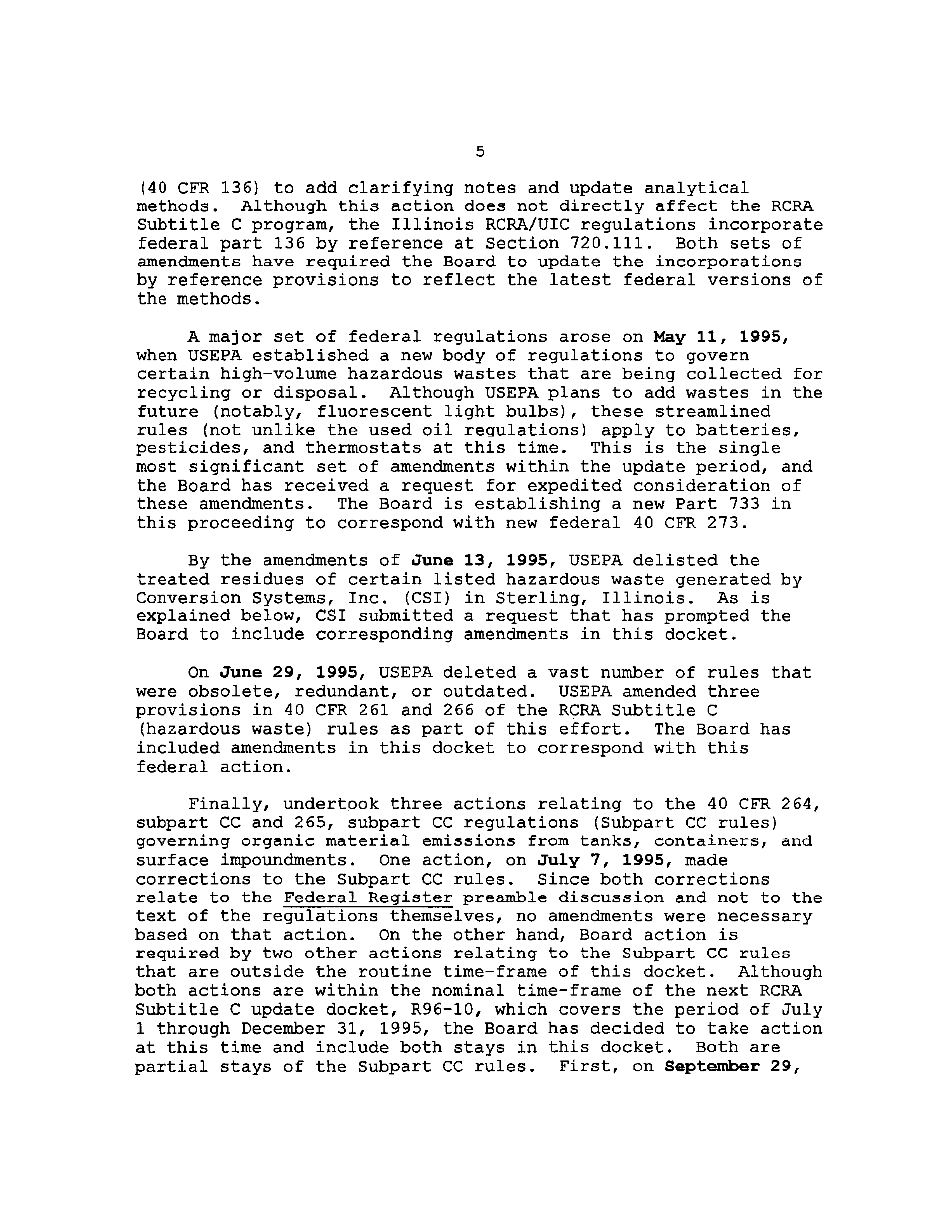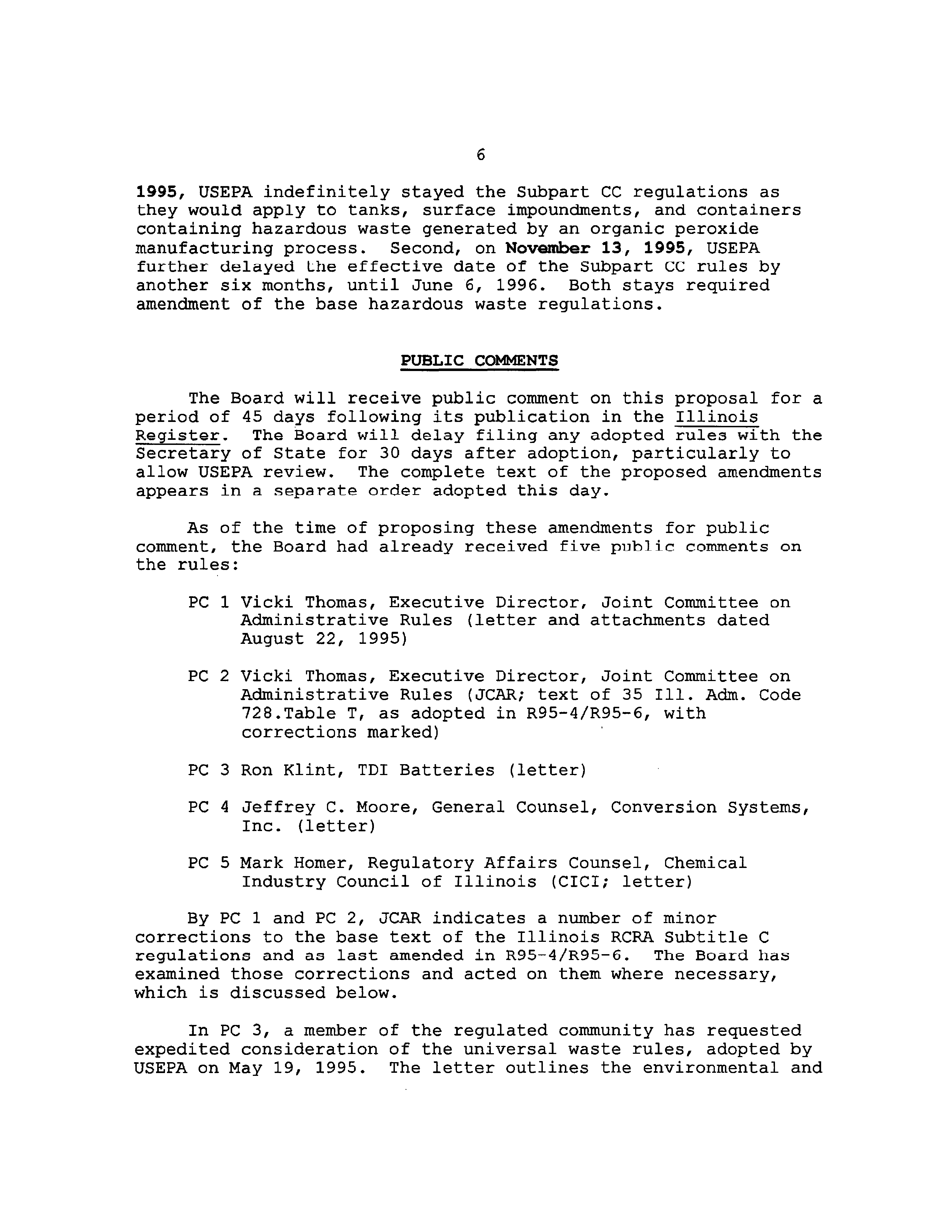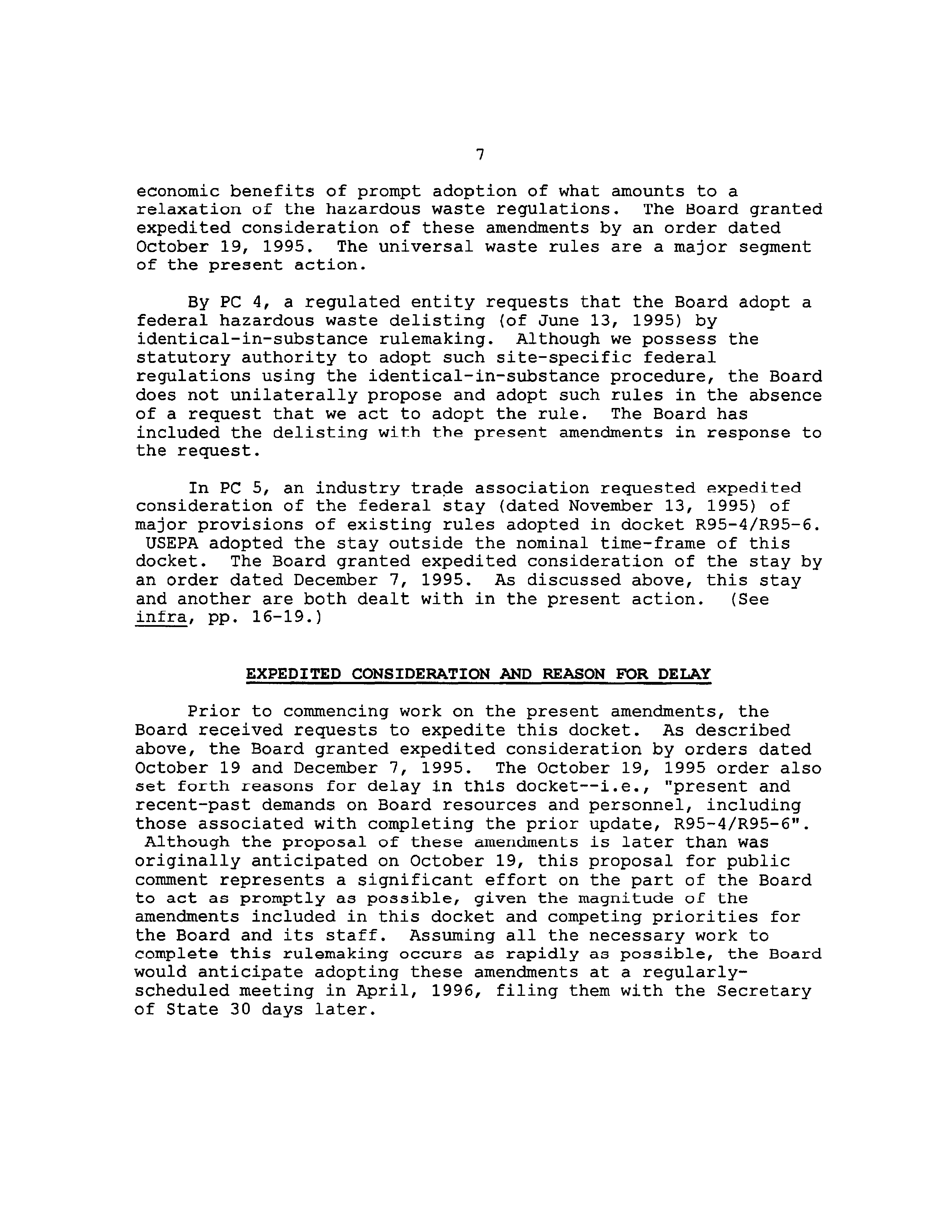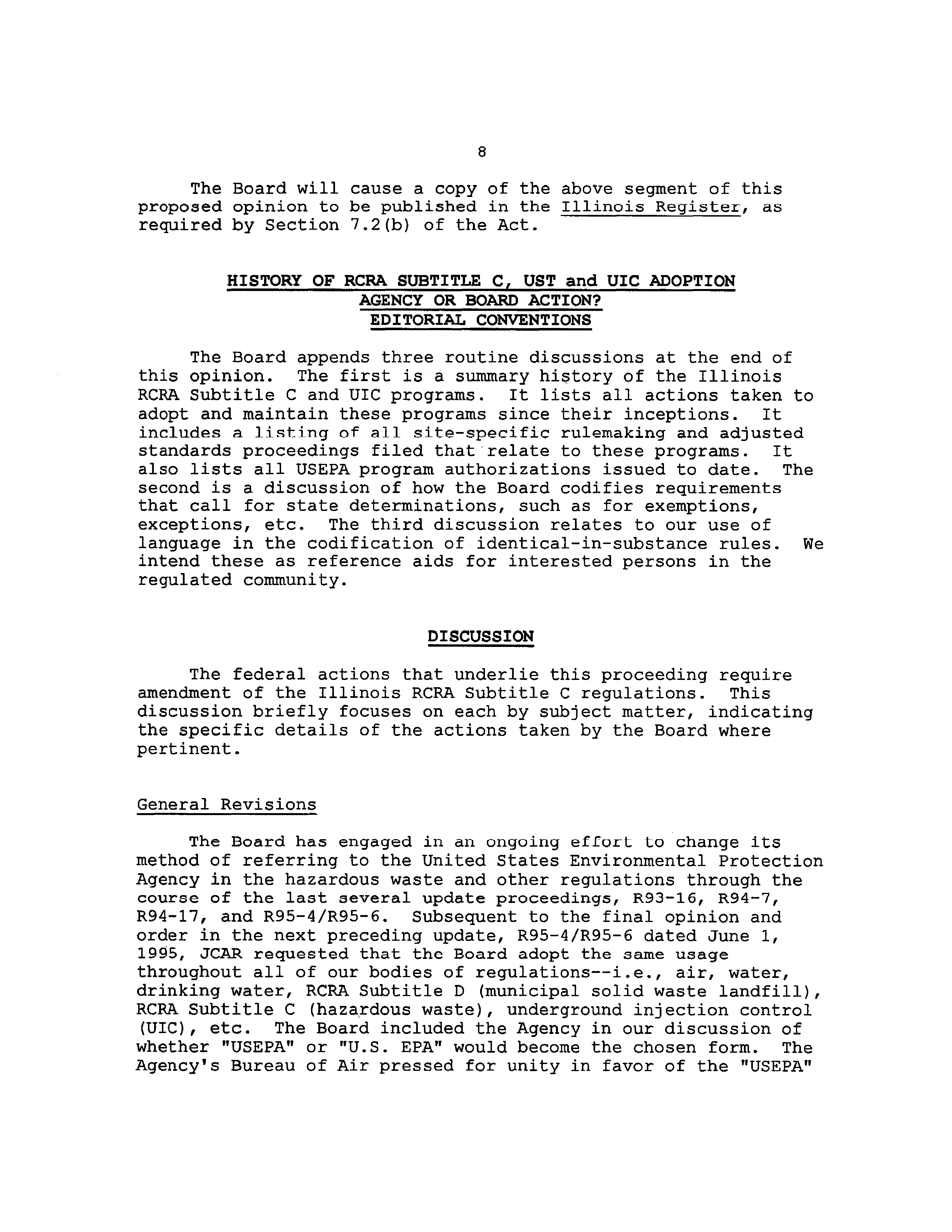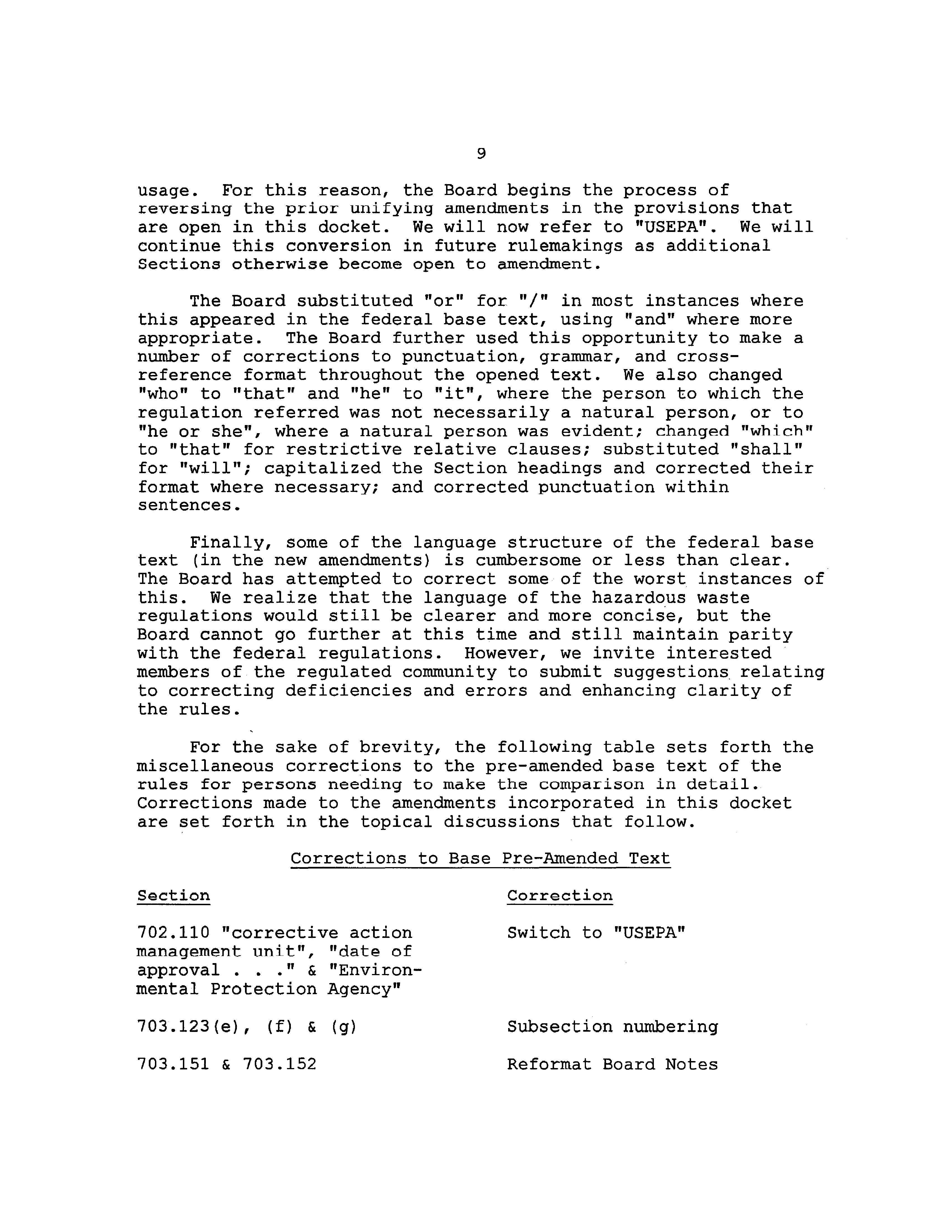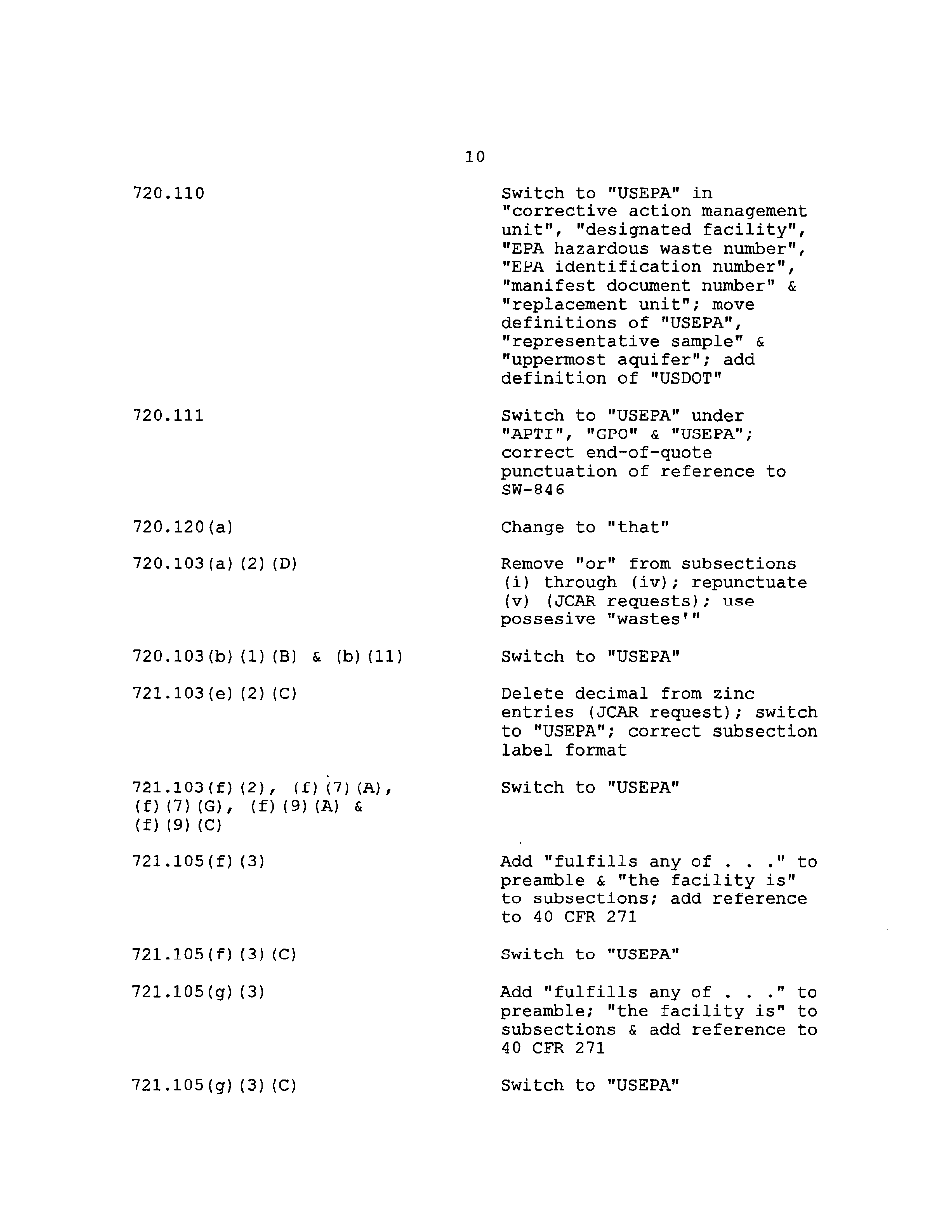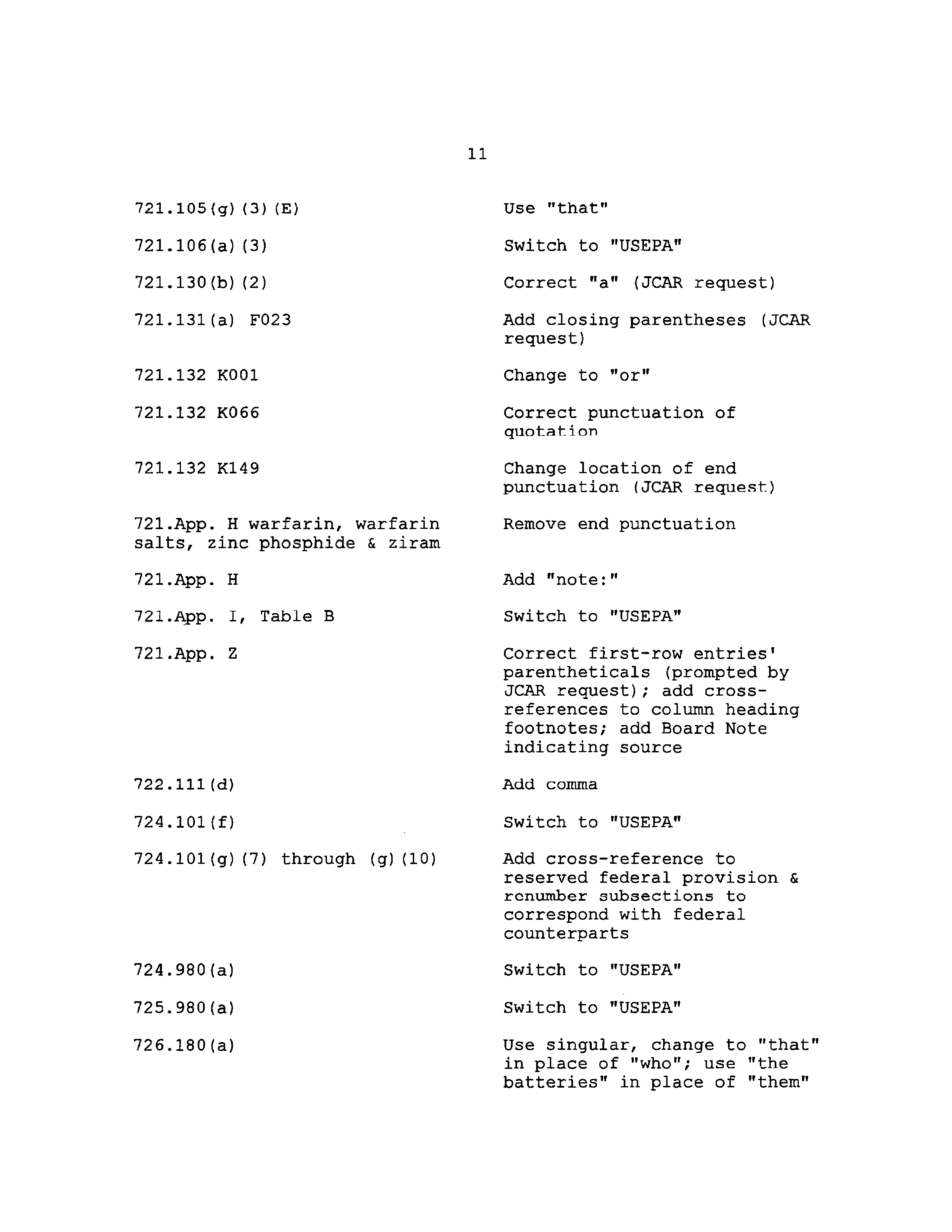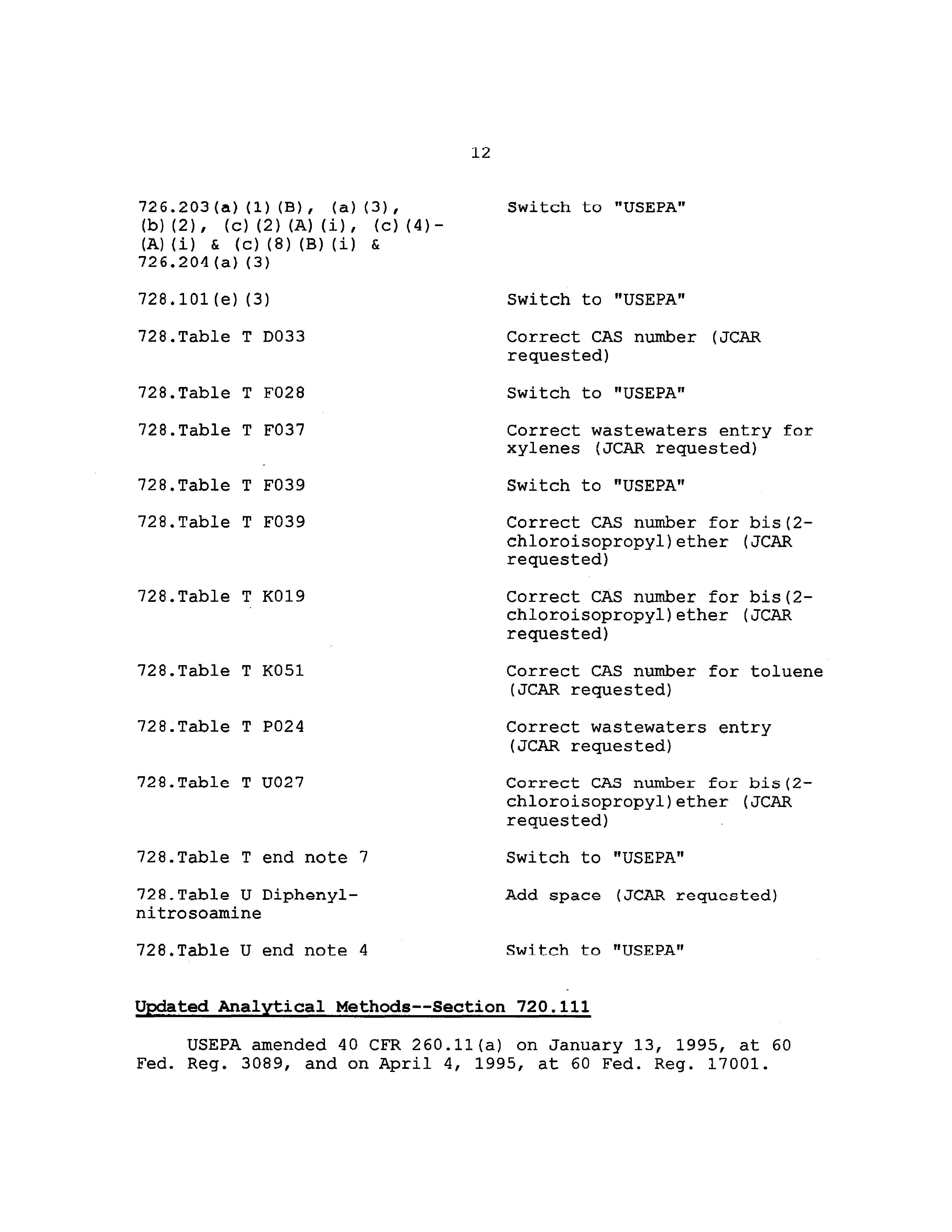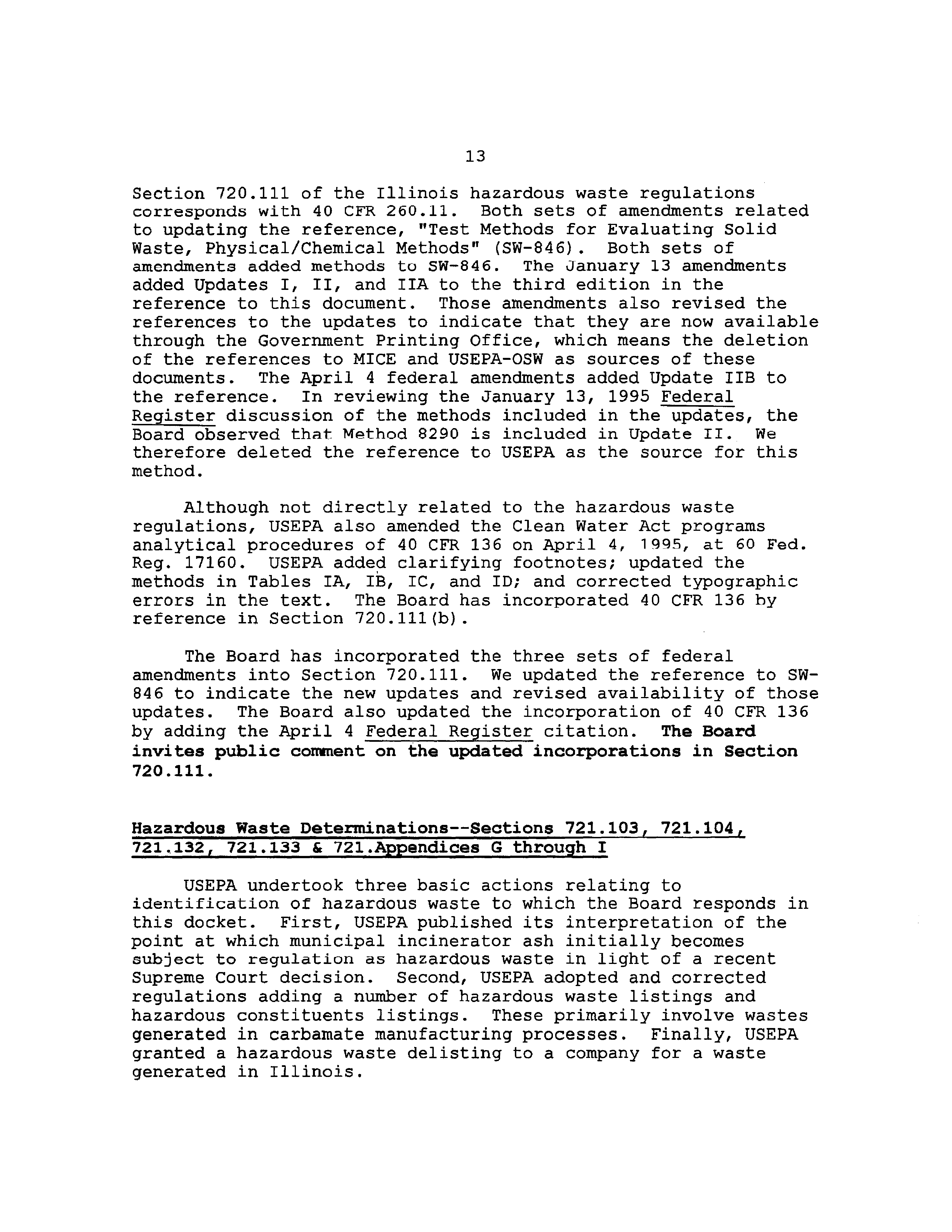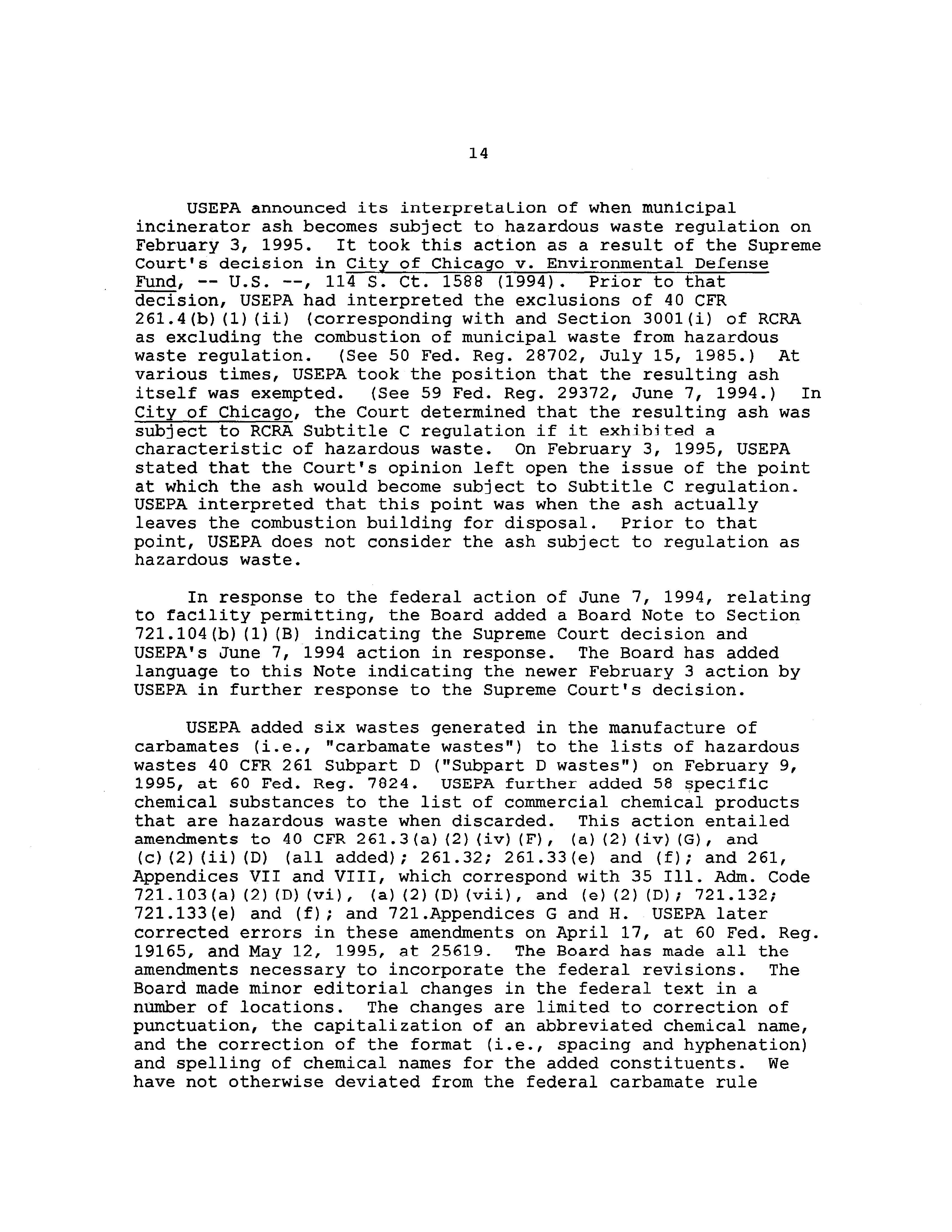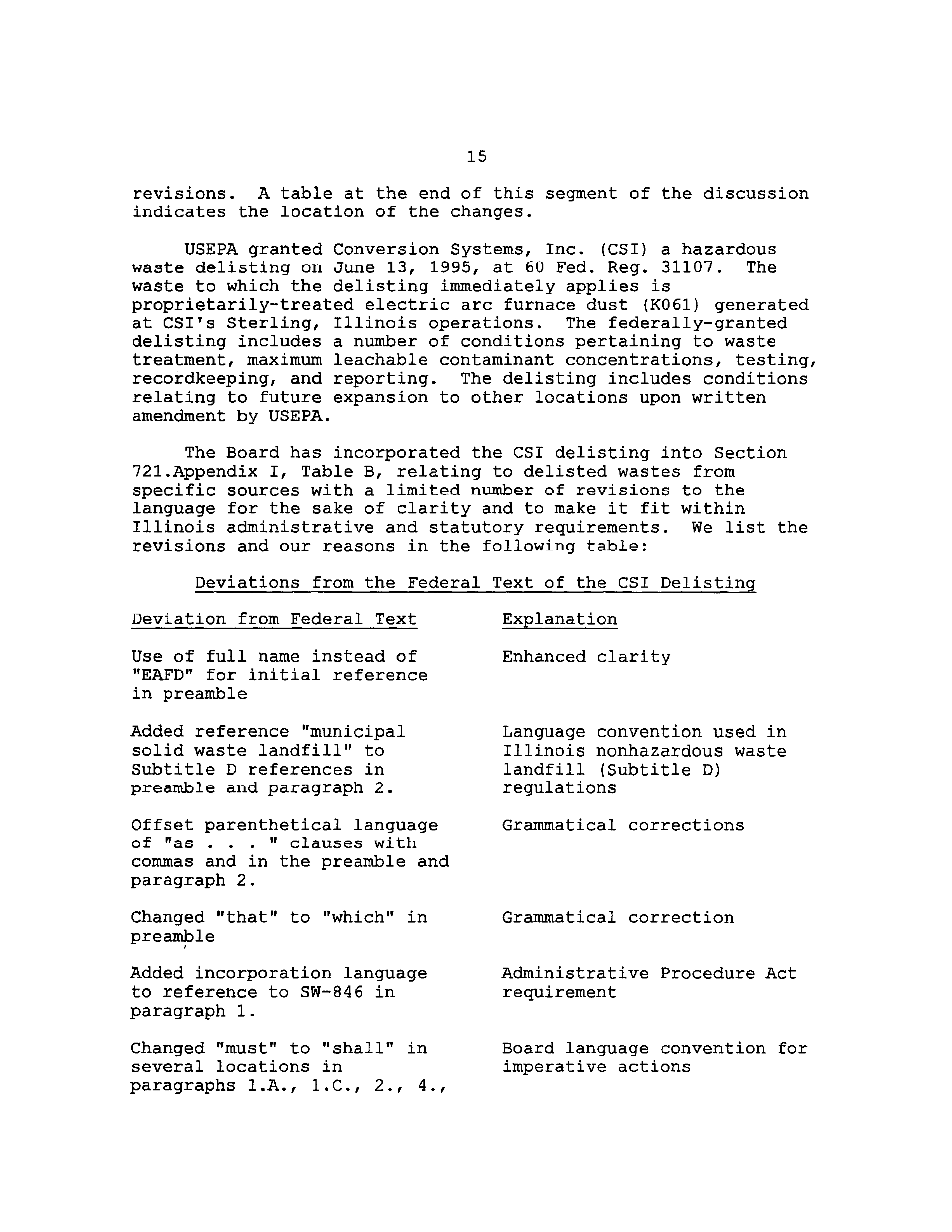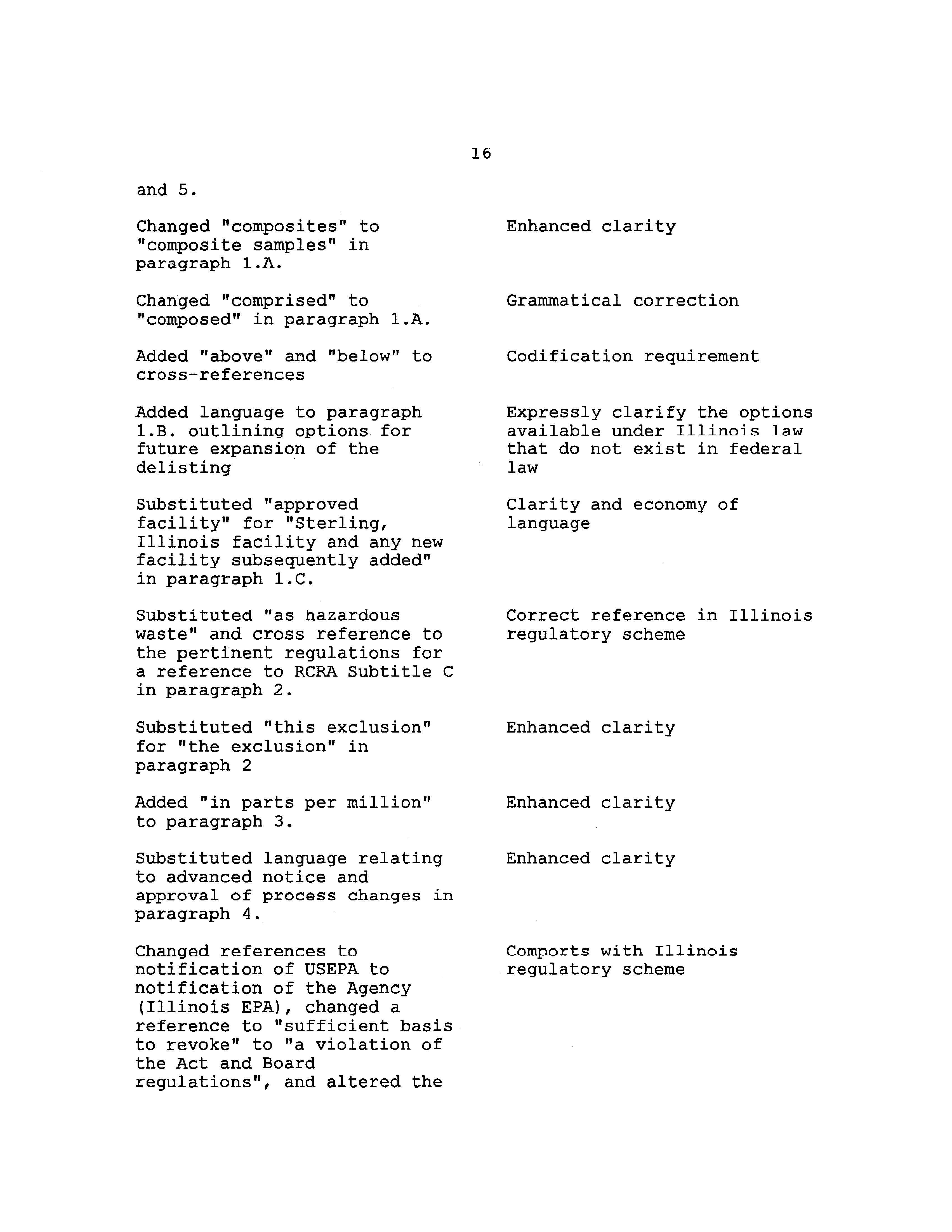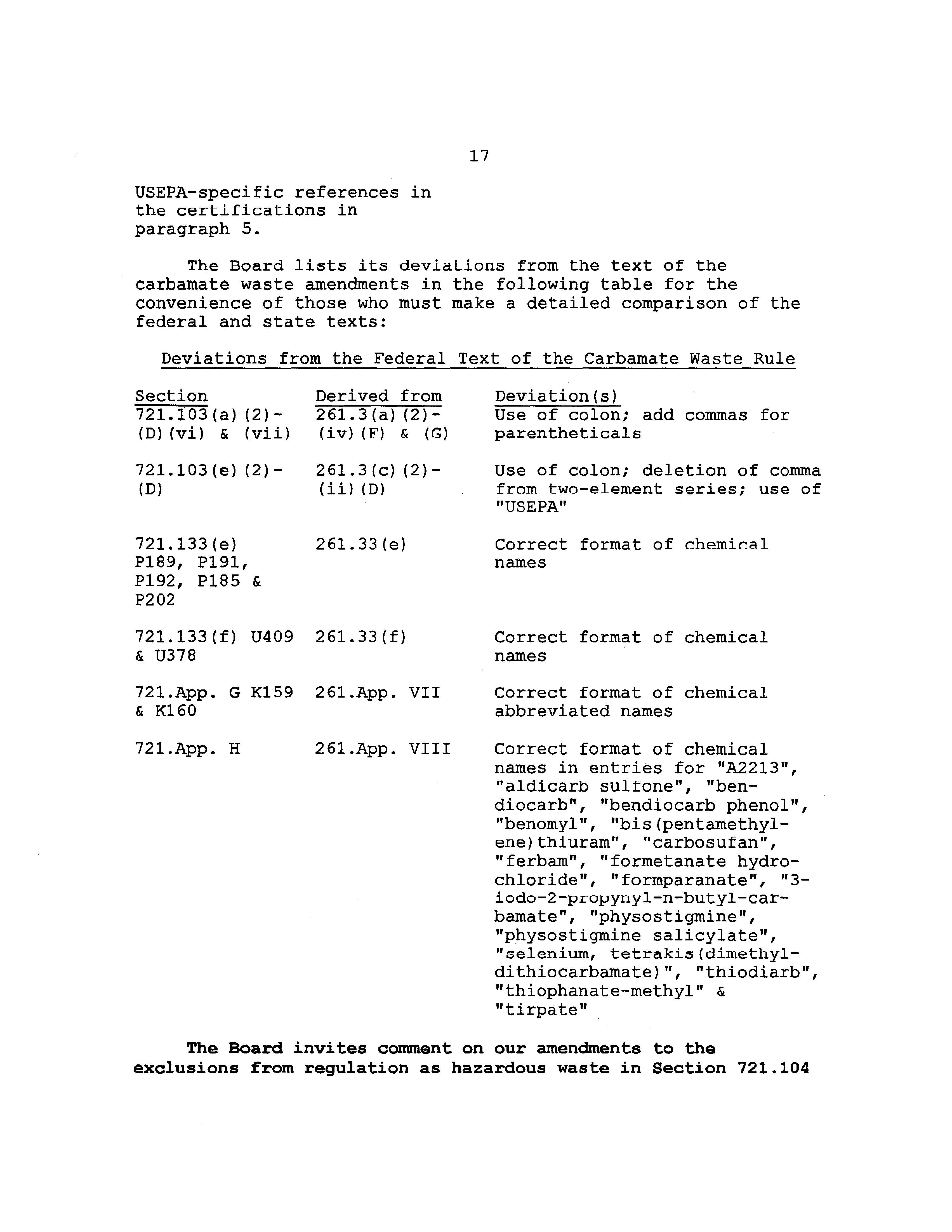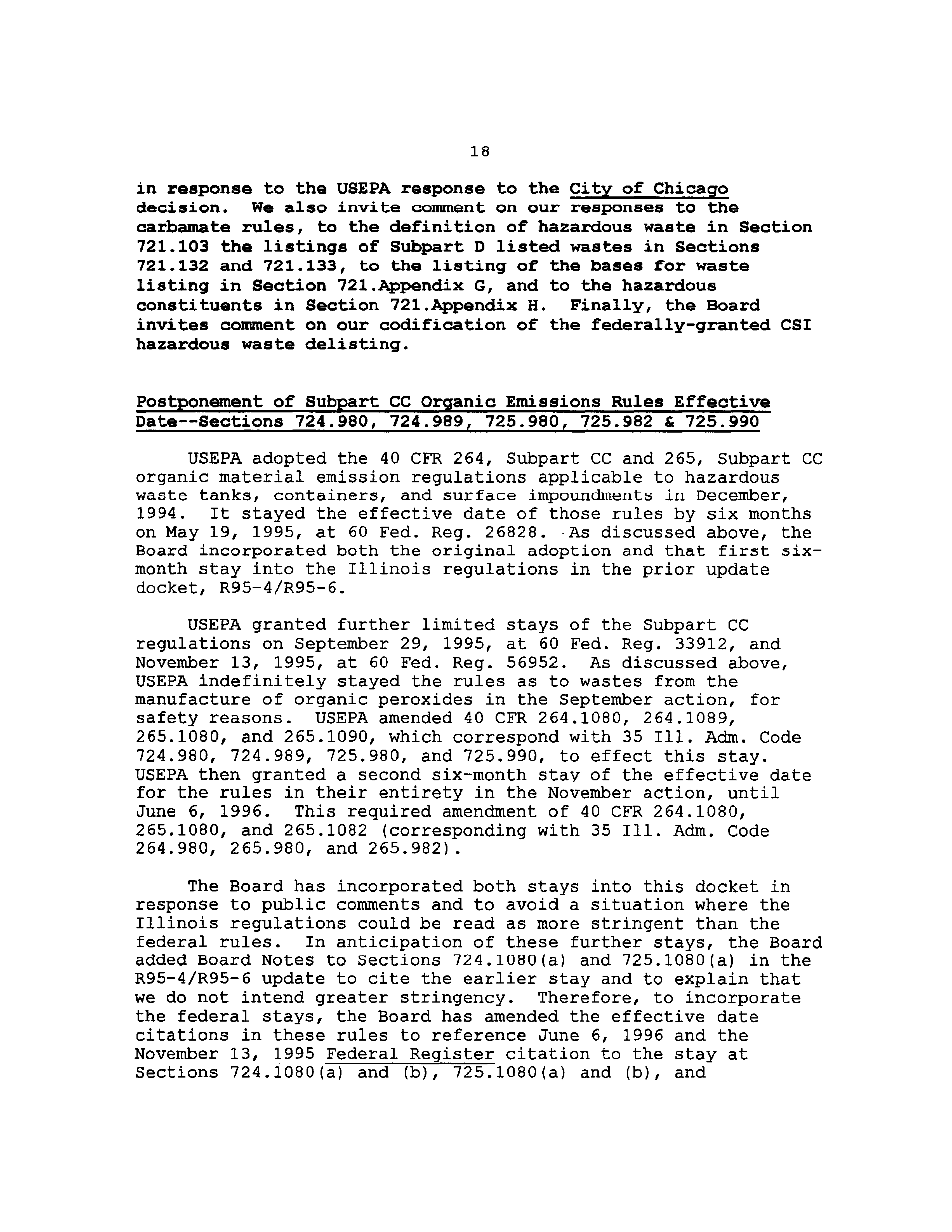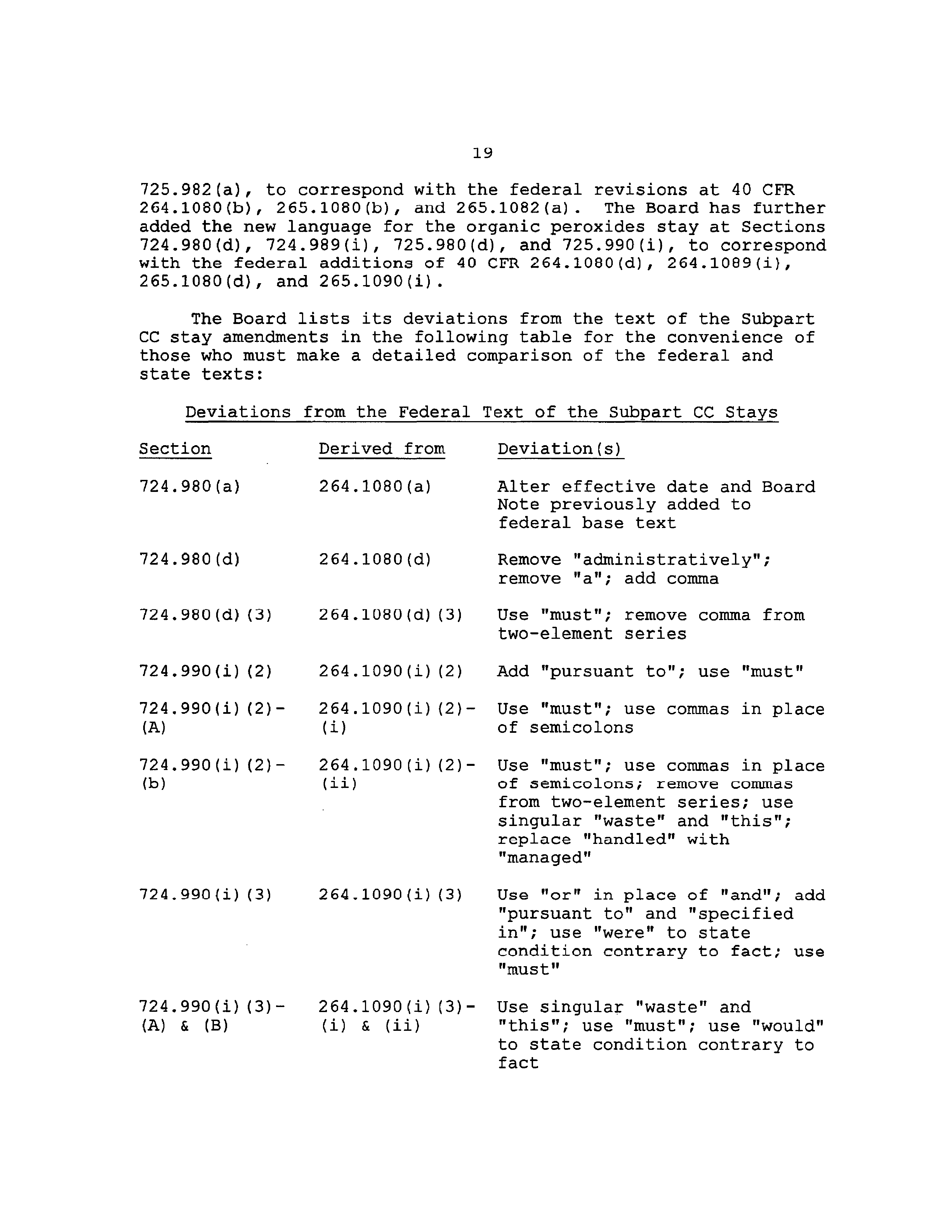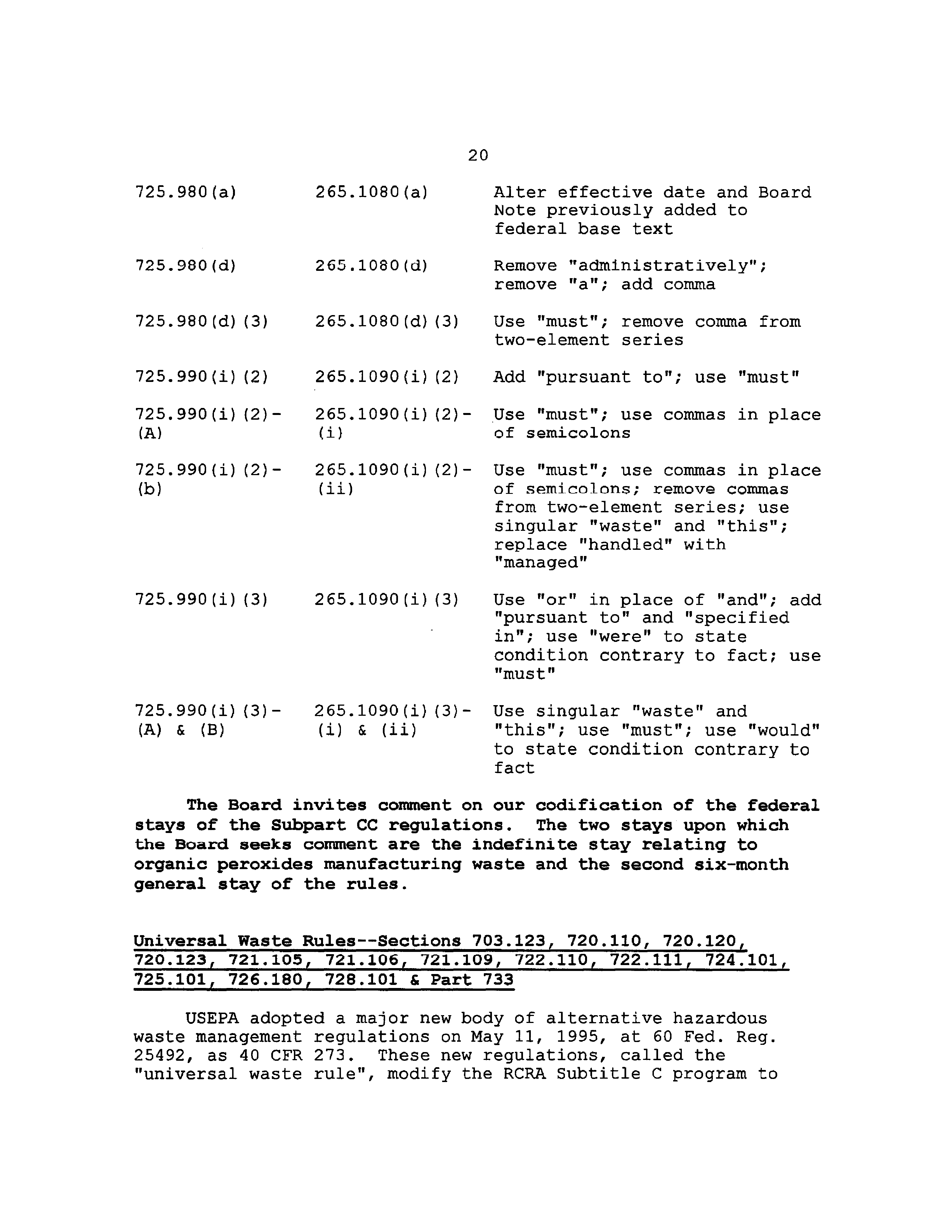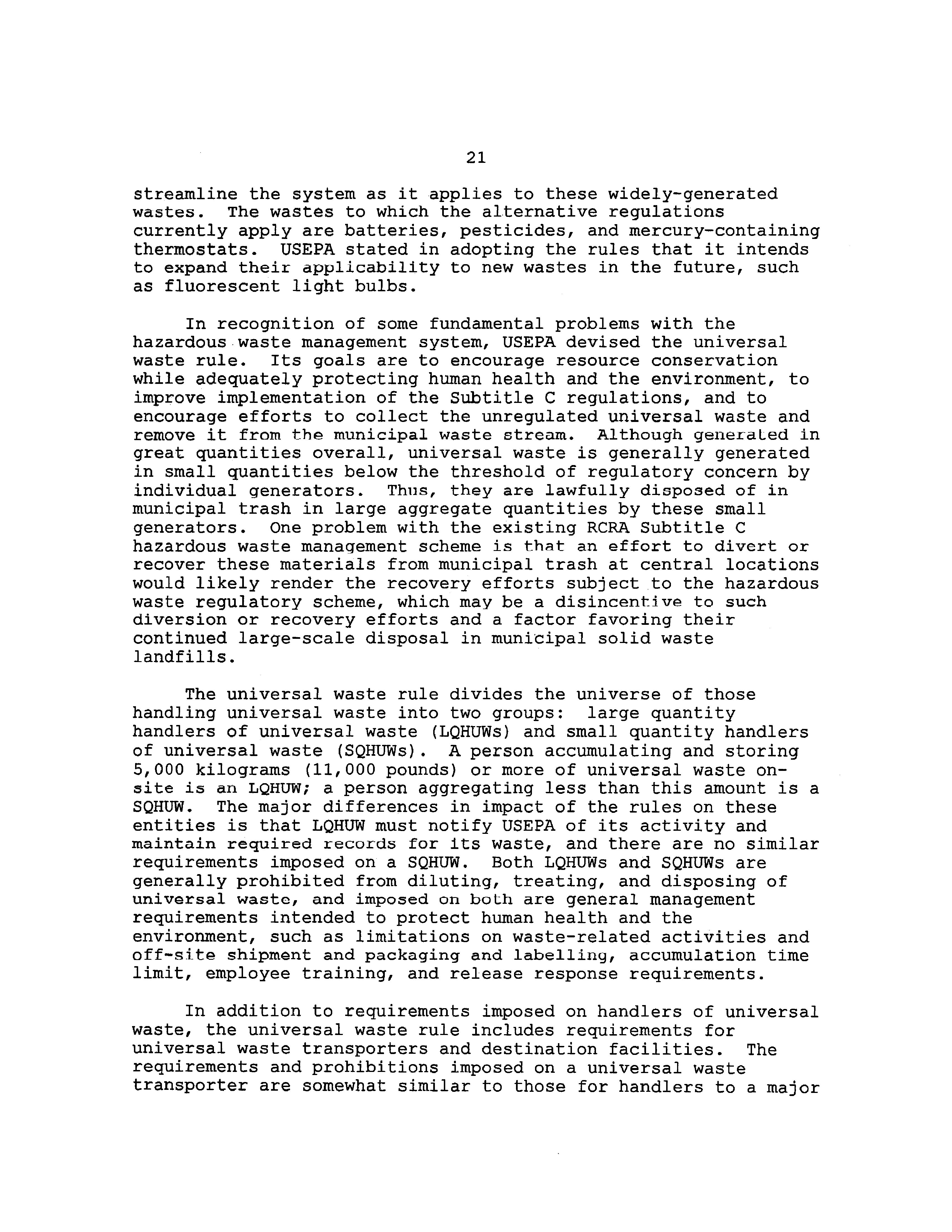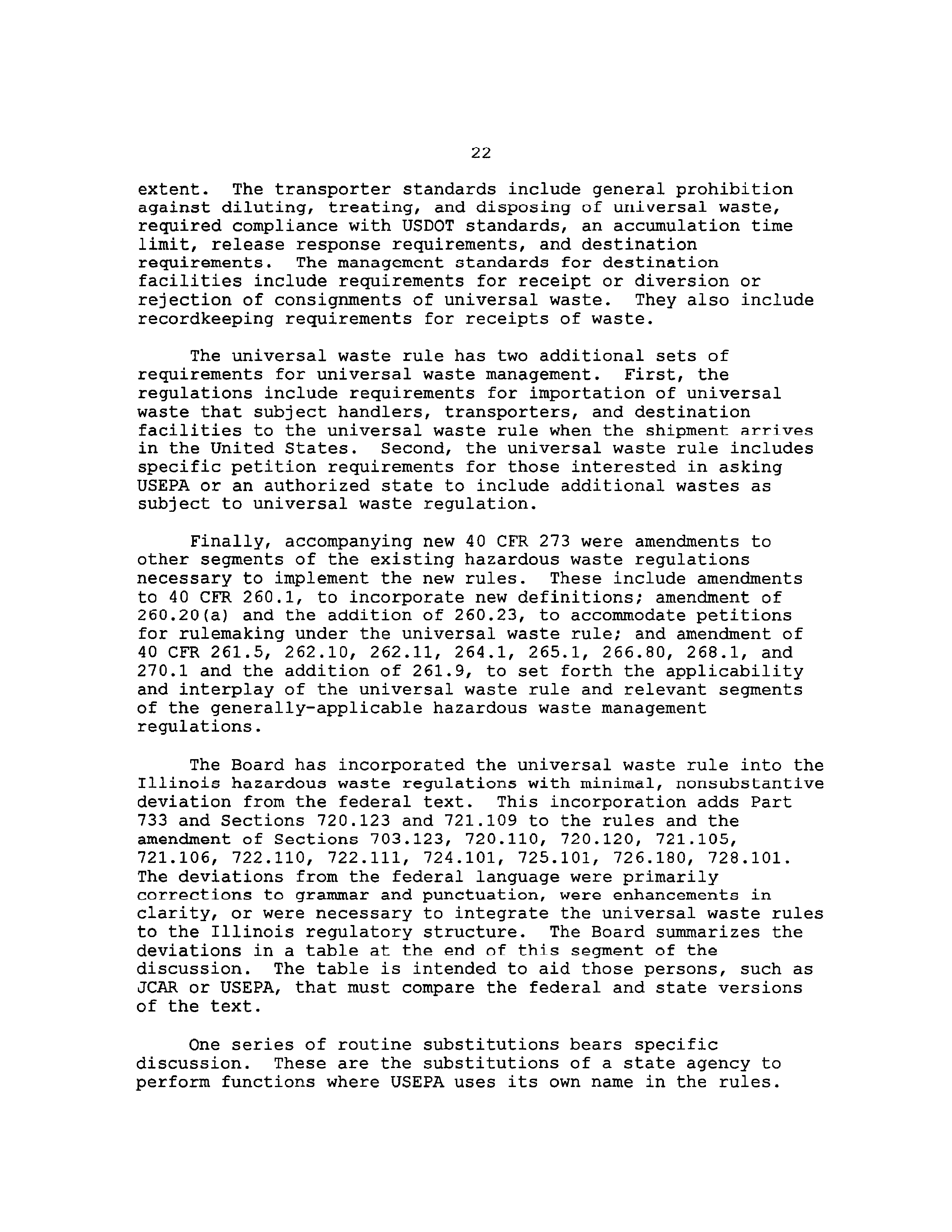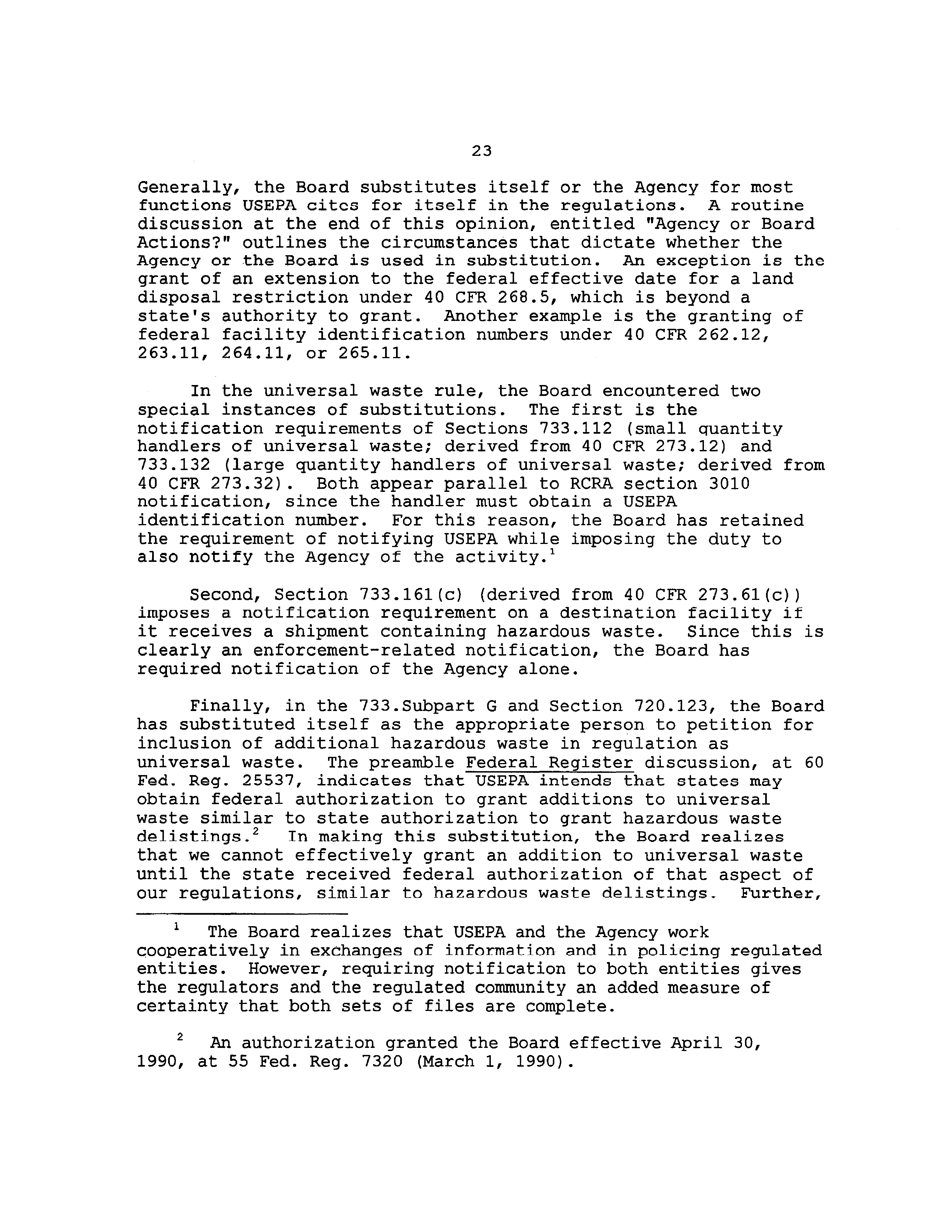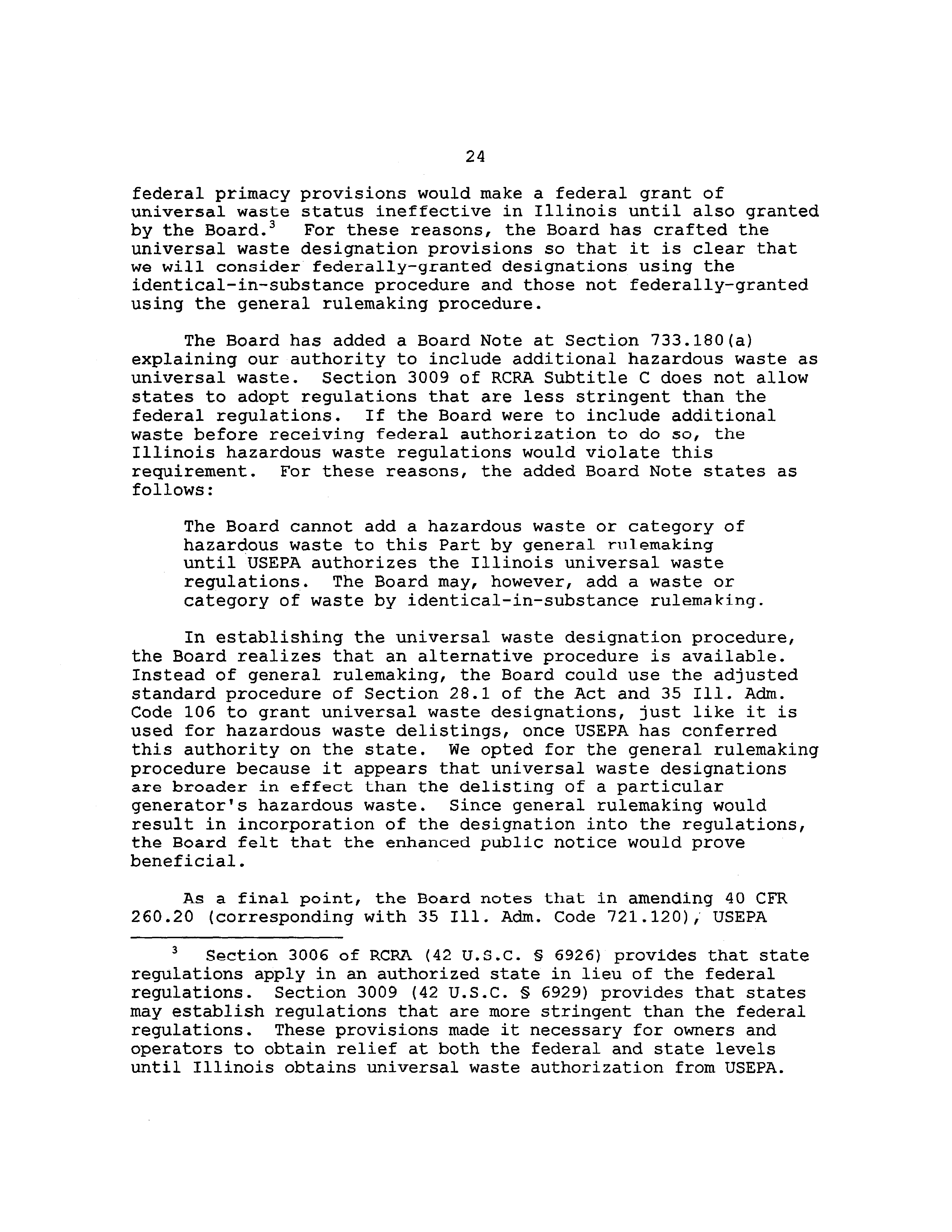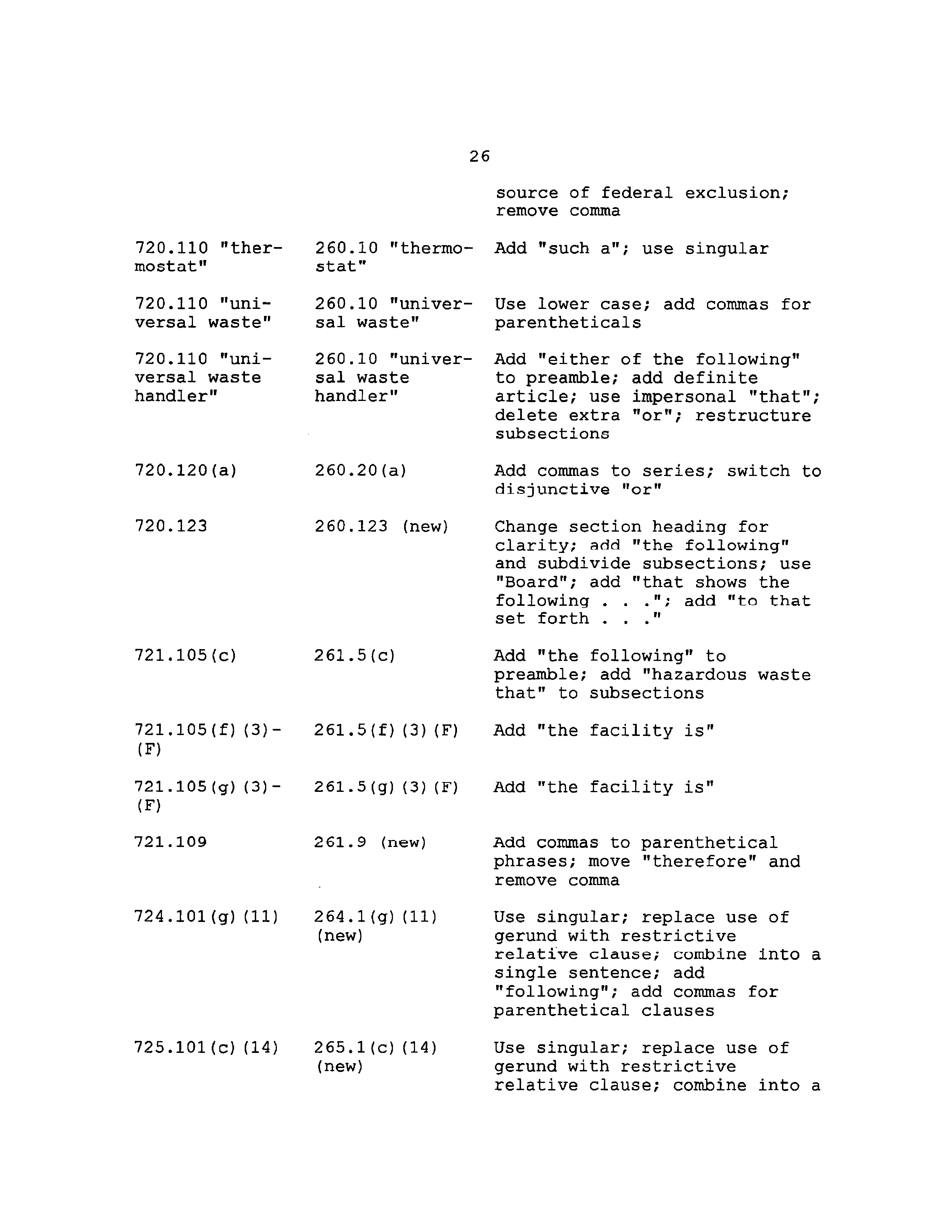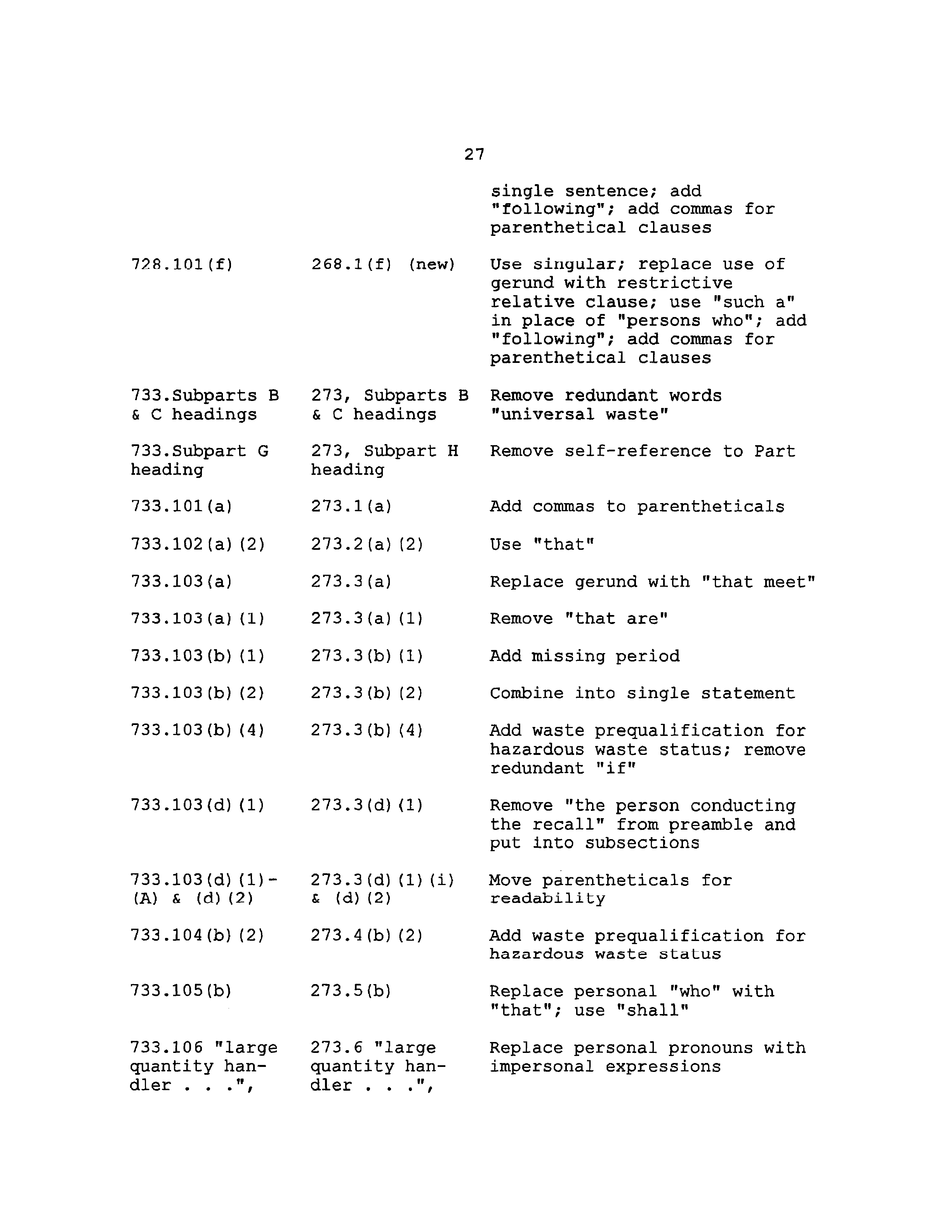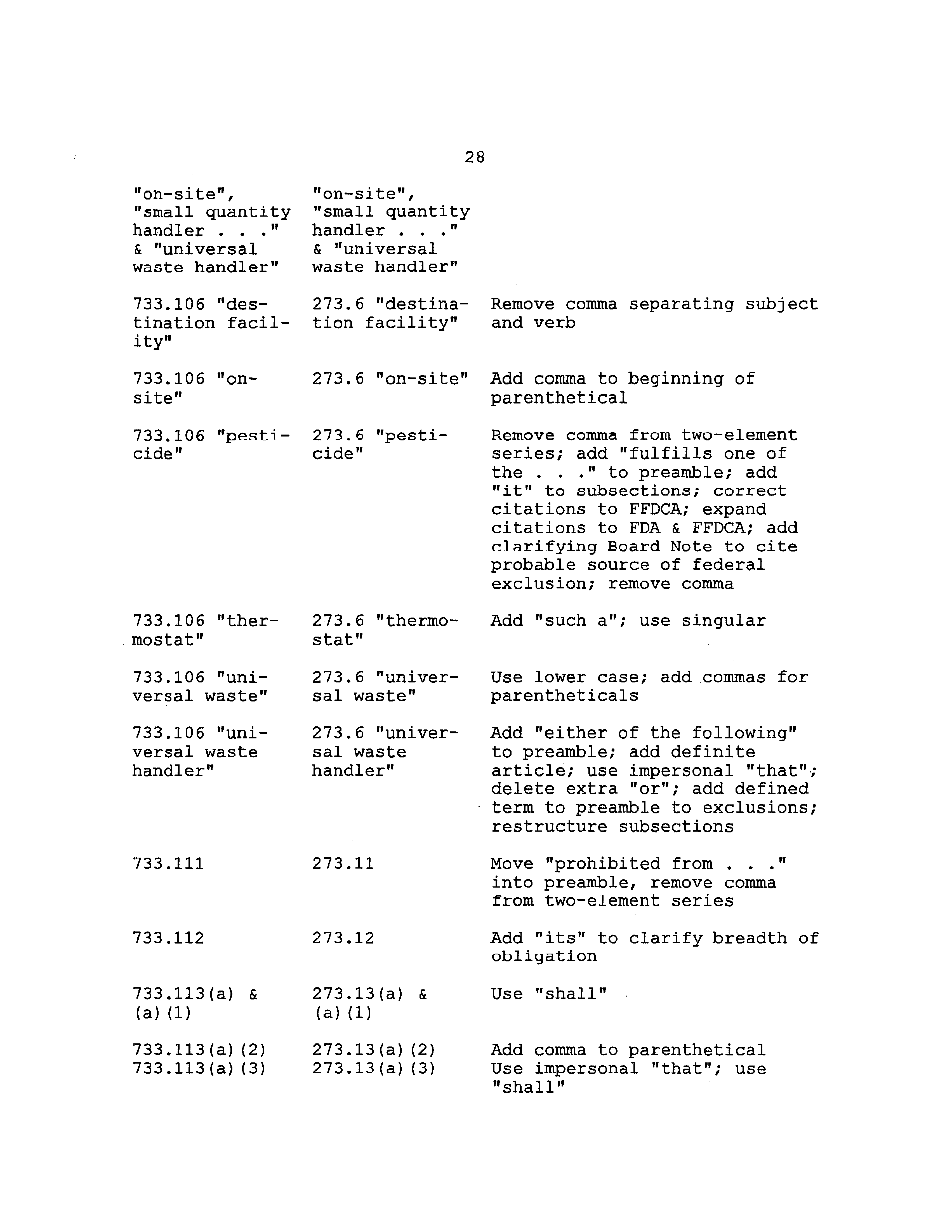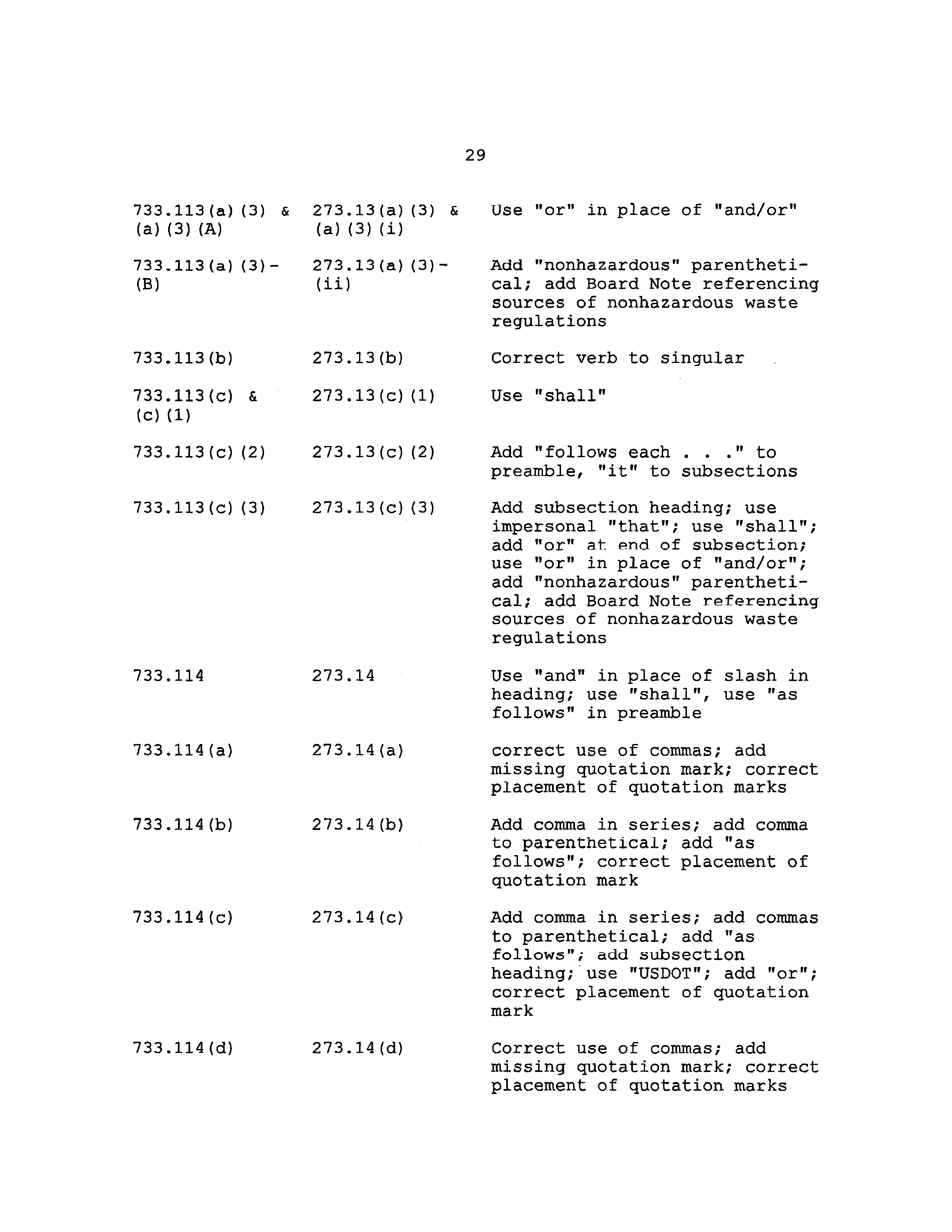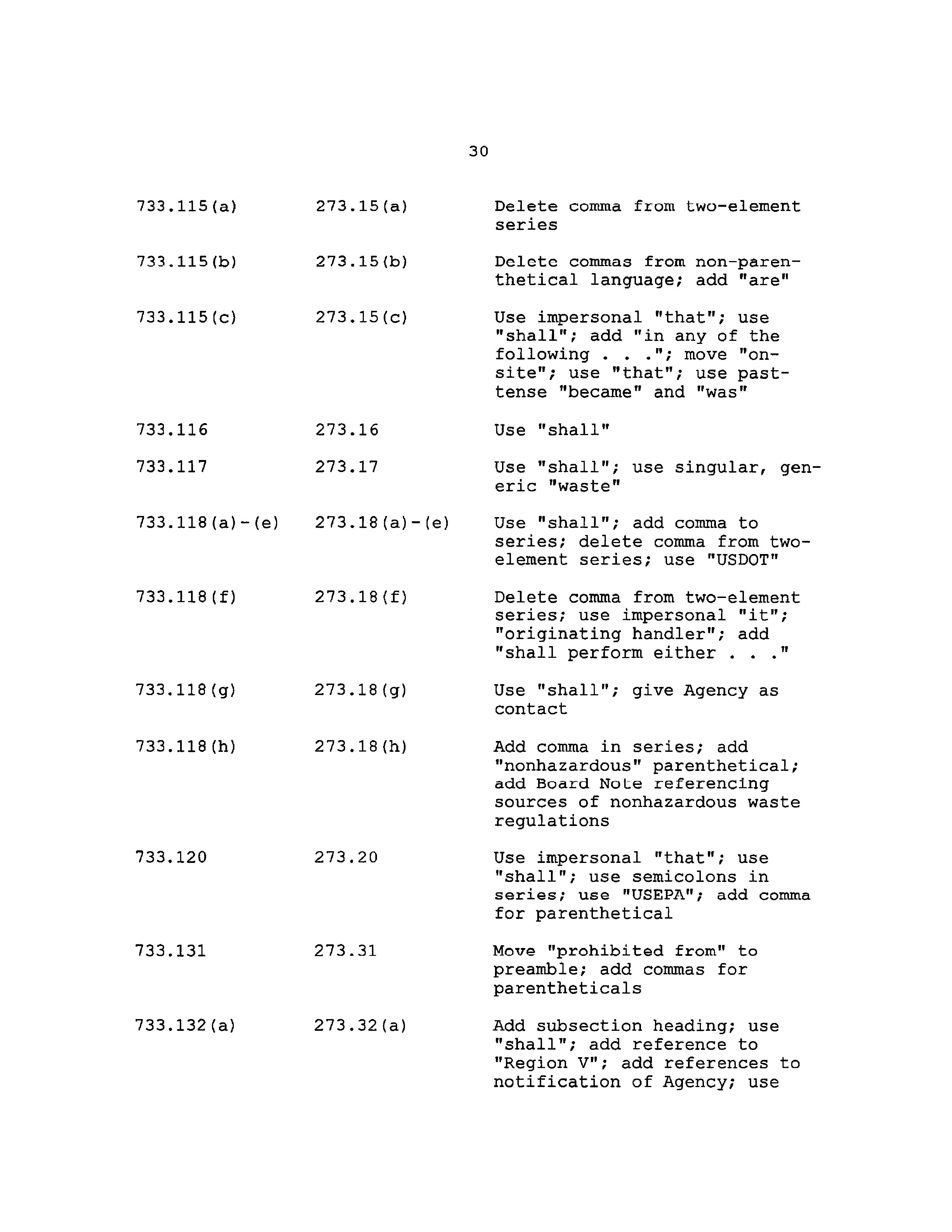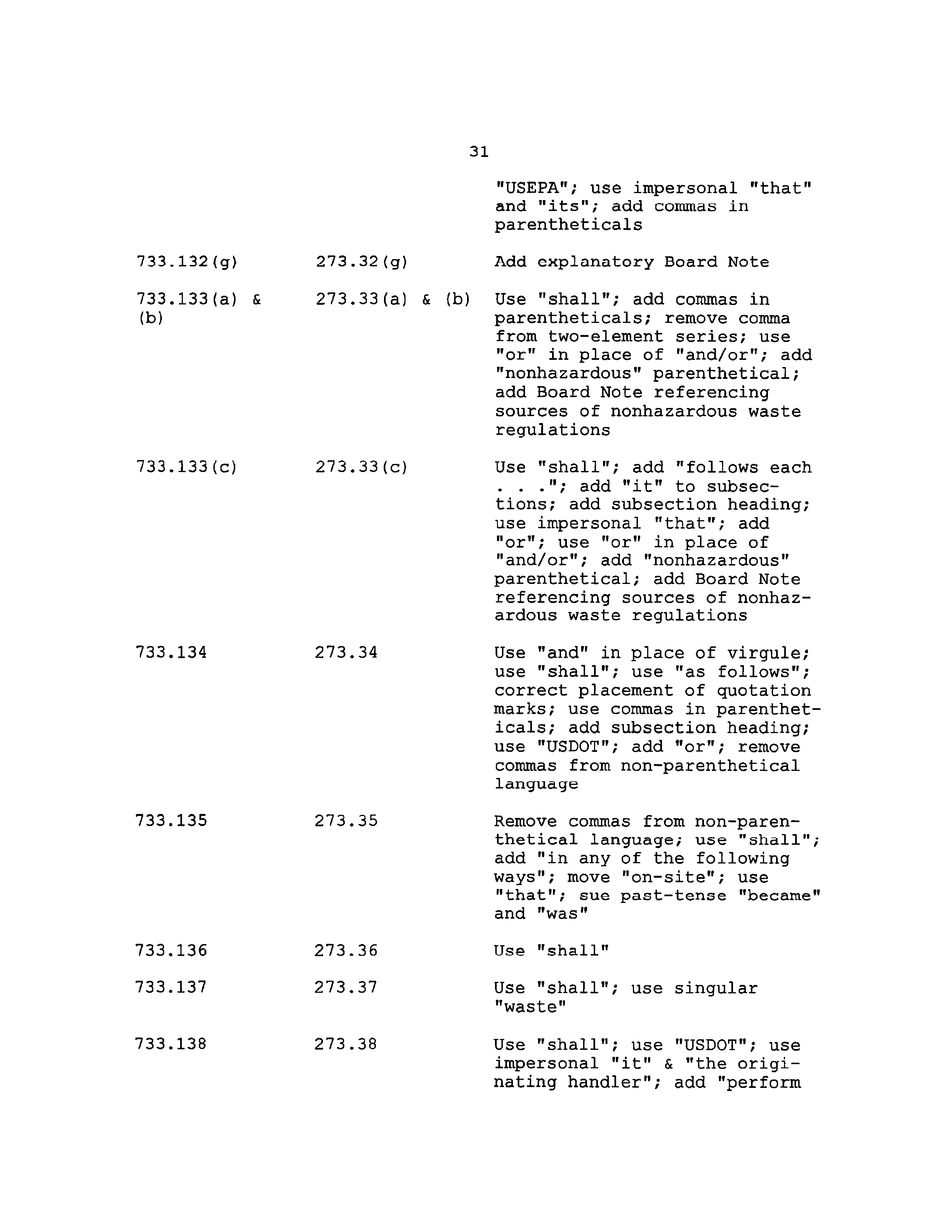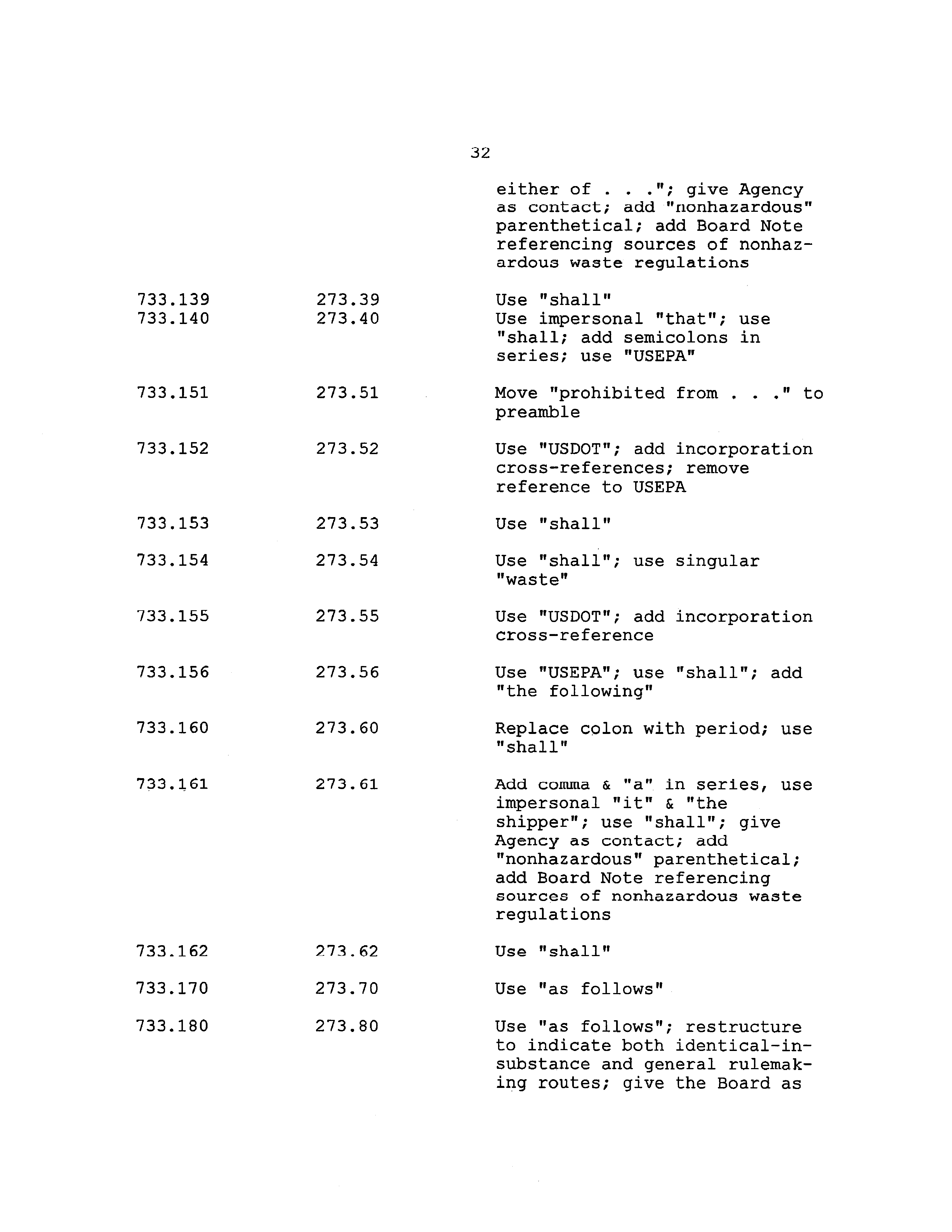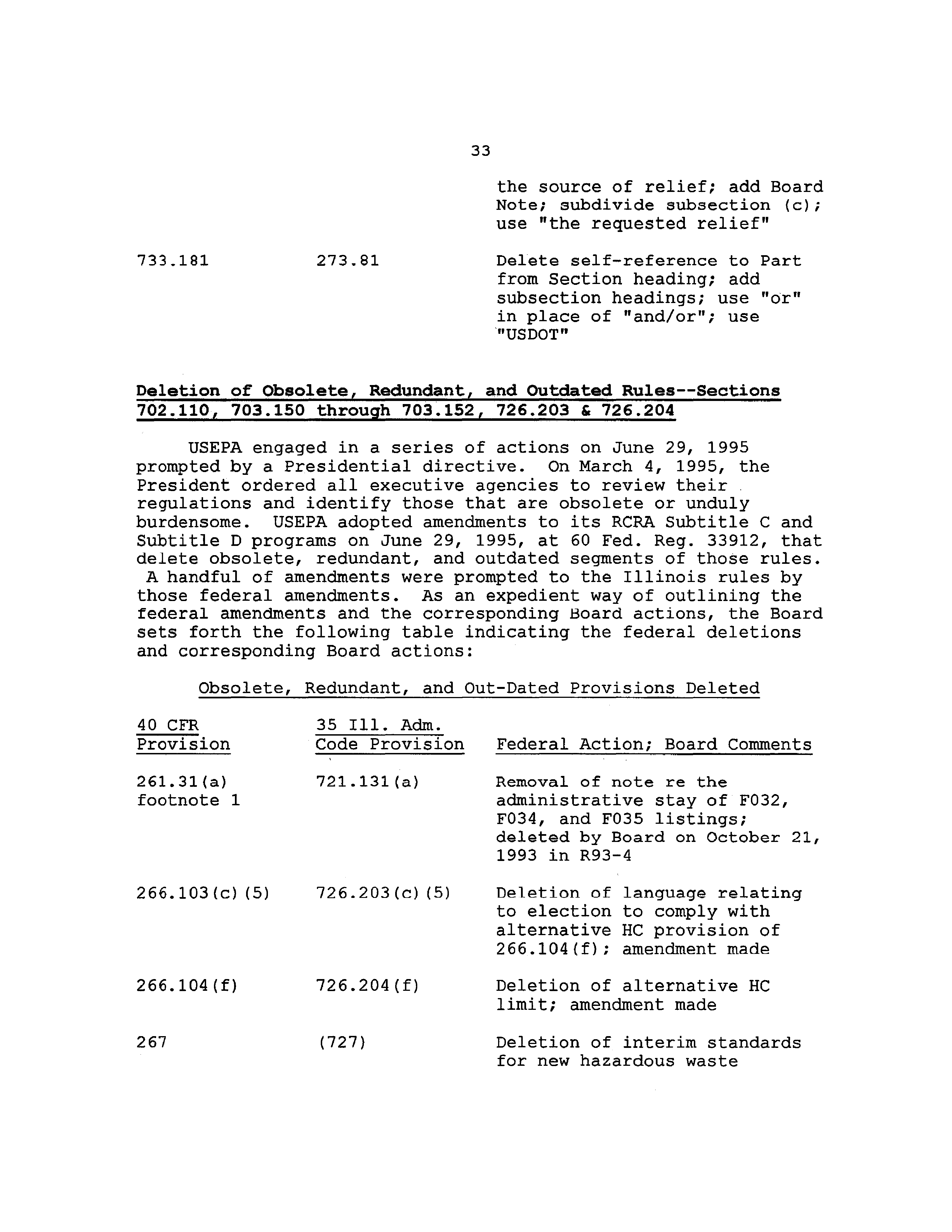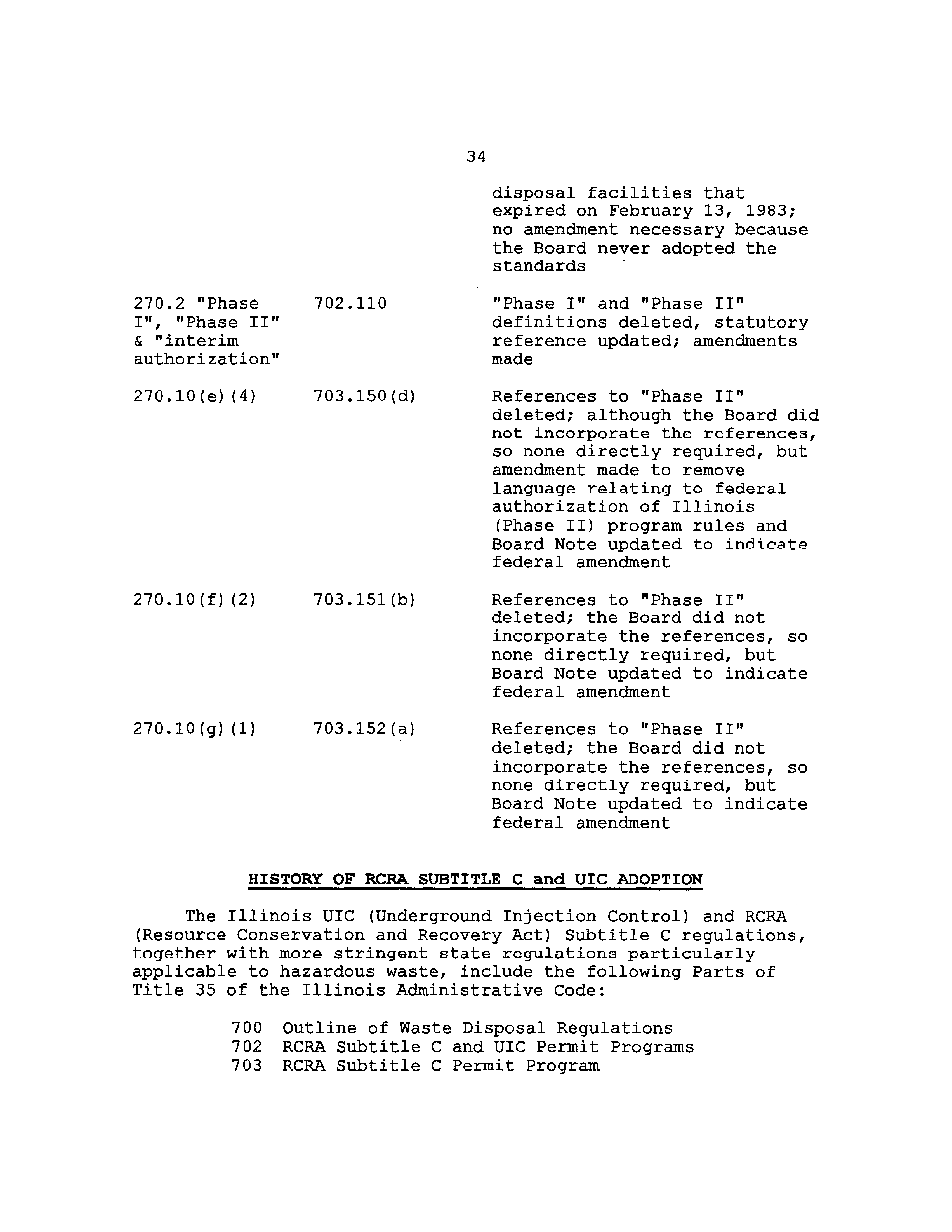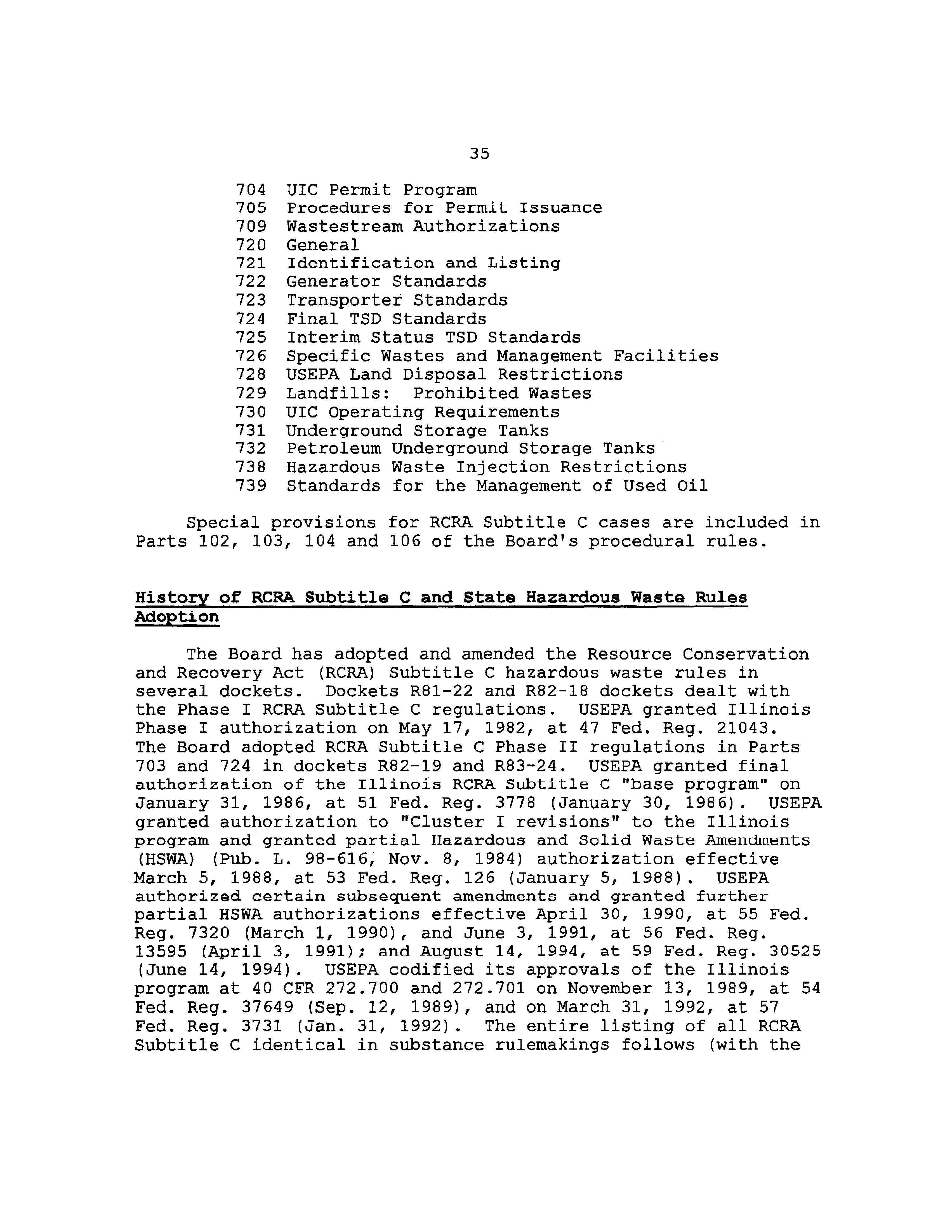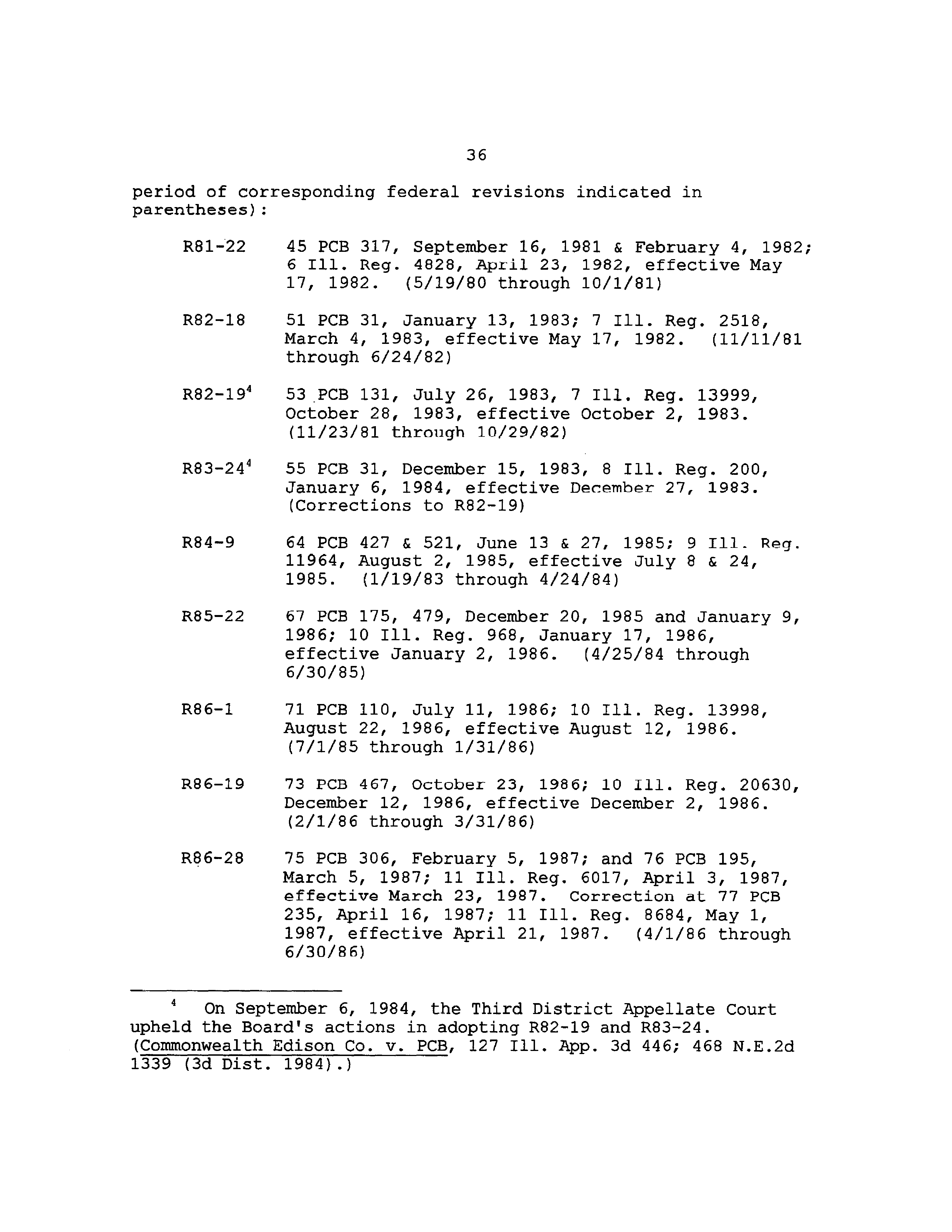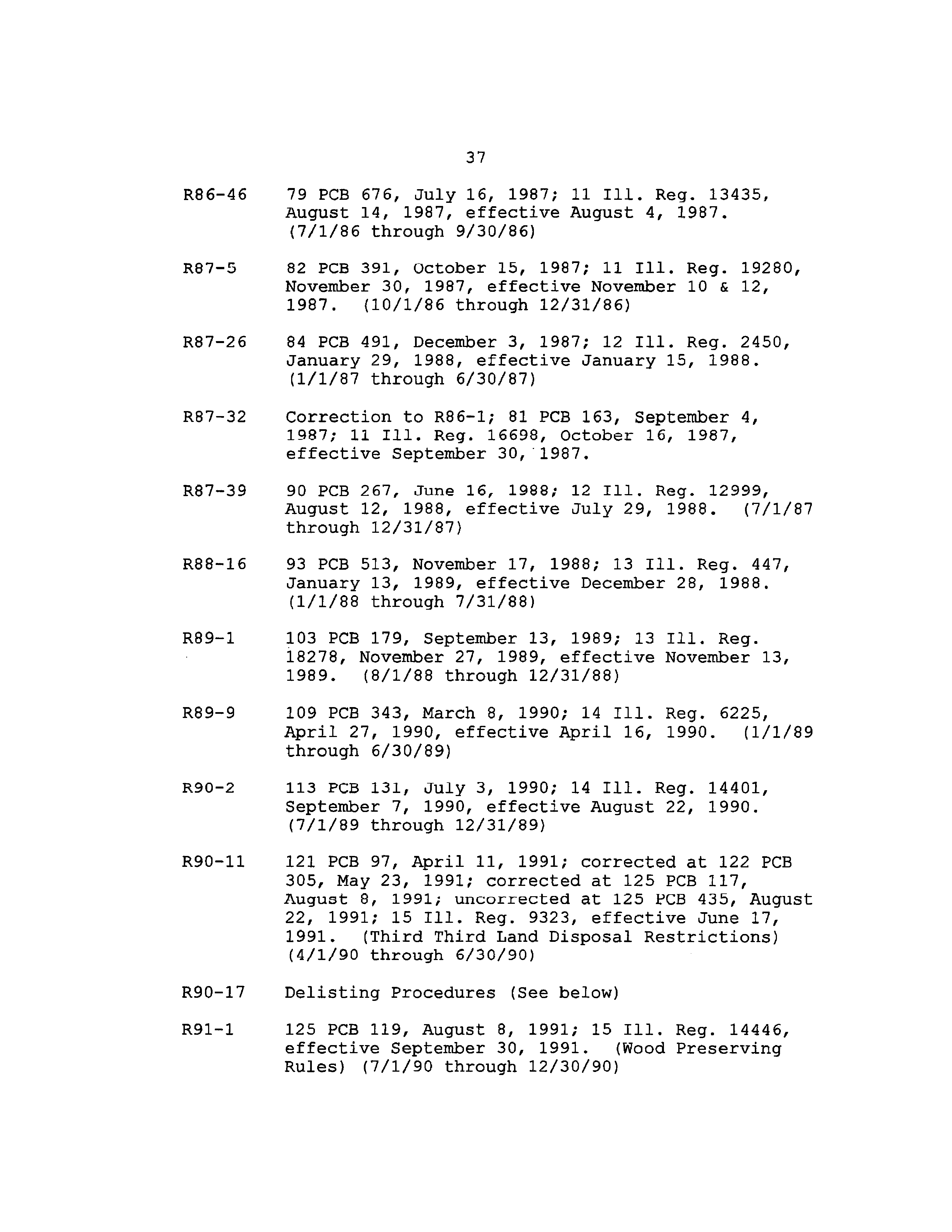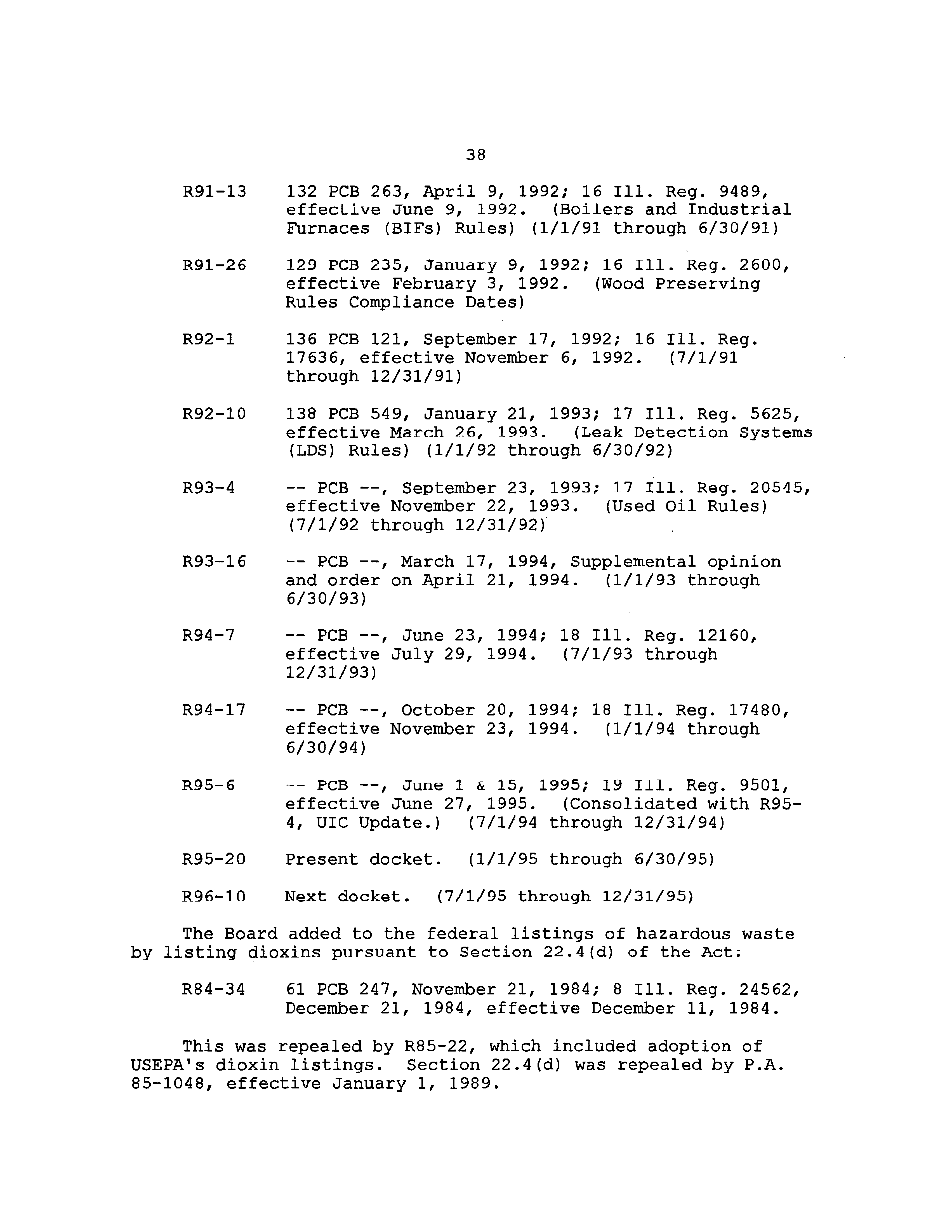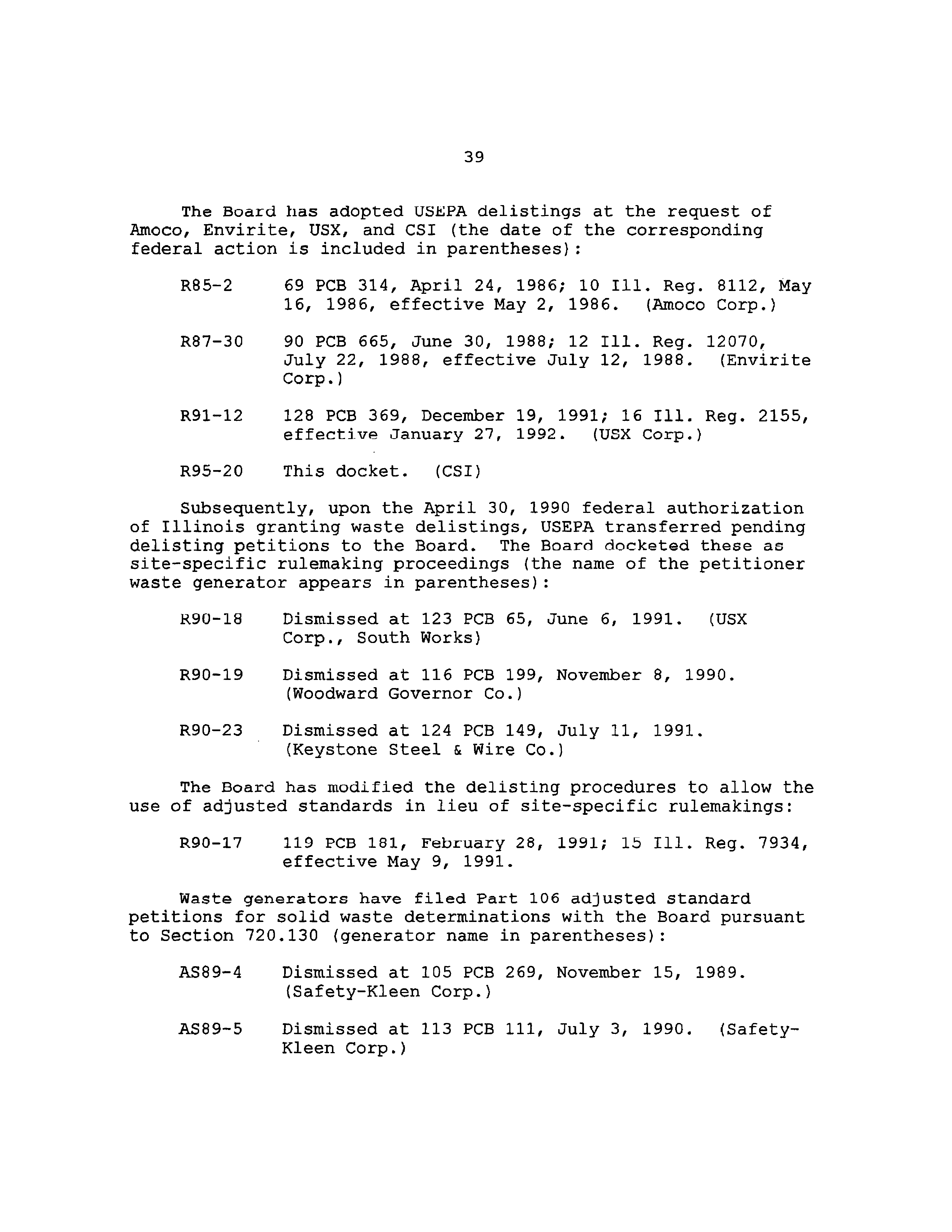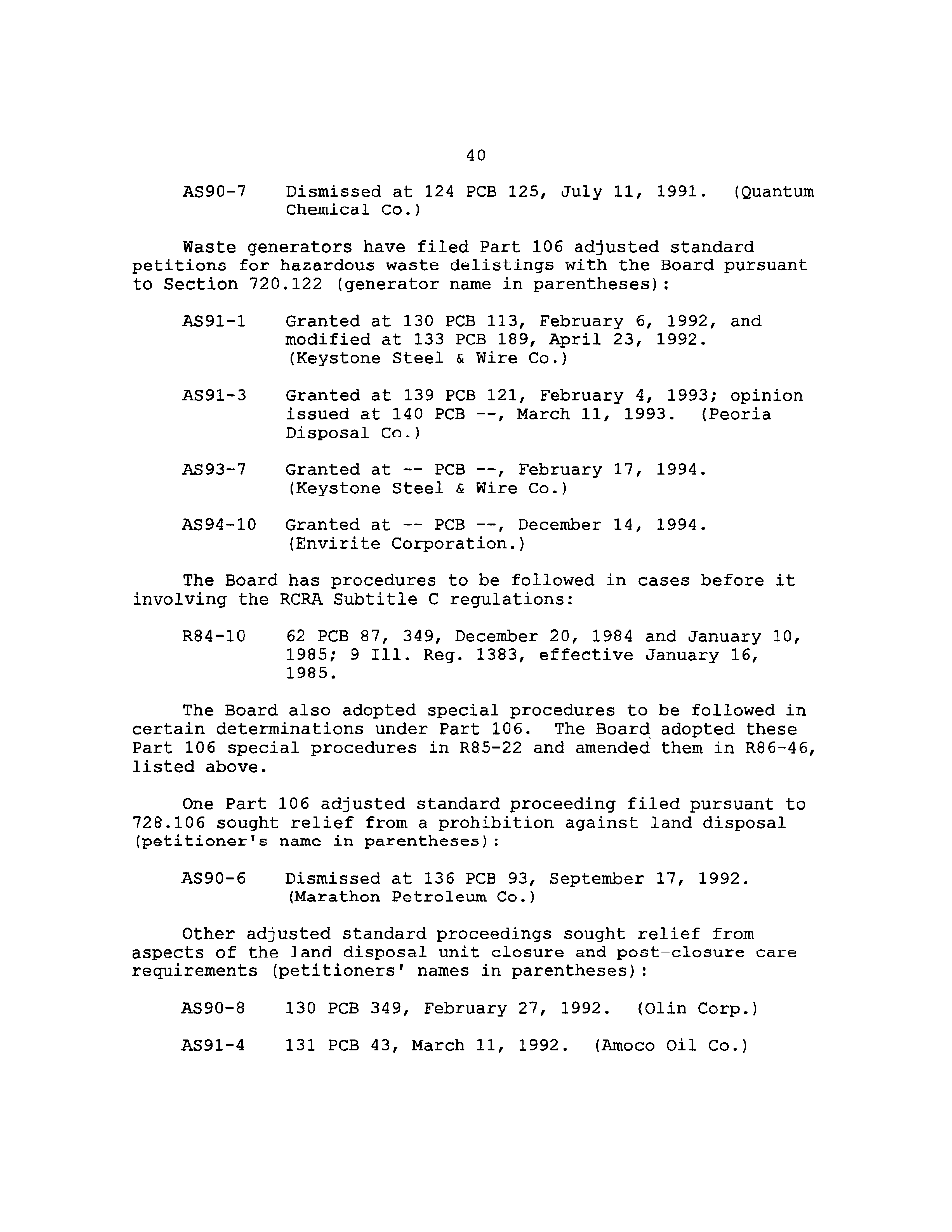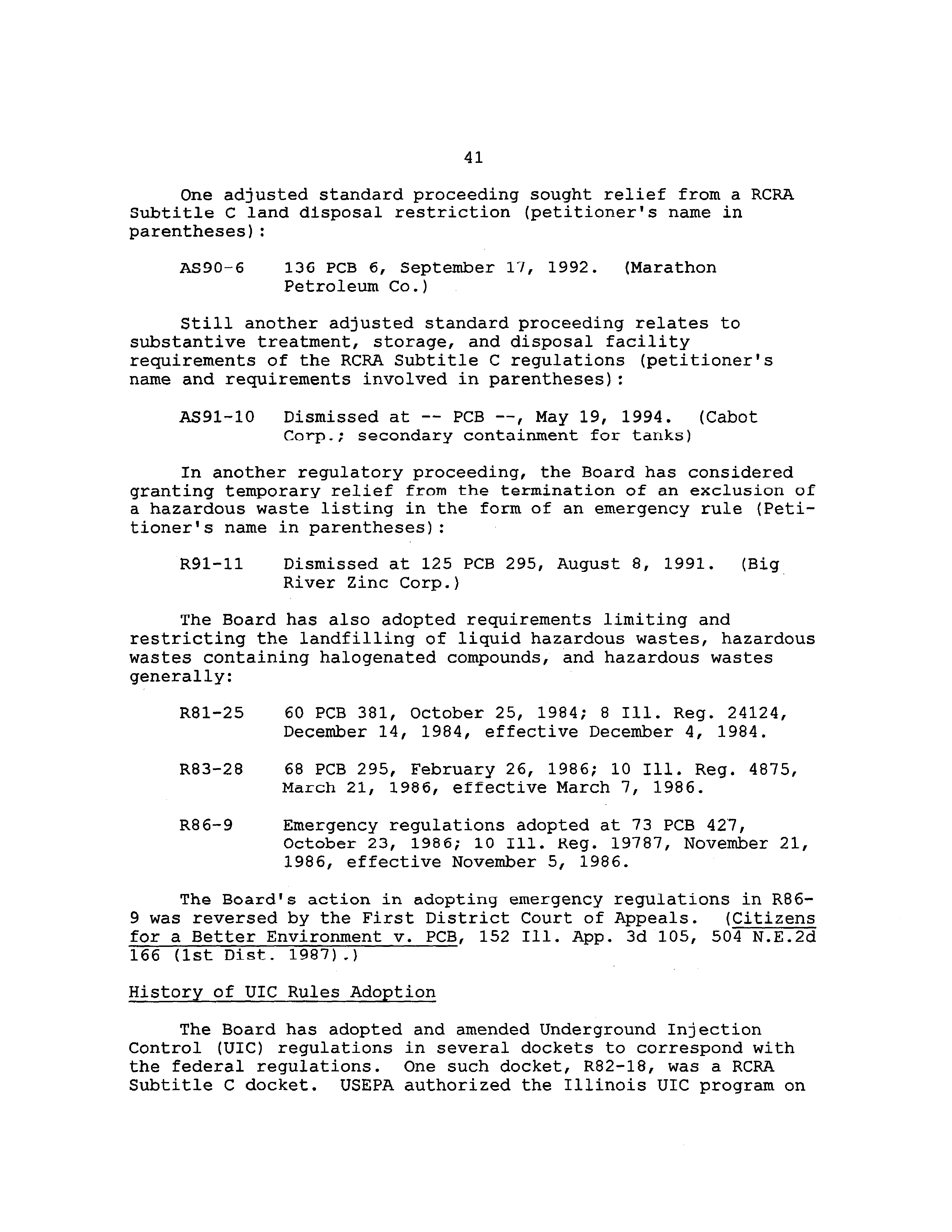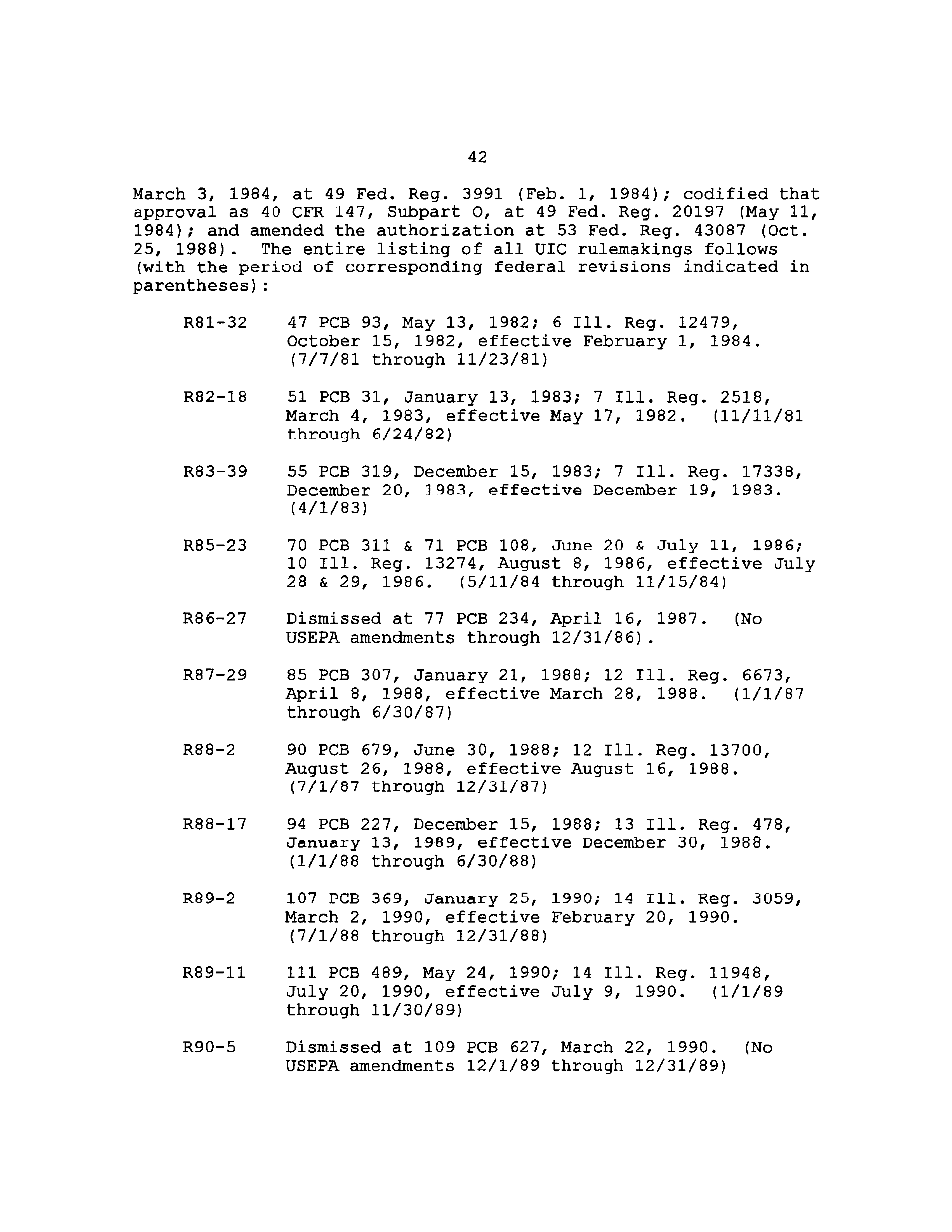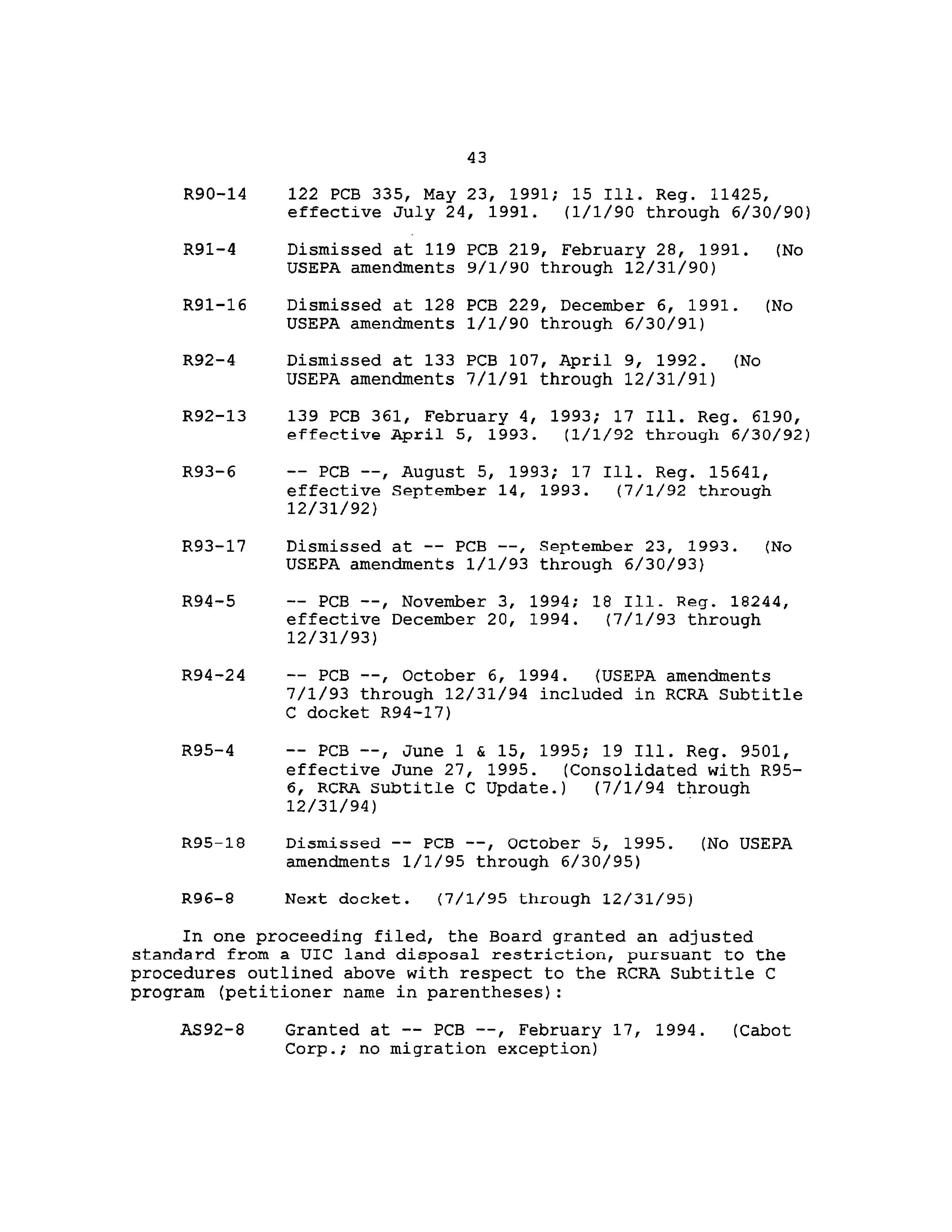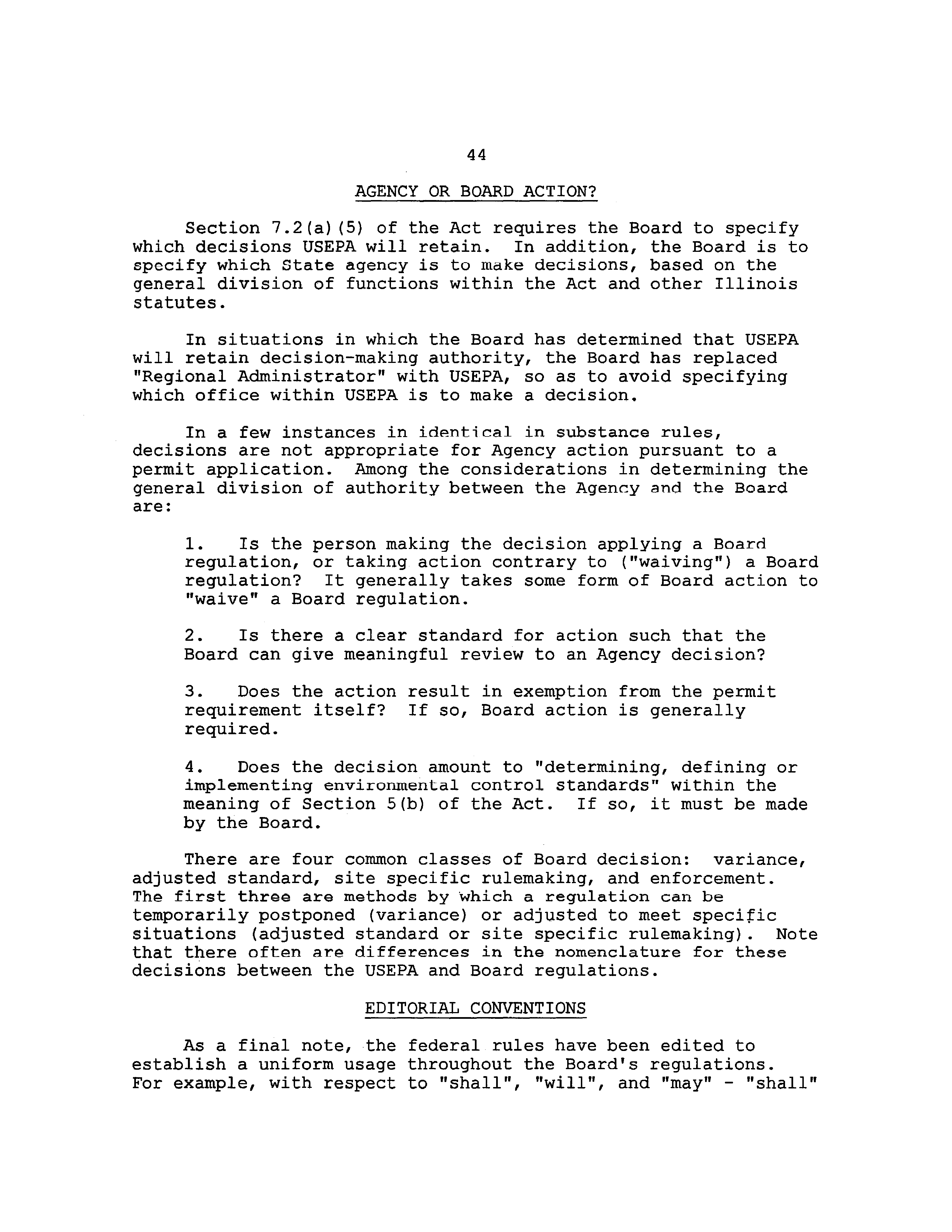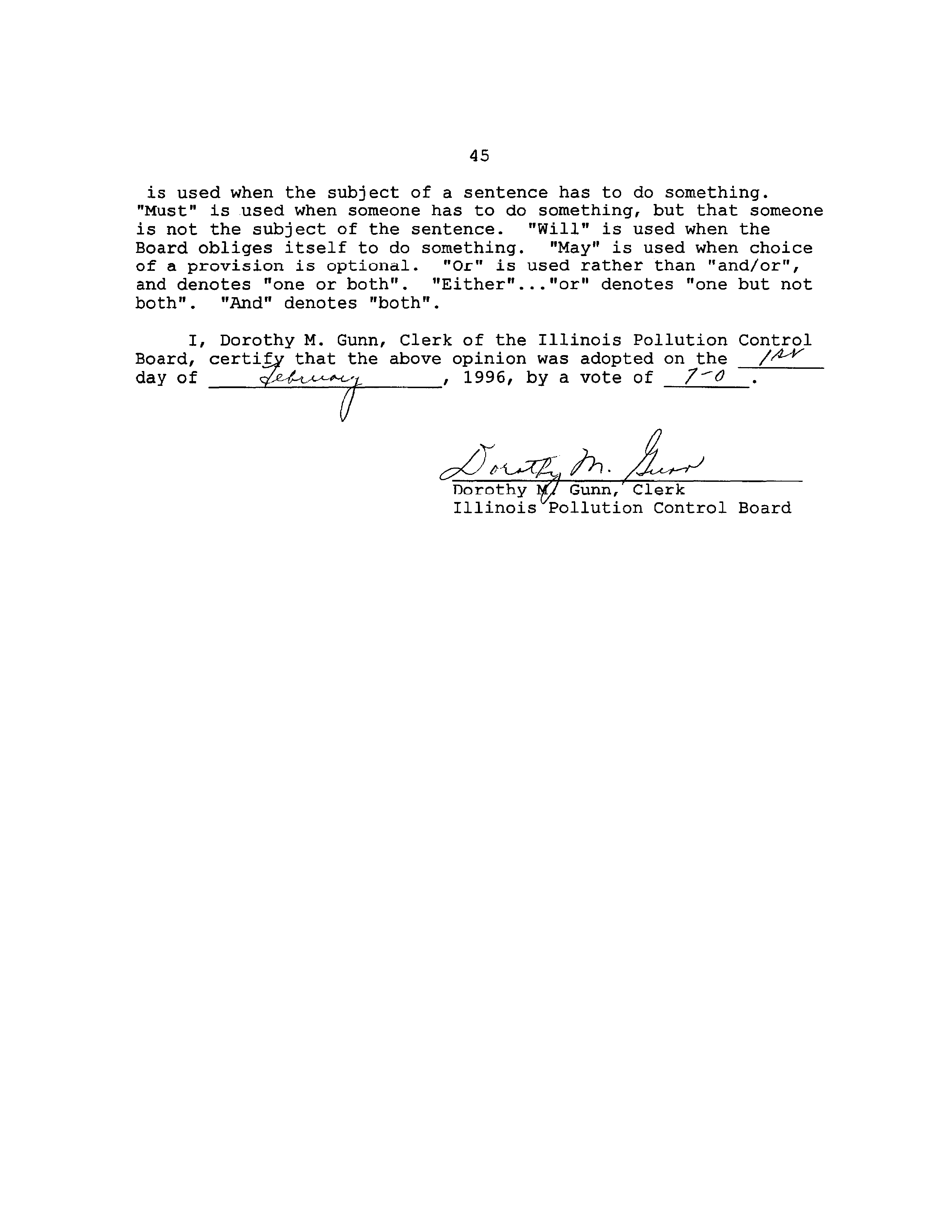ILLINOIS POLLUTION CONTROL
BOARD
February
1,
1996
IN THE MATTER OF:
RCRPi UPDATE, TJSEPA REGULATIONS
)
R95-20
(1—1—95 THROUGH 6—30-95,
)
(Identical
in Substance Rules)
7—7—95,
9—29—95
& 11—13—95)
Proposal for Public Comment.
PROPOSED OPINION OF THE BOARD
(by E.
Dunham):
Pursuant to Section 13(c) and 22.4(a)
of the Environmental
Protection Act
(Act)
415
ILCS 5/13(c)
&
22.4(a)
(1994),
the
Board proposes amendments to the RCRA Subtitle C hazardous waste
(RCRA)
regulations.
Section 22.4(a) provides for quick adoption of regulations
that are “identical in substance” to federal regulations adopted
by USEPA to implement Sections 3001 through 3005 of the Resource
Conservation and Recovery Act of
1976
(RCRA,
42 U.S.C. §~6921-
69Th)
and that Title VII of the Act and Section
5 of the
Administrative Procedure Act
(APA)
5
ILCS 100/5—35 & 5-40
(1994)
shall not apply.
Section 13(c)
similarly provides with
respect to underground injection control regulations adopted by
USEPA pursuant to Section 1421 of the Safe Drinking Water Act
(SDWA;
42 U.S.C. § 300h).
Because this rulemaking is not subject
to Section 5 of the APA,
it is not subject to first notice or to
second notice review by the Joint Committee on Administrative
Rules
(JCAR).
The federal RCRA Subtitle C regulations are found
at 40 CFR 260 through 268,
270 through 271,
and, more recently,
279.
This opinion supports an order adopted on the same day.
The
Board will cause the proposed amendments to be published in the
Illinois Register and will hold the docket open for 45 days after
the date of publication to receive public comments.
FEDERAL
ACTIONS CONSIDERED IN THIS RULEMAKINC
This rulemaking updates the Illinois RCRA Subtitle C rules
to correspond with federal amendments made in the period from
January
1 through June 30,
1995.
The USEPA actions during this
period are as follows:
Federal Action
Summary
Jan.
3,
1995,
Technical Corrections to Phase II LDRs
2
60 Fed. Reg.
242
Jan.
13,
1995,
60 Fed.
Reg. 3089
Feb.
3,
1995,
60 Fed. Reg.
6666
Feb.
7,
1995,
60 Fed. Reg.
7366
Feb.
9,
1995,
60 Fed. Reg.
7824
Apr.
4,
1995,
60 Fed. Reg.
17001
Apr.
4,
1995,
60 Fed. Reg.
17160
Apr.
17,
1995,
60 Fed.
Reg. 19165
May 11,
1995,
60 Fed. Reg. 25492
May 12,
1995,
60 Fed.
Reg. 25619
May 19,
1995,
60 Fed. Reg. 26828
June
13,
1995,
60 Fed. Reg.
31114
June 29,
1995,
60 Fed. Reg.
33912
Update to testing and monitoring methods
Response to City of Chicago
v.
Environmental Defense Fund decision
Determination that additional regulation
is necessary for cement kiln dust
New hazardous waste listings for six
carbamate production wastes; addition of
58 commercial chemical product wastes;
exemption of certain biological
treatment sludges
Update to testing and monitoring methods
Update to CWA analytical methods
Corrections
to carbarnate waste listings
Universal Waste Rule
Correction to carbamate waste listings
Postponement of effective date for tank,
container, and surrace impoundment air
emissions rules
Delisting
of
hazardous waste generated
in Illinois by a Pennsylvania company
Deletion of obsolete,
redundant,
and
outdated RCRA rules
Deviatipns from Routine Docket Time-Frame for Federal Amendments
In addition to these principal amendments that occurred
during the normal docket update period,
the Board has included
three additional,
later actions that are corrections or
3
relaxations of prior amendments in the preceding RCRA Subtitle C
update docket, R95-4/R95—6:
July 7,
1995,
Correction to the Subpart CC organic
60 Fed.
Reg.
35452
material emissions standards for tanks,
containers and surface impoundments
September 29,
1995,
Stay of Subpart CC rules
as they apply
60 Fed. Reg. 50426
to tanks,
containers, and surface
impoundments that contain wastes
generated in the manufacture of organic
peroxides
November 13,
1995,
Stay of Subpart CC rules in their
60 Fed. Reg.
56952
entirety until June
6,
1996
Further,
the Board used this opportunity to include a number
of corrective amendments to the existing regulations.
These
corrections are more fully described below.
They are derived
from comments by the Joint Committee on Administrative Rules
(JCAR) and the Illinois EPA (Agency).
Finally, the Board omitted from consideration two set of
rederal amendments that occurred during the time-frame of this
docket.
First, on January 3,
1995, USEPA corrected errors and
clarified language in the universal treatment standards adopted
on September 19,
1994 as the Phase II LDRs.
The Board did not
include those amendments in this docket because we dealt with
them in docket R95-4/R95—6, when adopting the Phase II rules.
Second,
on
May
19,
1995, USEPA stayed of the 40 CFR 264, subpart
CC and 265,
subpart CC
(Subpart CC) regulations governing organic
material emissions from tanks, containers, and surface
impoundments.
USEPA delayed the effective date by six months,
until December 6,
1995.
This delay was similarly included with
the R95—4/R95-6 amendments,
so there was no need for Board to
take action at this time.
Further, the subsequent federal stay
granted on November 13,
1995 made that initial stay of May 19
obsolete.
Brief Summaries of the Federal Actions Considered in this Docket
By way of brief elaboration, the Board will summarily
describe the federal actions that occurred in the time-frame of
this docket and our action on each matter.
The federal amendments of January 13, 1995 added Update II
to the third edition of “Test Methods for Evaluating Solid Waste,
4
Physical/Chemical Methods”,
SW-846, by updating the
incorporations by reference.
The Board included corresponding
amendments
in this docket.
On February 3,
1995, USEPA responded to public inquiries in
the wake of the Supreme Court’s decision in City of Chicago
v.
Environmental Defense Fund,
Inc.,
114
S.
Ct.
1588
(1994),
USEPA
resolved an issue by interpreting that municipal solid waste
incinerator ash becomes a hazardous waste when it leaves the
combustion building after the combustion and air pollution
control processes.
This avoids designating the combustion
building as a hazardous waste management facility.
Although
there were no regulatory amendments accompanying the
interpretation,
the Board has already noted the City of Chicago
decision in
a Board Note in our rules, so we amend the Note to
include the recent federal interpretation.
On February 7,
1995, USEPA announced that it had studied
cement kiln dust and determined that some further regulation of
this material (which is RCRA Subtitle C—exempt)
is desireable.
However, USEPA noted that the costs of complete Subtitle C
compliance would likely be prohibitive.
USEPA stated that it
plans to establish a special subset of regulations for this
material at some future time.
Since there are no regulatory
amendments at this time, and since the federal determination does
not yet carry any substantive effect, the Board does not need to
react to this determination by amendment of the Illinois rules.
This opinion will not further discuss this federal action.
By the amendments of February 9,
1995, USEPA established
hazardous waste listings
(1(156 through 1(161) for six carbamate
production wastes.
It added 58 new chemicals to the list of
commercial
chemical
products that become hazardous waste when
discarded.
USEPA also exempted biological treatment sludges from
hazardous waste regulation,
so long as the treated sludges do not
exhibit a hazardous characteristic.
On
April
17,
1995 and again
on
May
12, 1995, USEPA corrected the earlier carbamate
amendments.
The present docket includes amendments to the
Illinois RCBA Subtitle C rules
in
response to these federal
actions.
There were two sets of ostensibly unrelated amendments on
April 4,
1995 which will have a related impact on the Illinois
regulations.
First, USEPA amended its methods for testing
hazardous waste to clarify the temperature for pH measurements
and add an additional analytical method.
The Board will have to
incorporate these amendments into the Illinois rules.
Second,
USEPA amended its guideline for testing under the Clean Water Act
5
(40 CFR 136)
to add clarifying notes and update analytical
methods.
Although this action does not directly affect the RCRA
Subtitle C program, the Illinois RCRA/UIC regulations incorporate
federal part 136 by reference at Section 720.111.
Both sets of
amendments have required the Board to update the incorporations
by reference provisions
to reflect the latest federal versions of
the methods.
A major set of federal regulations arose on
May
11, 1995,
when USEPA established a new body of regulations to govern
certain high-volume hazardous wastes that are being collected for
recycling or disposal.
Although USEPA plans to add wastes in the
future
(notably,
fluorescent light bulbs),
these streamlined
rules
(not unlike the used oil regulations)
apply to batteries,
pesticides, and thermostats at this time.
This is the single
most significant set of amendments within the update period, and
the Board has received a request for expedited consideration of
these amendments.
The Board is establishing a new Part 733 in
this proceeding to correspond with new federal 40
CFR
273.
By the amendments of June 13,
1995, USEPA delisted the
treated residues of certain listed hazardous waste generated by
Conversion Systems,
Inc.
(CSI)
in Sterling,
Illinois.
As is
explained below, CSI submitted a request that has prompted the
Board to include corresponding amendments in this docket.
On June 29,
1995, USEPA deleted a vast
number
of rules that
were obsolete,
redundant,
or outdated.
USEPA amended three
provisions in 40
CFR
261 and 266 of the RCRA Subtitle C
(hazardous waste) rules
as part of this effort.
The Board has
included amendments in this docket to correspond with this
federal action.
Finally, undertook three actions relating to the 40 CFR 264,
subpart CC and 265, subpart CC regulations
(Subpart CC rules)
governing organic material emissions from tanks, containers,
and
surface impoundments.
One action,
on July 7,
1995, made
corrections to the Subpart CC rules.
Since both corrections
relate to the Federal Register preamble discussion and not to the
text of the regulations themselves,
no amendments were necessary
based on that action.
On the other hand,
Board action is
required by two other actions relating to the Subpart CC rules
that are outside the routine time-frame of this docket.
Although
both actions are within the nominal time-frame of the next RCRA
Subtitle C update docket,
R96—10, which covers the period of July
1 through December 31,
1995,
the Board has decided to take action
at this time and include both stays in this docket.
Both are
partial stays of the Subpart CC rules.
First, on September 29,
6
1995,
TJSEPA indefinitely stayed the Subpart CC regulations as
they would apply to tanks,
surface impoundments, and containers
containing hazardous waste generated by an organic peroxide
manufacturing process.
Second,
on November 13,
1995, USEPA
further delayed the effective date of the Subpart CC rules by
another six months, until June
6,
1996.
Both stays required
amendment of the base hazardous waste regulations.
PUBLIC COMMENTS
The Board will receive public comment on this proposal for a
period of 45 days following its publication in the Illinois
Register.
The Board will delay filing any adopted rules with the
Secretary of State
for 30 days after adoption, particularly to
allow USEPA review.
The complete text of the proposed amendments
appears in
a separate order adopted this day.
As of the time of proposing these amendments for public
comment, the Board had already received five public comments on
the rules:
PC 1 Vicki Thomas, Executive Director,
Joint Committee on
Administrative Rules
(letter and attachments dated
August 22,
1995)
PC
2 Vicki Thomas, Executive Director,
Joint Committee on
Administrative Rules
(JCAR; text of 35
Ill. Adm. Code
728.Table
T,
as adopted in R95-4/R95-6, with
corrections marked)
PC
3 Ron Klint,
TDI Batteries
(letter)
PC
4 Jeffrey C. Moore, General Counsel, Conversion Systems,
Inc.
(letter)
PC
5 Mark Homer,
Regulatory Affairs Counsel,
Chemical
Industry Council of Illinois
(CICI;
letter)
By PC
1 and PC
2, JCAR indicates
a number of minor
corrections to the base text of the Illinois RCRA Subtitle C
regulations and as last amended in R95-4/R95-6.
The Board has
examined those corrections and acted on them where necessary,
which is discussed below.
In PC
3,
a member of the regulated community has requested
expedited consideration of the universal waste rules,
adopted by
USEPA on May 19,
1995.
The letter outlines the environmental and
7
economic benefits of prompt adoption of what amounts to a
relaxation of the hazardous waste regulations.
The Board granted
expedited consideration of these amendments by an order dated
October 19,
1995.
The universal waste rules are a major segment
of the present action.
By PC
4,
a regulated entity requests that the Board adopt a
federal hazardous waste delisting
(of June 13,
1995) by
identical-in-substance rulemaking.
Although we possess the
statutory authority to adopt such site-specific federal
regulations using the identical—in-substance procedure,
the Board
does not unilaterally propose and adopt such rules in the absence
of a request that we act to adopt the rule.
The Board has
included the delisting with the present amendments in response to
the request.
In PC
5,
an industry trade association requested expedited
consideration of the federal stay
(dated November 13,
1995)
of
major provisions of existing rules adopted in docket R95-4/R95—6.
USEPA adopted the stay outside the nominal time-frame of this
docket.
The Board granted expedited consideration of the stay by
an order dated December 7,
1995.
As discussed above,
this stay
and another are both dealt with in the present action.
(See
infra,
pp.
16—19.)
EXPEDITED CONSIDERATION AND
REASON FOR
DELAY
Prior to commencing work on the present amendments, the
Board received requests to expedite this docket.
As described
above, the Board granted expedited consideration by orders dated
October 19 and December 7,
1995.
The October
19,
1995 order also
set forth reasons for delay in this docket--i.e.,
“present and
recent-past demands on Board resources and personnel,
including
those associated with completing the prior update, R95-4/R95—6”.
Although the proposal of these amendments is later than was
originally anticipated on October
19, this proposal for public
comment represents
a significant effort on the part of the Board
to act as promptly as possible, given the magnitude of the
amendments included in this docket and competing priorities for
the Board and its staff.
Assuming all the necessary work to
complete this rulemaking occurs as rapidly
as
possible, the Board
would anticipate adopting these amendments at a regularly-
scheduled meeting in April,
1996,
filing them with the Secretary
of State 30 days later.
8
The Board will cause a copy of the above segment of this
proposed opinion to be published in the Illinois Register,
as
required by Section 7.2(b)
of the Act.
HISTORY OF
RCRA
SUBTITLE C, UST and UIC ADOPTION
AGENCY OR BOARD ACTION?
EDITORIAL CONVENTIONS
The Board appends three routine discussions at the end of
this opinion.
The first is
a summary history of the Illinois
RCBA
Subtitle C and UIC programs.
It lists all actions taken to
adopt and maintain these programs since their inceptions.
It
includes a listing of all site-specific rulemaking and adjusted
standards proceedings filed that relate to these programs.
It
also lists all USEPA program authorizations issued to date.
The
second is a discussion of how the Board codifies requirements
that call for state determinations,
such as for exemptions,
exceptions,
etc.
The third discussion relates to our use of
language in the codification of identical-in—substance rules.
We
intend these as reference aids for interested persons in the
regulated community.
DISCUSSION
The federal actions that underlie this proceeding require
amendment of
the Illinois
RCRA
Subtitle C regulations.
This
discussion briefly focuses on each by subject matter,
indicating
the specific details of the actions taken by the Board where
pertinent.
General Revisions
The Board has engaged in an ongoing effort to change its
method of referring to the United States Environmental Protection
Agency in the hazardous waste and other regulations through the
course of the last several update proceedings, R93-16,
R94-7,
R94-17, and R95-4/R95-6.
Subsequent to the final opinion and
order in the next preceding update, R95-4/R95-6 dated June
1,
1995,
JCAR
requested that the Board adopt
the same usage
throughout all of our bodies of regulations--i.e.,
air,
water,
drinking water, RCPA Subtitle D
(municipal solid waste landfill),
RCBA
Subtitle C (hazardous waste), underground injection control
(UIC),
etc.
The Board included the Agency in our discussion of
whether “USEPA” or “U.S. EPA” would become the chosen form.
The
Agency’s Bureau of Air pressed for unity in favor of the “USEPA”
9
usage.
For this reason, the Board begins the process of
reversing the prior unifying amendments
in the provisions that
are open in this docket.
We will now refer to “USEPA”.
We will
continue this conversion
in future rulemakings as additional
Sections otherwise become open to amendment.
The Board substituted “or” for
“I”
in most instances where
this appeared in the federal base text,
using “and” where more
appropriate.
The Board further used this opportunity to make a
number of
corrections to punctuation, grammar,
and cross-
reference format throughout the opened text.
We also changed
“who” to
“that’t and “he” to
“it”,
where the person to which the
regulation referred was not necessarily a natural person,
or to
“he or she”, where a natural person was evident; changed “which”
to “that” for restrictive relative clauses; substituted “shall”
for “will”;
capitalized the Section headings and corrected their
format where necessary; and corrected punctuation within
sentences.
Finally,
some of the language structure of the federal base
text
(in the new amendments)
is cumbersome or less than clear.
The Board has attempted to correct some of the worst instances of
this.
We realize that the language of the hazardous waste
regulations would still be clearer and more concise, but the
Board cannot go further at this time and still maintain parity
with the federal regulations.
However, we invite interested
members of the regulated community to submit suggestions relating
to correcting deficiencies and errors and enhancing clarity of
the rules.
For the sake of brevity,
the following table sets forth the
miscellaneous corrections to the pre-amended base text of the
rules for persons needing to make the comparison in detail.
Corrections made to the amendments incorporated in this docket
are set forth in the topical discussions that follow.
Corrections to Base Pre-Amended Text
Section
Correction
702.110 “corrective action
Switch to “USEPA”
management unit”,
“date of
approval
.
.
.“
& “Environ-
mental Protection Agency”
703.123(e),
(f)
&
(g)
Subsection numbering
703.151
& 703.152
Reformat Board Notes
10
Switch to “USEPA”
in
“corrective action management
unit”,
“designated facility”,
“EPA hazardous waste number”,
“EPA identification number”,
“manifest document number”
&
“replacement unit”; move
definitions of “USEPA”,
“representative sample”
&
“uppermost aquifer”; add
definition of “USDOT”
Switch to “USEPA” under
“APTI”,
“GPO”
& “USEPA”;
correct end-of—quote
punctuation of reference to
SW—84 6
720.120 (a)
720.103 (a) (2) (D)
720.103(b)
(1)
(B)
&
(b) (11)
721.103(e)
(2)
(C)
721.103(f)
(2),
(f)
(7)
(A),
(f) (7) CG)
,
(f) (9) (A)
&
(f)
(9)
(C)
721.105(f) (3)
721.105(f)
(3)
(C)
Change to “that”
Remove “or” from subsections
(i)
through
(iv); repunctuate
(v)
(JCAR requests); use
possesive
“wastes’”
Switch
to
“USEPA”
Delete decimal from zinc
entries
(JCAR request); switch
to “USEPA”;
correct subsection
label
format
Switch to “USEPA”
Add “fulfills any of
*
.
.“
to
preamble & “the facility is”
to subsections; add reference
to 40 CFR 271
Switch to “USEPA”
721.105(g) (3)
Add “fulfills any of
.
.
.“
to
preamble;
“the facility is” to
subsections
& add reference to
40 CFR 271
720.110
720.111
721.105(g)
(3)
(C)
Switch to “USEPA”
11
721.105(g)
(3)
(E)
721.106
(a)
(3)
Use “that”
Switch to “USEPA”
721.130(b) (2)
Correct
“a”
(JCAR
request)
721.131(a)
F023
721.132
1(001
721.132
1(066
721.132
1(149
721.App. H
warfarin,
warfarin
salts, zinc phosphide
& ziram
72l.App. H
Add
closing
parentheses
(JCAR
request)
Change
to
“or”
Correct punctuation of
quotation
Change location of end
punctuation
(JCAR request)
Remove end punctuation
Add
“note:”
721.App.
I,
Table B
721.App.
Z
722.111(d)
Switch
to
“USEPA”
Correct first-row entries’
parentheticals
(prompted by
JCAR request); add cross-
references to column heading
footnotes;
add
Board
Note
indicating source
Add comma
724.101(f)
Switch to “USEPA”
724.101(g)
(7)
through
(g)
(10)
724. 980 (a)
Add cross-reference to
reserved
federal
provision
&
rcnuniber subsections to
correspond with federal
counterparts
Switch to “USEPA”
725.
980 (a)
Switch
to
“USEPA”
726.
180 (a)
Use singular,
change to “that”
in place of “who”; use “the
batteries” in place of
“them”
12
726.203(a)
(1)
(B),
(a)
(3),
(b) (2),
(c)
(2)
(A)
(1),
(c)
(4)—
(A) (i)
&
(c)
(8)
(B)
(i)
&
726.204(a) (3)
728.101(e) (3)
728.Table
T D033
728.Table
T
F028
728.Table T F037
728.Table
T
F039
728.Table
T F039
728.Table T K019
728.Table
T
K051
728.Table
T
P024
729.Table T U027
728.Table
T end note 7
72~.Table
U
Diphenyl-
nitrosoamine
728.Table U end note 4
Switch to “USEPA”
Switch to “USEPA”
Correct
CAS
number
(JCAR
requested)
Switch to
“TJSEPA”
Correct wastewaters entry for
xylenes
(JCAR
requested)
Switch to “USEPA”
Correct CAS number for bis(2-
chioroisopropyl) ether
(JCAR
requested)
Correct CAS number for bis(2-
chioroisopropyl) ether
(JCAR
requested)
Correct CAS number for toluene
(JCAR requested)
Correct wastewaters entry
(JCAR requested)
Correct CAS number for bis(2-
chloroisopropyl) ether
(JCAR
requested)
Switch to “USEPA”
Add
space
(JCAR
requested)
Switch to “USEPA”
Updated Analytical Methods--Section 720.111
USEPA amended 40 CFR 260.11(a)
on January 13,
1995,
at
60
Fed.
Reg.
3089,
and on April
4,
1995,
at
60 Fed. Reg.
17001.
13
Section 720.111 of the Illinois hazardous waste regulations
corresponds with 40 CFR 260.11.
Both sets of amendments related
to updating the reference,
“Test Methods for Evaluating Solid
Waste,
Physical/Chemical Methods”
(SW-846).
Both sets of
amendments added methods to SW-846.
The January 13 amendments
added Updates
I,
II,
and hA
to the third edition in the
reference to this document.
Those amendments also revised the
references to the updates to indicate that they are now available
through the Government Printing Office, which means the deletion
of the references
to MICE and USEPA-OSW as sources of these
documents.
The April
4 federal amendments added Update IIB to
the reference.
In reviewing the January 13,
1995 Federal
Register discussion of the methods included in the updates, the
Board observed that Method 8290 is included in Update II.
We
therefore deleted the reference to USEPA as the source for this
method.
Although not directly related to the hazardous waste
regulations, USEPA also amended the Clean Water Act programs
analytical procedures of 40 CFR 136 on April
4,
1995,
at
60 Fed.
Reg.
17160.
USEPA added clarifying footnotes; updated the
methods in Tables
IA,
IB,
IC,
and ID; and corrected typographic
errors in the text.
The Board has incorporated 40 CFR 136 by
reference in Section 720.111(b).
The Board has incorporated the three sets of federal
amendments into Section 720.111.
We updated the reference to SW-
846 to indicate the new updates and revised availability of those
updates.
The Board also updated the incorporation of 40 CFR 136
by adding the April
4 Federal Register citation.
The Board
invites public corrinent on the updated incorporations in Section
720.111.
Hazardous Waste Determinations--Sections 721.103, 721.104~
721.132, 721.133 & 721.Appendices S through
I
USEPA undertook three basic actions relating to
identification of hazardous waste to which the Board responds in
this docket.
First, USEPA published its interpretation of the
point at which municipal incinerator ash initially becomes
subject to regulation as hazardous waste in light of
a recent
Supreme Court decision.
Second, USEPA adopted and corrected
regulations adding a number of hazardous waste listings and
hazardous constituents listings.
These primarily involve wastes
generated in carbamate manufacturing processes.
Finally, USEPA
granted a hazardous waste delisting to a company for a waste
generated in Illinois.
14
USEPA announced its interpret.aLion of when municipal
incinerator ash becomes subject to hazardous waste regulation on
February 3,
1995.
It took this action as
a result of the Supreme
Court’s decision in City of Chicago v. Environmental Defense
Fund,
——
U.S.
——,
114 S. Ct. 1588
(1994).
Prior to that
decision, USEPA had interpreted the exclusions of 40 CFR
261.4(b) (1) (ii)
(corresponding with and Section 3001(i)
of RCRA
as excluding the combustion of municipal waste
from hazardous
waste regulation.
(See 50 Fed. Reg.
28702, July 15,
1985.)
At
various times, USEPA took the position that the resulting ash
itself was exempted.
(See 59 Fed. Reg.
29372,
June 7,
1994.)
In
City of Chicago,
the Court determined that the resulting ash was
subject to RCRA Subtitle C regulation if it exhibited a
characteristic of hazardous waste.
On February
3,
1995, USEPA
stated that the Court’s opinion left open the issue of the point
at which the ash would become subject to Subtitle C regulation.
USEPA interpreted that this point was when the ash actually
leaves the combustion building for disposal.
Prior to that
point,
USEPA does not consider the ash subject to regulation as
hazardous waste.
In response to the federal action of June
7,
1994,
relating
to facility permitting, the Board added a Board Note to Section
721.104(b) (1) (B)
indicating the Supreme Court decision and
USEPA’s June 7,
1994 action in response.
The Board has added
language to this Note indicating the newer February 3 action by
USEPA in further response to the Supreme Court’s decision.
USEPA added six wastes generated in the manufacture of
carbamates
(i.e.,
“carbamate wastes”)
to the lists of hazardous
wastes 40 CFR 261 Subpart D (“Subpart D wastes”)
on February 9,
1995,
at 60 Fed. Reg.
7824.
USEPA further added 58 specific
chemical substances to the list of commercial chemical products
that are hazardous waste when discarded.
This action entailed
amendments to 40 CFR 261.3(a) (2) (iv) (F),
(a) (2) (iv) (G), and
(c)(2) (ii) (D)
(all added);
261.32; 261.33(e) and
(f); and 261,
Appendices VII and VIII,
which correspond with 35 Ill.
Adm.
Code
721.103(a) (2) (D) (vi),
(a) (2) (D)(vii), and
(e) (2) (D);
721.132;
721.133(e)
and
(f); and 721.Appendices G and H.
USEPA later
corrected errors in these amendments on April
17,
at
60 Fed. Reg.
19165, and May 12,
1995,
at 25619.
The Board has made all the
amendments necessary to incorporate the federal
revisions.
The
Board made minor editorial changes in the federal text in a
rnrniber of locations.
The changes are limited to correction of
punctuation, the capitalization of an abbreviated chemical name,
and the correction of the format
(i.e.,
spacing and hyphenation)
and spelling of chemical names for the added constituents.
we
have not otherwise deviated from the federal carbamate rule
15
revisions.
A table
at the end of this segment of the discussion
indicates the location of the changes.
USEPA granted Conversion Systems,
Inc.
(CSI)
a hazardous
waste delisting on June 13,
1995,
at
60 Fed. Reg.
31107.
The
waste to which the delisting immediately applies is
proprietarily-treated electric arc furnace dust
(1(061)
generated
at CSI’s Sterling,
Illinois operations.
The federally—granted
delisting includes a number of conditions pertaining to waste
treatment, maximum leachable contaminant concentrations,
testing,
recordkeeping, and reporting.
The delisting includes conditions
relating to future expansion to other locations upon written
amendment by USEPA.
The Board has incorporated the CSI delisting into Section
721.Appendix
I, Table B,
relating to delisted wastes from
specific sources with a limited number of revisions to the
language for the sake of clarity and to make it fit within
Illinois administrative and statutory requirements.
We list
revisions and our reasons in the following table:
Deviations from the Federal Text of the CSI Delisting
the
Deviation from Federal Text
Explanation
Use of full name instead of
“EAFD” for initial reference
in preamble
Added reference “municipal
solid waste landfill” to
Subtitle D references in
preamble and paragraph 2.
Offset parenthetical language
of
“as
.
.
.
“
clauses with
commas and in the preamble and
paragraph 2.
Changed “that” to “which” in
preamble
Added incorporation language
to reference to SW—846
in
paragraph
1.
Changed “must”
to “shall” in
several locations in
paragraphs
l.A.,
1.C.,
2.,
4.,
Enhanced clarity
Language convention used in
Illinois nonhazardous waste
landfill
(Subtitle D)
regulations
Grammatical corrections
Grammatical correction
Administrative Procedure Act
requirement
Board language convention for
imperative actions
16
and 5.
Changed “composites” to
“composite samples”
in
paragraph l.A.
Changed “comprised” to
“composed”
in paragraph l.A.
Added “above” and “below” to
cross-references
Added language to paragraph
1.B. outlining options for
future expansion of the
delisting
Substituted “approved
facility” for “Sterling,
Illinois facility and any new
facility subsequently added”
in paragraph 1.C.
Substituted “as hazardous
waste” and cross reference to
the pertinent regulations for
a reference to RCRA Subtitle C
in paragraph 2.
Substituted “this
exclusion”
for “the exclusion” in
paragraph 2
Added “in parts per million”
to paragraph
3.
Substituted language relating
to advanced notice and
approval of
process
changes in
paragraph
4.
Changed references to
notification of USEPA to
notification of the Agency
(Illinois EPA), changed a
reference to “sufficient basis
to revoke”
to “a violation of
the Act and Board
regulations”, and altered the
Enhanced clarity
Grammatical correction
Codification requirement
Expressly clarify the options
available under
Illinois law
that do not exist in federal
law
Clarity and economy of
language
Correct reference in Illinois
regulatory scheme
Enhanced clarity
Enhanced clarity
Enhanced clarity
Comports with Illinois
regulatory scheme
17
USEPA-specific references in
the certifications in
paragraph
5.
The
Board
lists
its
deviaLions
from
the
text
of
the
carbamate waste amendments in the following table for the
convenience of those who must make a detailed comparison of the
federal
and
state
texts:
Deviations from the Federal Text of the Carbamate Waste Rule
Section
721.103(a)
(2)—
(D) (vi)
&
(vii)
Derived from
261.3(a)
(2)—
(iv)
(F)
&
(G)
Deviation(s)
Use
of
colon;
add
commas
for
parentheticals
721.103(e)
(2)—
(D)
261.3(c)
(2)—
(ii) (D)
Use of colon;
deletion
of
comma
from two—element series; use of
“USEPA”
721.133(e)
P189,
P191,
P192,
P185
P202
&
261.33 (e)
Correct format of chemical
names
721.133(f)
& U378
U409
261.33
(f)
Correct format of chemical
names
721.App. G
& 1(160
1(159
261.App. VII
Correct format of chemical
abbreviated names
72l.App.
H
261.App. VIII
Correct format of chemical
names in entries for “A2213”,
“aldicarb sulfone”,
“ben—
diocarb”,
“bendiocarb phenol”,
“benomyl”,
“bis (pentamethyl—
ene) thiuram”,
“carbosufan”,
“ferbam”,
“formetanate hydro-
chloride”,
“formparanate”,
“3-
iodo-2-propynyl-n-butyl-car-
bamate”,
“physostigmine”,
“physostigmine salicylate”,
“selenium,
tetrakis(dimethyl—
dithiocarbamate)”,
“thiodiarb”,
“thiophanate-methyl”
&
“tirpate”
The Board invites comment on our amendments
to the
exclusions from regulation as hazardous waste in Section 721.104
18
in response to the USEPA response to the City of Chicago
decision.
We also invite comment on our responses to the
carbarnate rules,
to the definition of hazardous waste in Section
721.103 the listings of Subpart D listed wastes in Sections
721.132 and 721.133, to the listing of the bases for waste
listing in Section 721.Appendix G, and to the hazardous
constituents in Section 721.Appendix H.
Finally, the Board
invites comment on our codification of the federally-granted CSI
hazardous waste delisting.
Postponement of Subpart CC Organic Emissions Rules Effective
Date——Sections 724.980, 724.989, 725.980, 725.982 & 725.990
USEPA adopted the
40 CFR 264, Subpart CC and 265, Subpart CC
organic material emission regulations applicable to hazardous
waste tanks,
containers, and surface impoundments in December,
1994.
It stayed the effective date of those rules by six months
on May 19,
1995,
at
60 Fed.
Reg.
26828.
As discussed above, the
Board incorporated both the original adoption and that first six-
month stay into the Illinois regulations in the prior update
docket,
R95—4/R95—6.
USEPA granted further limited stays of the Subpart CC
regulations on September 29,
1995,
at
60 Fed. Req.
33912, and
November 13,
1995,
at
60 Fed. Req.
56952.
As discussed above,
USEPA indefinitely stayed the rules as to wastes from the
manufacture of organic peroxides in the September action,
for
safety reasons.
USEPA amended 40 CFR 264.1080,
264.1089,
265.1080, and 265.1090, which correspond with 35 Ill.
Adiu.
Code
724.980, 724.989,
725.980,
and 725.990,
to effect this
stay.
USEPA then granted a second six-month stay of the effective date
for the rules in their entirety in the November action, until
June
6,
1996.
This required amendment of
40 CFR 264.1080,
265.1080,
and
265.1082
(corresponding
with
35
Ill.
Adm.
Code
264.980,
265.980,
and
265.982).
The
Board
has
incorporated
both
stays
into
this
docket
in
response
to public comments and to avoid a situation where the
Illinois regulations could be read as more stringent than the
federal
rules.
In
anticipation
of
these
further
stays,
the
Board
added
Board
Notes
to
Sections
724.1080(a)
and
725.1080(a)
in
the
R95-4/R95-6
update
to
cite
the
earlier
stay
and
to
explain
that
we
do
not
intend
greater
stringency.
Therefore,
to
incorporate
the
federal
stays,
the
Board
has
amended
the
effective
date
citations in these rules to reference June
6,
1996 and the
November 13,
1995 Federal Register citation to the stay at
Sections 724.1080(a) and
(b),
725.1080(a) and
(b),
and
19
725.982(a),
to correspond with the federal revisions at 40 CFR
264.1080(b), 265.1060(b), and 265.1082(a).
The Board has further
added the new language for the organic peroxides stay at Sections
724.980(d), 724.989(i),
725.980(d), and 725.990(i),
to correspond
with the federal additions of 40 CFR 264.1080(d),
264.1089(i),
265.1080(d), and 265.1090(i).
The Board lists its deviations from the text of the Subpart
CC stay amendments
in the following table for the convenience of
those who must make a detailed comparison of the federal and
state texts:
Deviations from the Federal Text of the Subpart CC Stays
Section
Derived from
Deviation(s)
724. 980 (a)
264.
1080 (a)
Alter effective date and Board
Note previously added to
federal base text
724.980(d)
264.1080(d)
Remove
“administratively”;
remove
“a”;
add
comma
724.980(d) (3)
264.1080(d) (3)
Use “must”; remove comma from
two-element series
724.990(i) (2)
264.1090(i) (2)
Add “pursuant to”; use “must”
724.990(i) (2)—
(A)
264.1090(i) (2)—
(i)
Use “must”; use commas in place
of semicolons
724.990(i) (2)—
(b)
264.1090(i) (2)—
(ii)
Use “must”; use commas
in place
of semicolons;
remove commas
from two-element series; use
singular “waste” and “this”;
replace “handled” with
“managed”
724.990(i) (3)
264.1090(i) (3)
Use “or” in place of “and”;
add
“pursuant to” and “specified
in”; use “were” to state
condition contrary to fact; use
“must”
724.990(i) (3)—
(A)
&
(B)
264.1090(i) (3)—
(i)
&
(ii)
Use singular “waste” and
“this”; use “must”; use “would”
to state condition contrary to
fact
20
725. 980 (a)
265.
1080 (a)
Alter effective date and Board
Note previously added to
federal base text
725.980(d)
265.1080(d)
Remove
“administratively”;
remove “a”; add comma
725.980(d) (3)
265.1080 Cd) (3)
Use
“must”;
remove
comma
from
two-element series
725.990(i) (2)
265.1090(i) (2)
Add “pursuant to”; use “must”
725.990(1) (2)—
(A)
265.1090(1) (2)—
(i)
Use “must”; use commas in place
of semicolons
725.990(i) (2)—
(b)
265.1090(1) (2)—
(ii)
Use “must”; use commas in place
of semicolons; remove commas
from two-element series; use
singular “waste” and “this”;
replace “handled” with
“managed”
725.990(i) (3)
265.1090(i) (3)
Use “or” in place of “and”; add
“pursuant to” and “specified
in”; use “were” to state
condition contrary to fact; use
“must”
725.990(i) (3)—
(A)
&
(B)
265.1090(i) (3)—
(1)
&
(ii)
Use
singular
“waste”
and
“this”;
use “must”; use “would”
to state condition contrary to
fact
The Board invites comment on our codification of the federal
stays of the Subpart CC regulations.
The two stays upon which
the Board seeks comment are the indefinite stay relating to
organic peroxides manufacturing waste and the second six-month
general stay of the rules.
Universal Waste Rules--Sections 703.123, 720.110, 720.120,
720.123, 721.105,
721.106, 721.109, 722.110, 722.111, 724.101,
725.101, 726.180,
728.101
& Part 733
USEPA adopted a major new body of alternative hazardous
waste management regulations on May 11,
1995,
at
60 Fed.
Req.
25492,
as 40 CFR 273.
These new regulations, called the
“universal waste rule”, modify the RCR7~Subtitle C program to
21
streamline the system as it applies to these widely-generated
wastes.
The wastes to which the alternative regulations
currently apply are batteries, pesticides, and mercury—containing
thermostats.
USEPA stated in adopting the rules that it intends
to expand their applicability to new wastes in the future, such
as fluorescent light bulbs.
In recognition of some fundamental problems with the
hazardous waste management system, USEPA devised the universal
waste rule.
Its goals are to encourage resource conservation
while adequately protecting
human
health and the environment,
to
improve implementation of the Subtitle C regulations, and to
encourage efforts to collect the unregulated universal waste and
remove it from the municipal waste stream.
Although generaLed in
great quantities overall,
universal waste is generally generated
in small quantities below the threshold of regulatory concern by
individual
generators.
Thus,
they are lawfully disposed of in
municipal trash in large aggregate quantities by these small
generators.
One problem with the existing RCRA Subtitle C
hazardous waste management scheme is that
an effort to divert or
recover these materials from municipal trash at central locations
would likely render the recovery efforts subject to the hazardous
waste regulatory scheme, which may be a disincentive to such
diversion or recovery efforts and a factor favoring their
continued large-scale disposal in municipal solid waste
landfills.
The universal waste rule divides the universe of those
handling universal waste into two groups:
large quantity
handlers of universal waste
(LQHUW5) and small quantity handlers
of universal waste
(SQHUWs).
A person accumulating and storing
5,000 kilograms
(11,000 pounds)
or more of universal waste on-
site is an LQHUW;
a person aggregating less than this amount is a
SQHUW.
The major differences in impact of the rules on these
entities is that LQHUW must notify USEPA of its activity and
maintain required records for its waste,
and there are no similar
requirements imposed on a SQHUW.
Both LQHUWs and SQHUW5 are
generally prohibited from diluting,
treating,
and disposing of
universal waste, and imposed on both are general management
requirements intended to protect human health and the
environment, such as limitations on waste-related activities and
off-site shipment and packaging and labelliny, accumulation time
limit, employee training, and release response requirements.
In addition to requirements imposed on handlers of universal
waste,
the universal waste rule includes requirements
for
universal waste transporters and destination facilities.
The
requirements and prohibitions imposed on
a universal waste
transporter are somewhat similar to those for handlers to
a major
22
extent.
The transporter standards include general prohibition
against diluting,
treating, and disposing of universal waste,
required compliance with USDOT standards,
an accumulation tine
limit, release response requirements, and destination
requirements.
The management standards for destination
facilities include requirements for receipt or diversion or
rejection of consignments of universal waste.
They also include
recordkeeping requirements for receipts of waste.
The universal waste rule has two additional sets of
requirements for universal waste management.
First,
the
regulations include requirements for importation of universal
waste that subject handlers, transporters,
and destination
facilities to the universal waste rule when the shipment arrives
in the United States.
Second, the universal waste rule includes
specific petition requirements for those interested in asking
USEPA or an authorized state to include additional wastes as
subject to universal waste regulation.
Finally, accompanying new 40 CFR 273 were amendments to
other segments of the existing hazardous waste regulations
necessary to implement the new rules.
These include amendments
to
40 CTh 260.1,
to incorporate new definitions; amendment of
260.20(a) and the addition of 260.23,
to accommodate petitions
for rulemaking under the universal waste rule;
and amendment of
40 CFR 261.5,
262.10,
262.11,
264.1,
265.1, 266.80,
268.1, and
270.1 and the addition of 261.9,
to set forth the applicability
and interplay of the universal waste rule and relevant segments
of the generally—applicable hazardous waste management
regulations.
The Board has incorporated the universal waste rule into the
Illinois hazardous
waste
regulations with minimal, nonsubstantive
deviation from the federal text.
This incorporation adds Part
733 and Sections 720.123 and 721.109 to the rules and the
amendment of Sections 703.123, 720.110, 720.120,
721.105,
721.106,
722.110, 722.111,
724.101, 725.101,
726.180,
728.101.
The deviations from the federal language were primarily
corrections to grammar and punctuation, were enhancements in
clarity, or were necessary to integrate the universal waste rules
to the Illinois regulatory structure.
The Board summarizes the
deviations in
a table at the end of this segment of the
discussion.
The table is intended to aid those persons,
such as
JCAR or USEPA, that must compare the federal and state versions
of the text.
One series of routine substitutions bears specific
discussion.
These are the substitutions of a state agency to
perform functions where USEPA uses its own name in the rules.
23
Generally,
the Board substitutes itself or the Agency for most
functions USEPA cites for itself in the regulations.
A routine
discussion at the end of this opinion,
entitled “Agency or Board
Actions?” outlines the circumstances that dictate whether the
Agency or the Board is used in substitution.
An exception is the
grant of an extension to the federal effective date for a land
disposal restriction under 40 CFR 268.5, which
is beyond a
state’s authority to grant.
Another example is the granting of
federal facility identification numbers under 40 CFR 262.12,
263.11,
264.11, or 265.11.
In the universal waste rule,
the Board encountered two
special instances of substitutions.
The first is the
notification requirements of Sections 733.112
(small quantity
handlers of universal waste; derived from 40 CFR 273.12)
and
733.132
(large quantity handlers of universal waste; derived from
40 CFR 273.32).
Both appear parallel to RCBA section 3010
notification, since the handler must obtain a USEPA
identification number.
For this reason, the Board has retained
the requirement of notifying USEPA while imposing the duty to
also notify the Agency of the activity.1
Second, Section 733.161(c)
(derived from 40 CFR 273.61(c))
imposes
a notification requirement on a destination facility it
it receives a shipment containing hazardous waste.
Since this
is
clearly an enforcement-related notification,
the Board has
required notification of the Agency alone.
Finally,
in the 733.Subpart G and Section 720.123, the Board
has substituted itself as the appropriate person to petition for
inclusion of additional hazardous waste in regulation as
universal waste.
The preamble Federal Register discussion,
at
60
Fed.. Peg. 25537,
indicates that USEPA intends that states may
obtain federal authorization to grant additions to universal
waste similar to state authorization to grant hazardous waste
delistings.2
In making this substitution,
the Board realizes
that we cannot effectively grant an addition to universal waste
until the state received federal authorization of that aspect of
our regulations,
similar to hazardous waste delistings.
Further,
‘
The Board realizes that USEPA and the Agency work
cooperatively in exchanges of information and in policing regulated
entities.
However, requiring notification to both entities gives
the regulators and the regulated community an added measure of
certainty that both sets of files are complete.
2
An authorization granted the Board effective April
30,
1990,
at 55 Fed. Reg.
7320
(March
1,
1990).
24
federal primacy provisions would make a federal grant of
universal waste status ineffective in Illinois until also granted
by the Board.3
For these reasons, the Board has crafted the
universal waste designation provisions so that it is clear that
we will consider federally-granted designations using the
identical-in-substance procedure and those not federally-granted
using the general rulemaking procedure.
The Board has added a Board Note at Section 733.180 (a)
explaining our authority to include additional hazardous waste as
universal waste.
Section 3009 of
RCRA.
Subtitle C does not allow
states to adopt regulations that are less stringent than the
federal regulations.
If the Board were to include additional
waste before receiving federal authorization to do
so, the
Illinois hazardous waste regulations would violate this
requirement.
For these reasons, the added Board Note states as
follows:
The Board cannot add a hazardous waste or category of
hazardous waste to this Part by general rulemaking
until USEPA authorizes the Illinois universal waste
regulations.
The Board may,
however, add a waste or
category of waste by identical-in-substance rulemaking.
In establishing the universal waste designation procedure,
the Board realizes that an alternative procedure is available.
Instead of general rulemaking, the Board could use the adjusted
standard procedure of Section 28.1 of the Act and 35 Ill.
Adin.
Code 106 to grant universal waste designations,
just like it is
used for hazardous waste delistings, once USEPA has conferred
this authority on the state.
We opted for the general rulemaking
procedure because it appears that universal waste designations
are broader
in
effect than the delisting of a particular
generator’s hazardous waste.
Since general rulemaking would
result in incorporation of the designation into the regulations,
the Board felt that the enhanced public notice would prove
beneficial.
As a final point, the Board notes
that
in amending 40 CFR
260.20
(corresponding with 35 Ill. Adm.
Code 721.120), USEPA
~
Section 3006 of
RCPA
(42 U.S.C.
§
6926)
provides that state
regulations apply in an authorized state in lieu of the federal
regulations.
Section 3009
(42 U.S.C. § 6929) provides that states
may establish regulations that are more stringent than the federal
regulations.
These
provisions
made
it
necessary
for
owners
and
operators to obtain relief at both the federal and state levels
until Illinois obtains universal waste authorization from USEPA.
25
added a reference to the Part 273 universal waste regulations.
When adopting the used oil regulations in September,
1992, USEPA
did not amend this provision to reflect amendments to amend the
used oil rules.
The Board notes this possible error in the
federal text, bu we did riot propose its correction.
It is
possible that USEPA does not intend petitions to amend the used
oil
rules
under
this
provision.
It
is
further
possible
that
such
an amendment would render the Illinois regulations less stringent
than the federal regulations.
Of course, the Board could add a
reference to Part 739 if USEPA indicates that the lack of a
corresponding reference at 40 CFR 260.20(a)
is an oversight.
The
Board invites comment on our approach to the universal
waste rule.
Specifically, the Board invites comment on
designation of the appropriate person to contact and whether
notification of both USEPA and the
Agency
is necessary for
activity notification, for receipt of a universal waste
consignment containing hazardous waste, and for obtaining a
universal waste designation.
The Board also requests specific
comment
on the burden of dual notification on less sophisticated
members
of
the
regulated
community.
We
further
specifically
invite comment on whether the general rulemaking procedure or the
adjusted standard procedure is the more appropriate means of
granting universal waste designations to add additional waste to
Part 733.
Finally, the Board specifically requests comment from
USEPA whether a reference to rulemaking petitions to amend Part
739 should appear in Section 720.120.
Deviations from the Federal Text of the Universal Waste Rule
Section
Derived
from
Deviation(s)
703.123(h)
270.1(c) (2)-
Use singular; add preamble
(viii)
exclusion to text;
add “such
a”; add commas for
parenthetical s
720.110 “bat—
260.10 “bat—
Use “that”
tery”
& “des-
tery”
& “des-
tination
facil—
tination
facil-
ity”
ity”
720.110 “pesti—
260.10 “pesti—
Add “fulfills one of the
.
.
.“
cide”
cide”
to
preamble;
add
“it”
to
subsections;
correct citations
to FFDCA; expand citations
to
FDA & FFDCA; add clarifying
Board Note to cite probable
26
source of federal exclusion;
remove comma
720.110 “ther-
mostat”
260.10 “thermo-
stat”
Add “such a”; use singular
720.110 “uni-
versal waste”
260.10 “univer-
sal waste”
Use lower case; add commas for
parentheticals
720.110 “uni-
versal waste
handler”
260.10 “univer-
sal waste
handler”
Add “either of the following”
to preamble; add definite
article; use impersonal “that”;
delete extra “or”;
restructure
subsections
720.120
(a)
260.20(a)
Add commas to series; switch to
disjunctive “or”
720.123
260.123
(new)
Change section heading for
clarity; add “the following”
and subdivide subsections; use
“Board”; add “that shows the
following
.
.
.“;
add
“to that
set forth
.
.
.“
721.105(c)
261.5(c)
Add “the following”
to
preamble;
add
“hazardous
waste
that”
to
subsections
721.105(f)
(3)—
(F)
261.5(f) (3) (F)
Add “the facility is”
721.105(g) (3)—
(F)
261.5(g)
(3) (F)
Add “the facility is”
721.109
261.9
(new)
Add commas to parenthetical
phrases; move “therefore” and
remove comma
724.101(g) (11)
264.1(g) (11)
(new)
Use singular; replace use of
gerund with restrictive
relative clause;
combine
into
a
single sentence; add
“following”;
add commas for
parenthetical clauses
725.101(c) (14)
265.1(c) (14)
(new)
Use singular; replace use of
gerund with restrictive
relative
clause;
combine
into
a
27
single sentence; add
“ronowing”;
add commas for
parenthetical clauses
72A.101 (f)
268.1(f)
(new)
Use singular; replace use of
gerund with restrictive
relative clause; use “such
a”
in place of “persons who”; add
“following”; add commas for
parenthetical clauses
733.Subparts B
& C headings
273, Subparts B
& C headings
Remove redundant words
“universal waste”
733.Subpart G
heading
273, Subpart H
heading
Remove self-reference to Part
733. 101 (a)
273.1(a)
Add commas to parentheticals
733.102 (a) (2)
273.2(a) (2)
Use “that”
733.103 (a)
273.3 (a)
Replace gerund with “that meet”
733.103 (a) (1)
273.3(a) (1)
Remove “that are”
733.103(b) (1)
273.3(b) (1)
Add missing period
733.103(b) (2)
273.3(b)
(2)
Combine into single statement
733.103(b) (4)
273.3(b) (4)
Add waste prequalification for
hazardous waste status; remove
redundant “if”
733.103(d) (1)
273.3(d) (1)
Remove “the person conducting
the recall” from preamble and
put into subsections
733.103(d) (1)—
(A)
&
(d)
(2)
273.3(d) (1) (i)
&
(d) (2)
Move parentheticals for
readability
733.104(b) (2)
273.4(b) (2)
Add waste prequalification for
hazardous waste status
733.105(b)
273.5(b)
Replace personal “who” with
“that”; use “shall”
733.106 “large
quantity han-
dler
.
.
.“,
273.6 “large
quantity han-
dler
.
.
.“,
Replace personal pronouns with
impersonal expressions
28
“on—site”,
“small quantity
handler
.
.
.“
& “universal
waste handler”
“on—site”,
“small quantity
handler
.
.
.“
& “universal
waste handler”
733.106 “des-
tination facil-
ity”
273.6 “destina-
tion facility”
Remove comma separating subject
and verb
733.106
“on—
site”
273.6 “on—site”
Add comma to beginning of
parenthetical
733.106
“pesti-
cide”
273.6 “pesti-
cide”
Remove comma from two—element
series; add “fulfills one of
the
.
.
.“
to preamble; add
“it”
to subsections; correct
citations to FFDCA; expand
citations to FDA
& FFDCA; add
clarifying Board Note to cite
probable source of federal
exclusion;
remove comma
733.106 “ther-
mostat”
273.6 “thermo-
stat”
Add “such a”; use singular
733.106 “uni-
versal waste”
273.6 “univer-
sal waste”
Use lower case; add commas for
parentheticals
733.106 “uni-
versal waste
handler”
273.6 “univer-
sal waste
handler”
Add “either of the following”
to preamble; add definite
article; use impersonal “that”;
delete extra “or”; add defined
term to preamble to exclusions;
restructure subsections
Move “prohibited from
.
.
.“
into preamble,
remove comma
from two-element series
Add “its” to clarify breadth of
obligation
733.113(a)
&
(a) (1)
273.13(a)
&
(a) (1)
Use “shall”
733.113 (a) (2)
733.113 (a) (3)
273.13 (a) (2)
273.13 (a) (3)
Add comma to parenthetical
Use impersonal
“that”;
use
“shall”
733.111
273.11
733.112
273.12
29
733.113(a) (3)
&
(a) (3) (A)
273.13 (a) (3)
&
(a)
(3) (1)
Use “or” in place of “and/or”
733.113(a) (3)—
(B)
273.13 (a) (3)—
(ii)
Add “nonhazardous” parentheti-
cal;
acid Board Note referencing
sources of nonhazardous waste
regulations
733.113(b)
273.13(b)
Correct verb to singular
733.113(c)
&
(c) (1)
273.13(c) (1)
Use “shall”
733.113(c) (2)
273.13(c) (2)
Add “follows each
.
.
.“
to
preamble,
“it” to subsections
733,113(c)
(3)
273.13(c)
(3)
Add subsection heading; use
impersonal “that”; use “shall”;
add “or”
~ti
end of subsection;
use “or”
in place of “and/or”;
add “nonhazardous” parentheti-
cal; add Board Note referencing
sources of nonhazardous waste
regulations
733.114(b)
273.14(b)
Use “and” in place of slash in
heading.; use “shall”,
use “as
follows” in preamble
correct use of commas;
add
missing quotation mark;
correct
placement of quotation marks
Add comma in series; add
comma
to parenthetical; add “as
follows”; correct placement of
quotation mark
733.114
(C)
273.14(c)
Add comma in series; add commas
to parenthetical; add “as
follows”; add subsection
heading; use “USDOT”; add “or”;
correct placement of quotation
mark
733.114(d)
273.14 (d)
Correct use of commas; add
missing quotation mark;
correct
placement of quotation marks
733.114
273.14
733.114(a)
273.14(a)
30
733.115 (a)
273.15 (a)
Delete comma from two—element
series
733.115 (b)
273
.
15 (b)
Delete commas from non—paren-
thetical language; add “are”
733.115(c)
273.15(c)
Use impersonal “that”; use
“shall”; add “in any of the
following
.
.
.“;
move “on-
site”; use “that”; use past-
tense t~became?~and “was”
733.116
273.16
733.117
273.17
733.118 (a)
—
(e)
273.18 (a)
—
Ce)
Use “shall”
Use “shall”; use singular, gen-
eric “waste”
Use “shall”; add comma to
series; delete comma from two-
element series; use “USDOT”
733.118 (f)
273.18 (f)
Delete comma from two—element
series; use impersonal “it”;
“originating handler”; add
“shall perform either
.
.
.“
733. 118(g)
273.18(g)
Use “shall”; give Agency as
contact
733.118 (h)
273.18 (h)
Add comma in series; add
“nonhazardous” parenthetical;
add Board Note referencing
sources of nonhazardous waste
regulations
Use impersonal
“that”;
use
“shall”; use semicolons in
series; use “USEPA”;
add comma
for parenthetical
Move “prohibited from”
to
preamble; add commas for
parentheticals
733. 132 (a)
273.32(a)
Add subsection heading; use
“shall”; add reference to
“Region V”; add references to
notification of Agency; use
733.120
273.20
733.131
273.31
31
“USEPA”; use impersonal “that”
and “its”; add commas in
parentheticals
733.132(g)
273.32(g)
Add explanatory Board Note
733.133(a)
&
(b)
273.33
(a)
&
(b)
Use “shall”;
add commas in
parentheticals;
remove comma
from two—element series; use
“or” in place of “and/or”; add
“nonhazardous” parenthetical;
add Board Note referencing
sources of nonhazardous waste
regulations
733.133(c)
273.33(c)
Use “shall”; add “follows each
.“;
add “it” to subsec-
tions; add subsection heading;
use impersonal
“that”; add
“or”; use
“or” in place of
“and/or”; add “nonhazardous”
parenthetical; add Board Note
referencing sources of nonhaz-
ardous waste regulations
Use “and”
in place of virgule;
use “shall”; use “as follows”;
correct placement of quotation
marks; use commas in parenthet—
icals; add subsection heading;
use “USDOT”; add “or”;
remove
commas from non—parenthetical
language
Remove commas from non-paren-
thetical language; use “shall”;
add “in any of the following
ways”; move “on—site”;
use
“that”;
sue past—tense
“became”
and “was”
Use
“shall”
Use “shall”; use singular
“waste”
Use “shall”; use “USDOT”; use
impersonal “it”
& “the origi-
nating handler”; add “perform
733.134
273.34
733.135
273.35
733.136
273.36
733.137
273.37
733.138
273.38
32
either of
.
.
.“;
give Agency
as contact; add “nonhazardous”
parenthetical; add Board Note
referencing sources of nonhaz-
ardous waste regulations
733.139
273.39
Use “shall”
733.140
273.40
Use impersonal “that”; use
“shall; add semicolons in
series; use “USEPA”
733.151
273.51
Move “prohibited from
.
.
.“
to
preamble
733.152
273.52
Use “USDOT”; add incorporation
cross—references; remove
reference to USEPA
733.153
273.53
Use “shall”
733.154
273.54
Use “shall”; use singular
“waste”
733.155
273.55
Use “USDOT”; add incorporation
cross—reference
733.156
273.56
Use “USEPA”; use “shall”; add
“the following”
733.160
273.60
Replace colon with period; use
“shall”
733.161
273.61
Add comma
&
“a”
in series,
use
impersonal “it”
& “the
shipper”; use “shall”; give
Agency as contact; add
“nonhazardous” parenthetical;
add Board Note referencing
sources
of
nonhazardous
waste
regulations
733.162
273.62
Use “shall”
733.170
273.70
Use “as follows”
733.180
273.80
Use “as follows”; restructure
to indicate both identical-in-
substance and general rulemak-
ing routes;
give the Board as
33
the source of relief; add Board
Note;
subdivide subsection
(c);
use “the requested relief”
Delete self—reference to Part
from Section heading; add
subsection headings; use “or”
in place of
“and/or”; use
~“USDOT”
Deletion of Obsolete, Redundant, and Outdated Rules--Sections
702.110, 703.150 through 703.152, 726.203 & 726.204
USEPA engaged in
a series of actions on June 29,
1995
prompted by a Presidential directive.
On March
4,
1995,
the
President ordered all executive agencies to review their
regulations and identify those that are obsolete or unduly
burdensome.
USEPA adopted amendments to its RCBA Subtitle C and
Subtitle D programs on June 29,
1995,
at
60 Fed. Reg.
33912,
that
delete obsolete,
redundant,
and outdated segments of those rules.
A handful of amendments were prompted to the Illinois rules by
those federal amendments.
As an expedient way of outlining the
rederal amendments and the corresponding Board actions,
the Board
sets forth the following table indicating the federal deletions
and corresponding Board actions:
Obsolete,
Redundant,
and Out-Dated Provisions Deleted
40 CFR
Provision
35 Ill.
Adxn.
Code Provision
Federal Action; Board Comments
261.31 (a)
footnote 1
721.131 (a)
Removal
of note
re the
administrative stay of F032,
F034,
and F035 listings;
deleted by Board on October 21,
1993 in R93—4
266.103(c) (5)
726.203(c) (5)
Deletion of language relating
to election to comply with
alternative HC provision of
266.104(f);
amendment made
266.104(f)
726.204 (f)
Deletion of alternative HC
limit;
amendment made
(727)
Deletion of interim standards
for new hazardous waste
733.181
273.81
267
34
disposal facilities that
expired on February 13,
1983;
no amendment necessary because
the Board never adopted the
standards
270.2 “Phase
I”,
“Phase II”
& “interim
authorization”
702. 110
“Phase I” and “Phase II”
definitions deleted,
statutory
reference updated; amendments
made
270.10(e) (4)
703.150(d)
References
to “Phase II”
deleted; although the Board did
not incorporate the references,
so none directly required, but
amendment made to remove
language relating to federal
authorization of Illinois
(Phase
II) program rules and
Board Note updated to indicate
federal amendment
270.10(f) (2)
703.151(b)
References
to “Phase II”
deleted;
the Board did not
incorporate the references,
so
none directly required, but
Board Note updated to indicate
federal amendment
270.10(g) (1)
703.152 (a)
References
to “Phase II”
deleted; the Board did not
incorporate the references,
so
none directly required, but
Board Note updated to indicate
federal amendment
HISTORY OF
RCRA
SUBTITLE C and UIC ADOPTION
The Illinois UIC (Underground Injection Control)
and RCRPL
(Resource Conservation and Recovery Act)
Subtitle C regulations,
together with more stringent state regulations particularly
applicable to hazardous waste,
include the following Parts of
Title 35 of the Illinois Administrative Code:
700
Outline of Waste Disposal Regulations
702
RCBA Subtitle C and UIC Permit Programs
703
RCRA Subtitle C Permit Program
35
704
UIC Permit Program
705
Procedures for Permit Issuance
709
Wastestream Authorizations
720
General
721
Identification and Listing
722
Generator Standards
723
Transportet Standards
724
Final TSD Standards
725
Interim Status TSD Standards
726
Specific Wastes and Management Facilities
728
USEPA Land Disposal Restrictions
729
Landfills:
Prohibited Wastes
730
UIC Operating Requirements
731
Underground Storage Tanks
732
Petroleum Underground Storage Tanks’
738
Hazardous Waste Injection Restrictions
739
Standards for the Management of Used Oil
Special provisions for RCBA Subtitle C cases are included in
Parts 102,
103,
104 and 106 of the Board’s procedural rules.
History of
RCRA
Subtitle C and State Hazardous Waste Rules
Adoption
The Board has adopted and amended the Resource Conservation
and Recovery Act
(RCRA) Subtitle C hazardous waste rules in
several dockets.
Dockets R81-22 and R82-18 dockets dealt with
the Phase
I
RCRPS. Subtitle C regulations.
USEPA granted Illinois
Phase I authorization on May 17,
1982,
at
47 Fed.
Reg.
21043.
The Board adopted RCRA Subtitle C Phase
II regulations in Parts
703 and 724 in dockets R82-19 and R83—24.
USEPA granted final
authorization of the IllinoIs RCRA subtitle C “base program” on
January 31,
1986,
at 51 Fed.
Reg.
3778
(January 30,
1986).
USEPA
granted authorization to “Cluster I revisions”
to the Illinois
program and granted partial Hazardous and Solid Waste Amendments
(HSWA)
(Pub.
L.
98—616;
Nov.
8,
1984)
authorization effective
March
5,
1988,
at 53 Fed. Reg. 126 (January 5,
1988).
USEPA
authorized certain subsequent amendments and granted further
partial HSWA authorizations effective April
30,
1990,
at 55 Fed.
Reg.
7320
(March
1,
1990), and June
3,
1991,
at 56 Fed. Reg.
13595
(April 3,
1991); and August 14,
1994,
at 59 Fed.
Req.
30525
(June 14,
1994).
USEPA codified its approvals of the Illinois
program at 40 CFR 272.700 and 272.701 on November 13,
1989,
at 54
Fed. Reg.
37649
(Sep.
12,
1989), and on March 31,
1992,
at
57
Fed.
Reg.
3731
(Jan.
31,
1992)
.
The entire listing of all RCRPS
Subtitle C identical in substance rulemakings follows
(with the
36
period of corresponding federal revisions indicated in
parentheses):
R81-’22
45 PCB 317, September
16,
1981
& February
4,
1982;
6 Ill. Req.
4828, April
23,
1982,
effective May
17,
1982.
(5/19/80 through 10/1/81)
R82—18
51 PCB 31,
January 13,
1983;
7 Ill. Reg.
2518,
March
4,
1983,
effective May 17,
1982.
(11/11/81
through 6/24/82)
R82—194
53 PCB 131,
July 26,
1983,
7 Ill. Reg.
13999,
October 28,
1983,
effective October
2,
1983.
(11/23/81 through
10/29/82)
R83—244
55 PCB 31,
December 15,
1983,
8 Ill.
Req.
200,
January
6,
1984,
effective December 27,
1983.
(Corrections
to R82-19)
R84—9
64 PCB 427 & 521,
June
13
&
27,
1985;
9 Ill.
Reg.
11964, August
2,
1985,
effective July
8
&
24,
1985.
(1/19/83 through 4/24/84)
P.85—22
67 PCB 175,
479, December 20,
1985 and January 9,
1986;
10 Ill.
Reg.
968, January
17,
1986,
effective January
2,
1986.
(4/25/84 through
6/30/85)
R86—1
71 PCB 110,
July 11,
1986;
10 Ill. Req.
13998,
August 22,
1986,
effective August
12,
1986.
(7/1/85 through 1/31/86)
R86—19
73
PCB
467,
October
23,
1986;
10
Ill.
Reg.
20630,
December 12,
1986,
effective December
2,
1986.
(2/1/86 through 3/31/86)
R86-28
75 PCB 306,
February 5,
1987;
and 76 PCB 195,
March
5,
1987;
11 Ill. Reg.
6017,
April
3,
1987,
effective March 23,
1997.
Correction
at
77 PCB
235, April
16,
1987;
11
Ill.
Req.
8684, May
1,
1987, effective April 21,
1987.
(4/1/86 through
6130/96)
On
September
6,
1984,
the Third District Appellate Court
upheld the Board’s actions in adopting R82-19 and R83-24.
(Commonwealth Edison Co.
v.
PCB,
127 Ill. App.
3d 446;
468 N.E.2d
1339
(3d Dist.
1984).)
37
R86—46
79 PCB 676,
July 16,
1987;
11 Ill.
Req.
13435,
August 14,
1987,
effective August
4,
1987.
(7/1/86 through 9/30/86)
P.87—5
82 PCB 391, October
15,
1987;
1.
Ill. Req.
19280,
November 30,
1987,
effective November 10
&
12,
1987.
(10/1/86 through 12/31/86)
R87—26
84 PCB 491, December 3,
1987;
12
Ill. Req.
2450,
January 29,
1988,
effective January 15,
1988.
(1/1/87 through 6/30/87)
R87—32
Correction
to R86—l;
81 PCB 163,
September 4,
1987;
1.
Iii. Req.
16698,
October
16,
1987,
effective September 30,1987.
R87—39
90 PCB 267,
June 16,
1988;
12 Iii.
Req.
12999,
August
12,
1988, effective July 29,
1988.
(7/1/87
through 12/31/87)
R88—16
93 PCB 513, November 17,
1988;
13
Ill. Req.
447,
January 13,
1989,
effective December 28,
1988.
(1/1/88 throuqh 7/31/88)
R89—1
103 PCB 179,
September
13,
1989;
13
Ill.
Req.
18278, November 27,
1989, effective November 13,
1989.
(8/1/88 through 12/31/88)
R89—9
109 PCB 343, March
8,
1990;
14 Ill.
Req.
6225,
April 27,
1990,
effective April
16,
1990.
(1/1/89
through 6/30/89)
R90—2
113 PCB 131,
July
3,
1990;
14 Ill.
Req.
14401,
September 7,
1990,
effective August 22,
1990.
(7/1/89 throuqh 12/31/89)
R90—ll
121 PCB 97, April
11,
1991; corrected at 122 PCB
305, May 23,
1991; corrected at 125 PCB 117,
August
8,
1991; uncorrected at 125 PCB 435, Auqust
22,
1991; 15
Ill.
Req.
9323,
effective June
17,
1991.
(Third Third Land Disposal Restrictions)
(4/1/90 through 6/30/90)
R90—17
Delistinq Procedures
(See below)
R91—1
125 PCB 119, August
8,
1991;
15 Ill.
Req.
14446,
effective September 30,
1991.
(Wood Preservinq
Rules)
(7/1/90 throuqh 12/30/90)
38
R91—13
132 PCB 263, April
9,
1992;
16 Ill.
Req.
9489,
effective June
9,
1992.
(Boilers and Industrial
Furnaces
(BIF5) Rules)
(1/1/91 through 6/30/91)
R91—26
129 PC3
235, January
9,
1992;
16 Ill. Req. 2600,
effective February 3,
1992.
(Wood Preserving
Rules Compliance Dates)
R92—1
136 PCB 121,
September
17,
1992;
16 Ill. Req.
17636, effective November
6,
1992.
(7/1/91
throuqh 12/31/91)
R92—10
138 PCB 549, January 21,
1993;
17
111. Req.
5625,
effective March
26,
1993.
(Leak Detection Systems
(LDS)
Rules)
(1/1/92 through 6/30/92)
R93-.4
——
PCB
——,
September 23,
1993;
17
Ill. Req. 20545,
effective November 22,
1993.
(Used Oil Rules)
(7/1/92 through 12/31/92)
R93—16
--
PCB
--,
March 17,
1994, Supplemental opinion
and order on April
21,
1994.
(1/1/93 through
6/30/93)
R94—7
——
PCB
——,
June 23,
1994;
18 Ill. Req.
12160,
effective July 29,
1994.
(7/1/93 through
12/31/93)
R94—17
——
PCB
——,
October 20,
1994;
18 Ill.
Req.
17480,
effective November 23,
1994.
(1/1/94 through
6/30/94)
R95—6
——
PCB
——,
June
1
&
15,
1995;
19 Ill.
Reg.
9501,
effective June 27,
1995.
(Consolidated with R95—
4, UIC Update.)
(7/1/94 through 12/31/94)
R95—20
Present docket.
(1/1/95 through 6/30/95)
R96—10
Next docket.
(7/1/95 through 12/31/95)
The Board added to the federal listings of hazardous waste
by listing dioxins pursuant to Section 22.4(d) of the Act;
R84—34
61 PCB 247, November 21,
1984;
8 Ill.
Req.
24562,
December 21,
1984,
effective December 11,
1984.
This was repealed by R85-22, which included adoption of
USEPA’s dioxin listings.
Section 22.4(d)
was repealed by P.A.
85—1048,
effective January
1,
1989.
39
The Board has adopted USEPA delistings at the request of
Amoco, Envirite,
USX,
and CSI
(the date of the corresponding
federal action is included in parentheses):
R85—2
69 PCB 314, April 24,
1986;
10 Iii. Req.
8112, May
16,
1986,
effective May 2,
1986.
(Amoco Corp.)
R87—30
90 PCB 665,
June 30,
1988;
12
Ill. Req.
12070,
July 22,
1988,
effective July
12,
1988.
(Envirite
Corp.)
P.91—12
128 PCB 369, December 19,
1991;
16 Iii. Req. 2155,
effective January 27,
1992.
(USX Corp.)
R95-20
This docket.
(CSI)
Subsequently, upon the April 30,
1990 federal authorization
of Illinois granting waste delistinqs, USEPA transferred pending
delisting petitions to the Board.
The Board docketed these as
site-specific rulemaking proceedings
(the name of the petitioner
waste generator appears in parentheses):
R90-18
Dismissed at 123 PCB 65, June
6,
1991.
(USX
Corp.,
South Works)
R90—19
Dismissed at 116 PCB 199, November
8,
1990.
(Woodward Governor Co.)
R90—23
Dismissed at 124 PCB 149,
July 11,
1991.
(Keystone Steel
& Wire Co.)
The Board has modified the delisting procedures
to allow the
use of adjusted standards
in lieu of site-specific rulemakings:
R90—17
119 PCB 181, February 28,
1991;
15 Ill. Req. 7934,
effective May 9,
1991.
Waste generators have filed Part 106 adjusted standard
petitions for solid waste determinations with the Board pursuant
to Section 720.130
(generator name in parentheses):
AS89—4
Dismissed at 105 PCB 269, November 15,
1989.
(Safety-Kleen Corp.)
AS89—5
Dismissed at 113 PCB 111, July 3,
1990.
(Safety—
Kleen Corp.)
40
AS9O—7
Dismissed at 124 PCB 125,
July 11,
1991.
(Quantum
Chemical Co.)
Waste generators have filed Part 106 adjusted standard
petitions for hazardous waste delistinqs with the Board pursuant
to Section 720.122
(generator name in parentheses):
AS91—1
Granted at 130 PCB 113, February
6,
1992, and
modified at 133 PCB 189, April 23, 1992.
(Keystone Steel
&
Wire Co.)
AS91-3
Granted at 139 PCB 121,
February 4,
1993;
opinion
issued at 140 PCB
-—,
March 11,
1993.
(Peoria
Disposal
Co..)
AS93-7
Granted at
--
PCB
--,
February 17,
1994.
(Keystone Steel
&
Wire Co.)
AS94—10
Granted at
——
PCB
——,
December 14,
1994.
(Envirite Corporation.)
The Board has procedures
to be followed in cases before it
involving the
RCRA
Subtitle C regulations:
R84—10
62 PCB 87,
349,
December 20, 1984 and January 10,
1985;
9 Ill.
Req.
1383,
effective January 16,
1985.
The Board also adopted special procedures to be followed in
certain determinations under Part 106.
The Board adopted these
Part 106 special procedures
in R85-22 and amended them in
P.86-46,
listed above.
One Part 106 adjusted standard proceeding filed pursuant to
728.106 sought relief from a prohibition against land disposal
(petitioner’s name in parentheses)
AS9O—6
Dismissed at 136 PCB 93,
September
17,
1992.
(Marathon Petroleum Co.)
Other adjusted standard proceedings sought relief from
aspects of the land disposal unit closure and post—closure care
requirements
(petitioners’ names in parentheses)
AS9O—8
130 PCB 349, February 27,
1992.
(Olin Corp.)
AS91—4
131 PCB 43, March
11,
1992.
(Amoco Oil Co.)
41
One adjusted standard proceeding sought relief from a RCRA.
Subtitle C land disposal restriction (petitioner’s name in
parentheses):
AS90—6
136 PCB
6, September 17,
1992.
(Marathon
Petroleum Co.)
Still another adjusted standard proceeding relates to
substantive treatment,
storage, and disposal facility
requirements of the RCRA Subtitle C regulations (petitioner’s
name and requirements involved in parentheses):
AS91-10
Dismissed at
--
PCB
—-,
May 19,
1994.
(Cabot
Corp.; secondary containment for tanks)
In another regulatory proceeding, the Board has considered
granting temporary relief from the termination of an exclusion of
a hazardous waste listing in the form of an emergency rule (Peti-
tioner’s name in parentheses):
R91—l1
Dismissed at 125 PCB 295, August
8,
1991.
(Big
River Zinc Corp.)
The Board has also adopted requirements limiting and
restricting the landfilling of liquid hazardous wastes, hazardous
wastes containing halogenated compounds, and hazardous wastes
generaliy:
R81—25
60 PCB 381, October 25,
1984;
8 Iii. Req.
24124,
December 14,
1984,
effective December 4,
1984.
R83—28
68 PCB 295,
February 26,
1986;
10 Iii.
Reg.
4875,
March 21,
1966,
effective March
7,
1986.
R86-9
Emergency regulations adopted at 73 PCB 427,
October 23,
1986;
10 Ill. Req.
19787, November 21,
1986, effective November 5,
1986.
The Board’s action in adopting emergency regulations in R86-
9 was reversed by the First District Court of Appeals.
(Citizens
for a Better Environment v.
PCB,
152 Ill. App. 3d 105,
504 N.E.2d
166
(1st Dist.
1987).)
History of UIC Rules Adoption
The Board has adopted and amended Underground Injection
Control
(UIC) regulations in several dockets to correspond with
the federal regulations.
One such docket,
R82—18, was a RCRA.
Subtitle C docket.
USEPA authorized the Illinois UIC program on
42
March
3,
1984,
at 49 Fed.
Req.
3991
(Feb.
1,
1984); codified that
approval as 40 CFR 147,
Subpart
0,
at 49 Fed. Req.
20197
(May
11,
1984); and amended the authorization at 53 Fed.
Req.
43087
(Oct.
25,
1988).
The entire listinq of all UIC rulemakings follows
(with the period of corresponding federal revisions indicated in
parentheses):
R81—32
47 PCB 93, May 13,
1982;
6 Ill. Reg.
12479,
October
15,
1982,
effective February
1,
1984.
(7/7/81 through 11/23/81)
R82—18
51 PCB 31,
January 13,
1983;
7 Ill.
Req.
2518,
March
4,
1983,
effective May 17,
1982.
(11/11/81
through 6/24/82)
R83—39
55 PCB 319, December 15,
1983;
7 Ill. Req.
17338,
December 20,
1983,
effective December 19,
1983.
(4/1/83)
R85—23
70 PCB 311 &
71 PCB 108,
June
20
&
July 11,
1986;
10 Ill. Req.
13274, August
8,
1986, effective July
28
& 29,
1986.
(5/11/84 through 11/15/84)
P.86—27
Dismissed at 77 PCB 234, April 16,
1987.
(No
USEPA amendments through 12/31/86).
R87—29
85 PCB 307, January 21,
1988;
12 Ill. Req.
6673,
April
8,
1988,
effective March 28,
1988.
(1/1/87
through 6/30/87)
R88—2
90 PCB 679, June 30,
1988;
12 Ill. Req.
13700,
August 26,
1988,
effective August
16,
1988.
(7/1/87 through 12/31/87)
R88—17
94 PCB 227, December 15,
1988;
13 Ill.
Req.
478,
January 13,
1989, effective December 30,
1988.
(1/1/88 through 6/30/88)
R99—2
107 PCB 369,
January 25,
1990;
14
Ill. Req.
3059,
March
2,
1990,
effective February 20,
1990.
(7/1/88 through 12/31/88)
R89—11
111 PCB 489, May 24,
1990;
14
Ill.
Req.
11948,
July 20,
1990,
effective July
9,
1990.
(1/1/89
through 11/30/89)
R90—5
Dismissed at 109 PCB 627, March 22,
1990.
(No
USEPA amendments 12/1/89 through 12/31/89)
43
P.90—14
122 PCB 335, May 23,
1991;
15 Ill. Req.
11425,
effective July 24,
1991.
(1/1/90 through 6/30/90)
R91—4
Dismissed at 119 PCB 219, February 28,
1991.
(No
USEPA amendments 9/1/90 through 12/31/90)
R91—16
Dismissed at 128 PCB 229, December 6,
1991.
(No
USEPA amendments 1/1/90 through 6/30/91)
P.92—4
Dismissed at 133 PCB 107, April
9,
1992.
(No
USEPA amendments 7/1/91 through 12/31/91)
R92—13
139 PCB 361, February 4,
1993;
17
Ill. Req.
6190,
effective April
5,
1993.
(1/1/92 through 6/30/92)
R93—6
——
PCB
——,
August
5,
1993;
17 Ill.
Reg.
15641,
effective September
14,
1993.
(7/1/92
through
12/31/92)
R93—17
Dismissed at
——
PCB
——,
September
23,
1993.
(No
USEPA amendments 1/1/93 through 6/30/93)
R94—5
——
PCB
——,
November 3,
1994;
18 Ill. Reg.
18244,
effective December 20,
1994.
(7/1/93 through
12/31/93)
R94—24
——
PCB
--,
October
6,
1994.
(USEPA amendments
7/1/93 through 12/31/94 included in RCRA Subtitle
C docket R94-17)
R95—4
——
PCB
——,
June
1
&
15,
1995;
19 Ill.
Req.
9501,
effective June 27,
1995.
(Consolidated with R95—
6,
RCRA Subtitle C Update.)
(7/1/94 through
12/31/94)
P.95-18
Dismissed
—-
PCB
-—,
October
5,
1995.
(No USEPA
amendments 1/1/95 through 6/30/95)
P.96—S
Next
docket.
(7/1/95
through
12/31/95)
In one proceeding filed,
the Board granted an adjusted
standard from a UIC land disposal restriction, pursuant to the
procedures outlined above with respect to the
RCRA
Subtitle C
program
(petitioner name in parentheses):
A592—8
Granted at
——
PCB
—-,
February 17,
1994.
(Cabot
Corp.; no miqration exception)
44
AGENCY OR BOARD ACTION?
Section 7.2(a) (5)
of the Act requires the Board to specify
which decisions USEPA will retain.
In addition, the Board is to
specify which State aqency is to make decisions, based on the
general division of functions within the Act and other Illinois
statutes.
In situations in which the Board has determined that USEPA
will retain decision-making authority,
the Board has replaced
“Regional Administrator” with USEPA,
so as to avoid specifying
which office within USEPA is to make a decision.
In a few instances in identical in substance rules,
decisions are not appropriate for Agency action pursuant to
a
permit application.
Among the considerations in determining the
general division of authority between the Agency and the Board
are:
1.
Is the person making the decision applying a Board
regulation,
or takinq action contrary to
(“waiving”)
a Board
regulation?
It generally takes some form of Board action to
“waive” a Board regulation.
2.
Is there
a clear standard for action such that the
Board can give meaningful review to an Agency decision?
3.
Does the action result in exemption from the
permit
requirement itself?
If so, Board action is generally
required.
4.
Does the decision amount to “determining, defining or
implementing environmental control standards” within the
meaning of Section 5(b)
of the Act.
If so,
it must be made
by the Board.
There are four common classes of Board decision:
variance,
adjusted standard, site specific rulemaking, and enforcement.
The first three are methods by which a regulation can be
temporarily postponed
(variance)
or adjusted to meet specific
situations
(adjusted standard or site specific rulemakinq).
Note
that there often are differences in the nomenclature for these
decisions between the USEPA and Board regulations.
EDITORIAL CONVENTIONS
As a final note,
the federal rules have been edited to
establish a uniform usage throughout the Board’s regulations.
For example, with respect to “shall”,
“will”, and “may”
-
“shall”
45
is used when the subject of a sentence has to do something.
“Must”
is used when someone has to do something, but that someone
is not the subject of the sentence.
“Will” is used when the
Board obliges itself to do something.
“May” is used when choice
of a provision is optional.
“Or” is used rather than “and/or”,
and denotes
“one or both”.
“Either”... “or” denotes
“one but not
both”.
“And”
denotes “both”.
I,
Dorothy M.
Gunn,
Clerk of the Illinois Pollution Control
Board, certi~ythat the above opinion was adopted on the
/‘~‘
day of
g~a4t-c-~-s’-c~’
,
1996, by a vote of
7~d
Dorothy
Gunn, Clerk
Illinois Pollution Control Board
